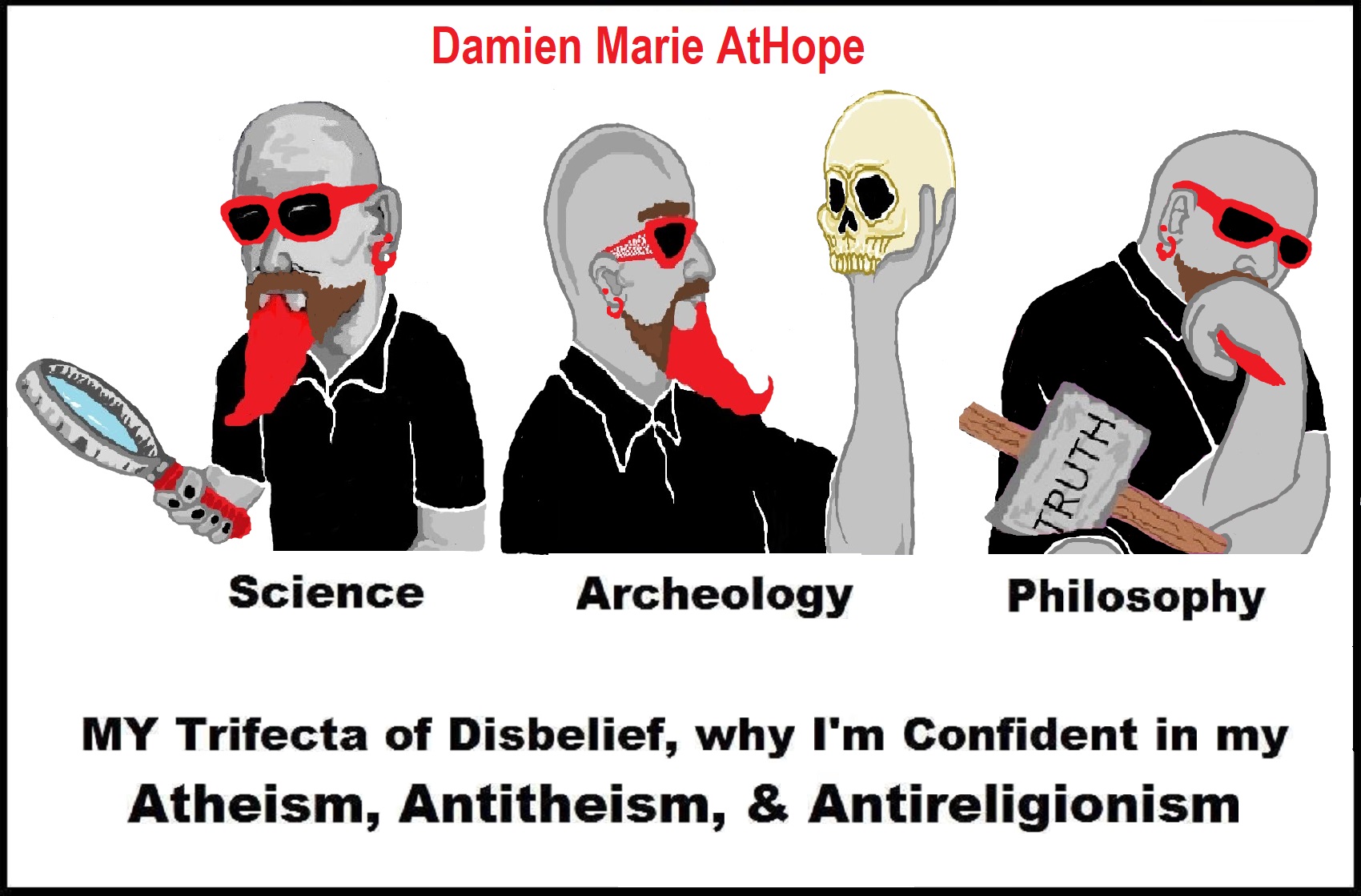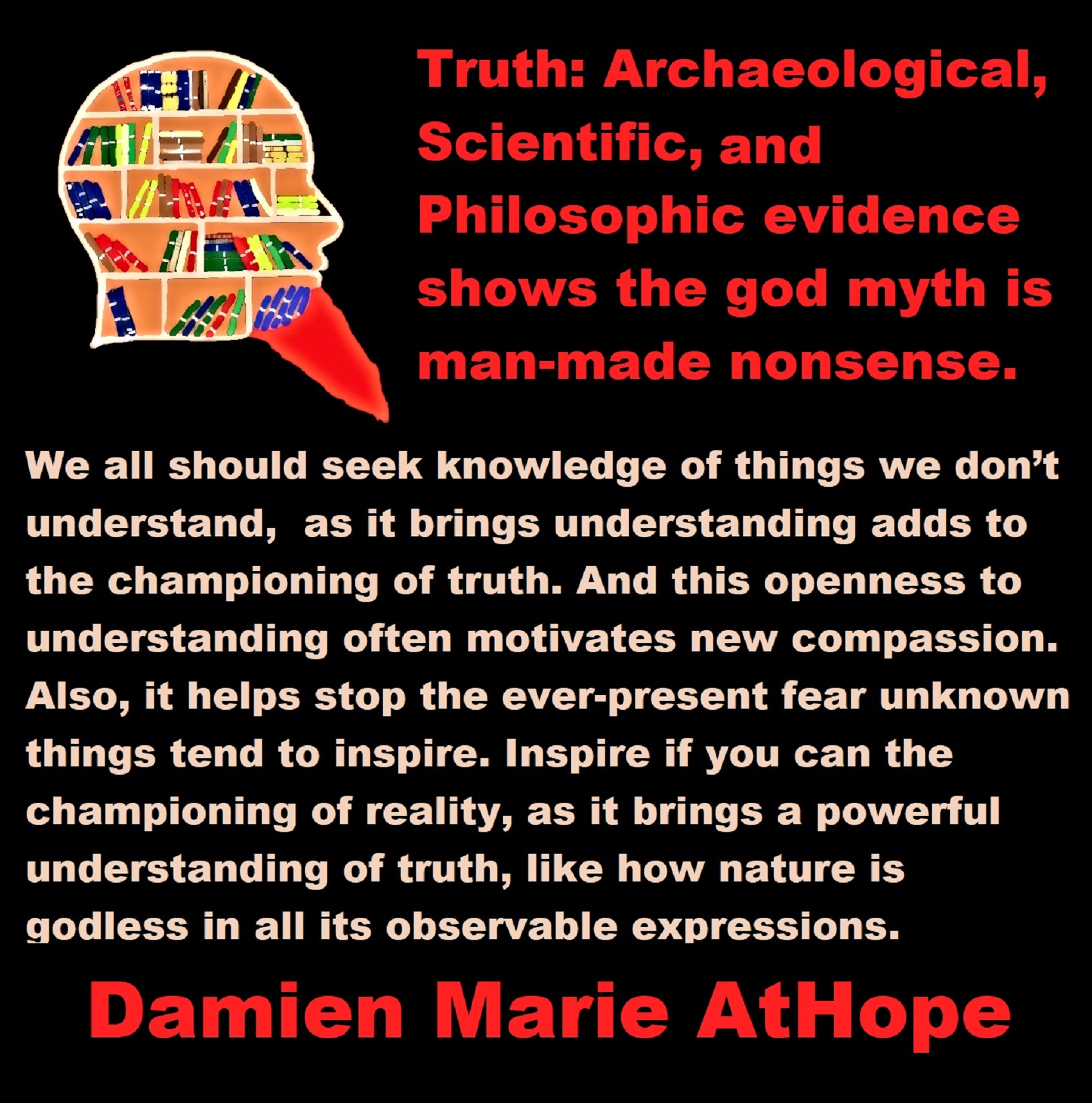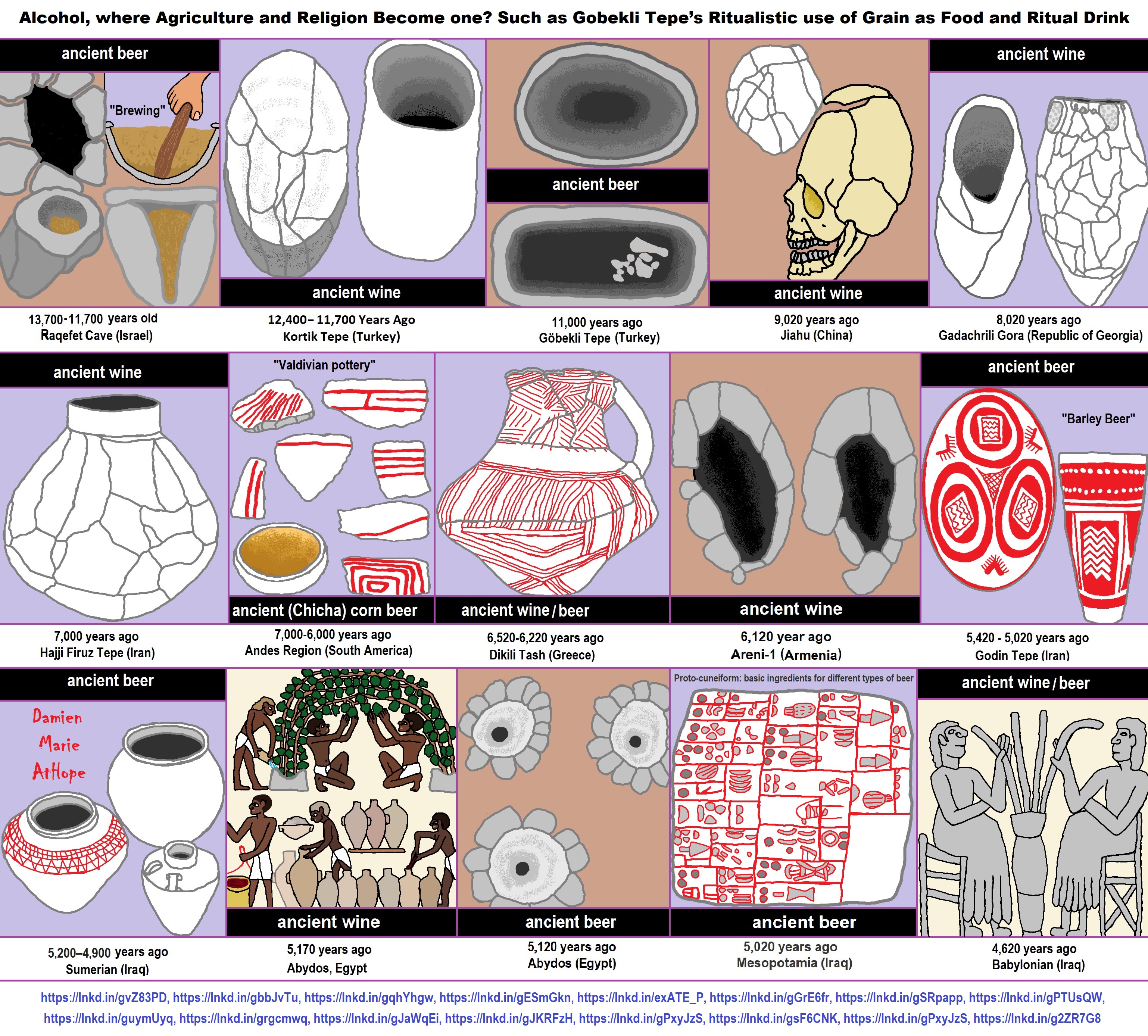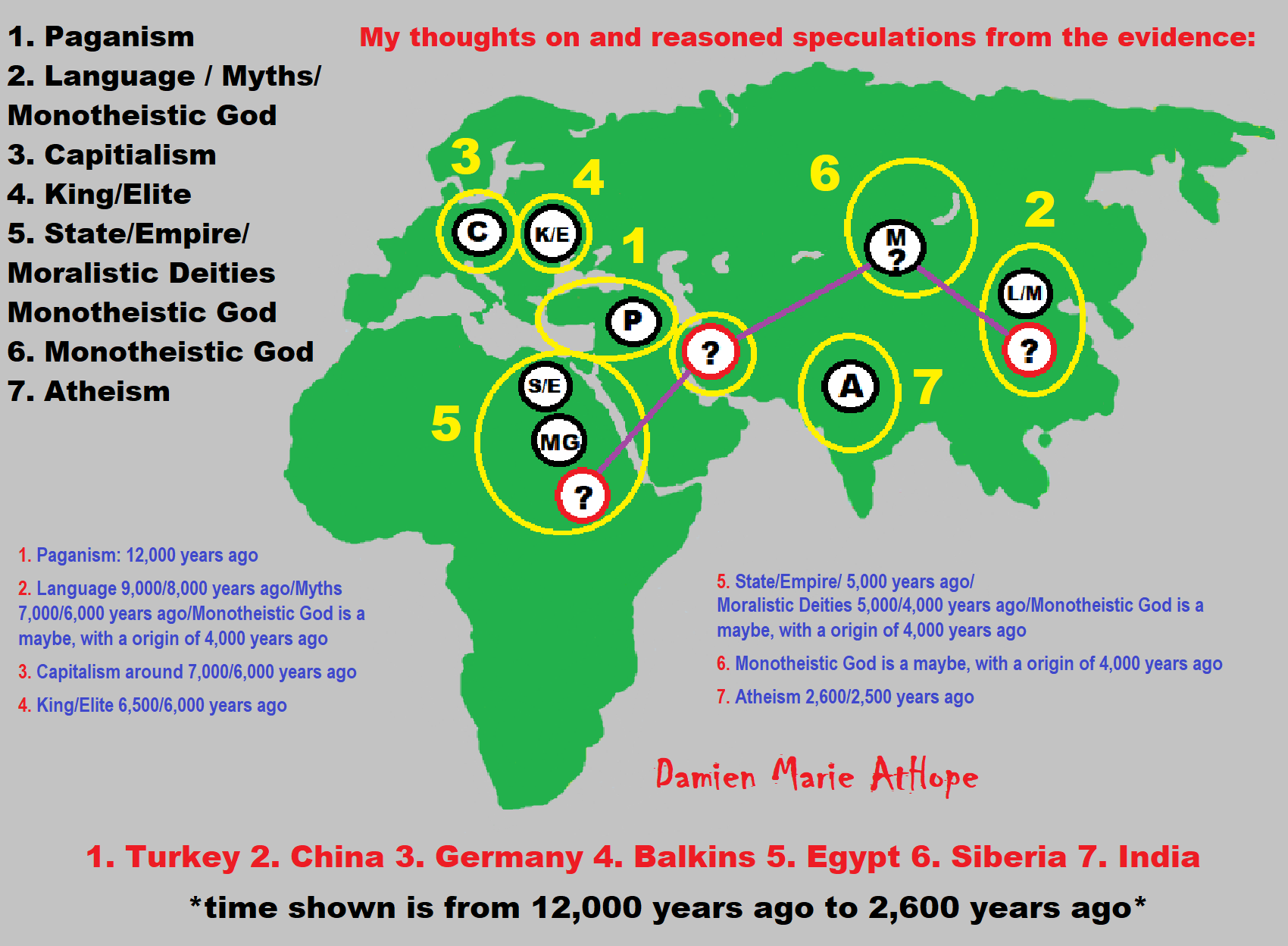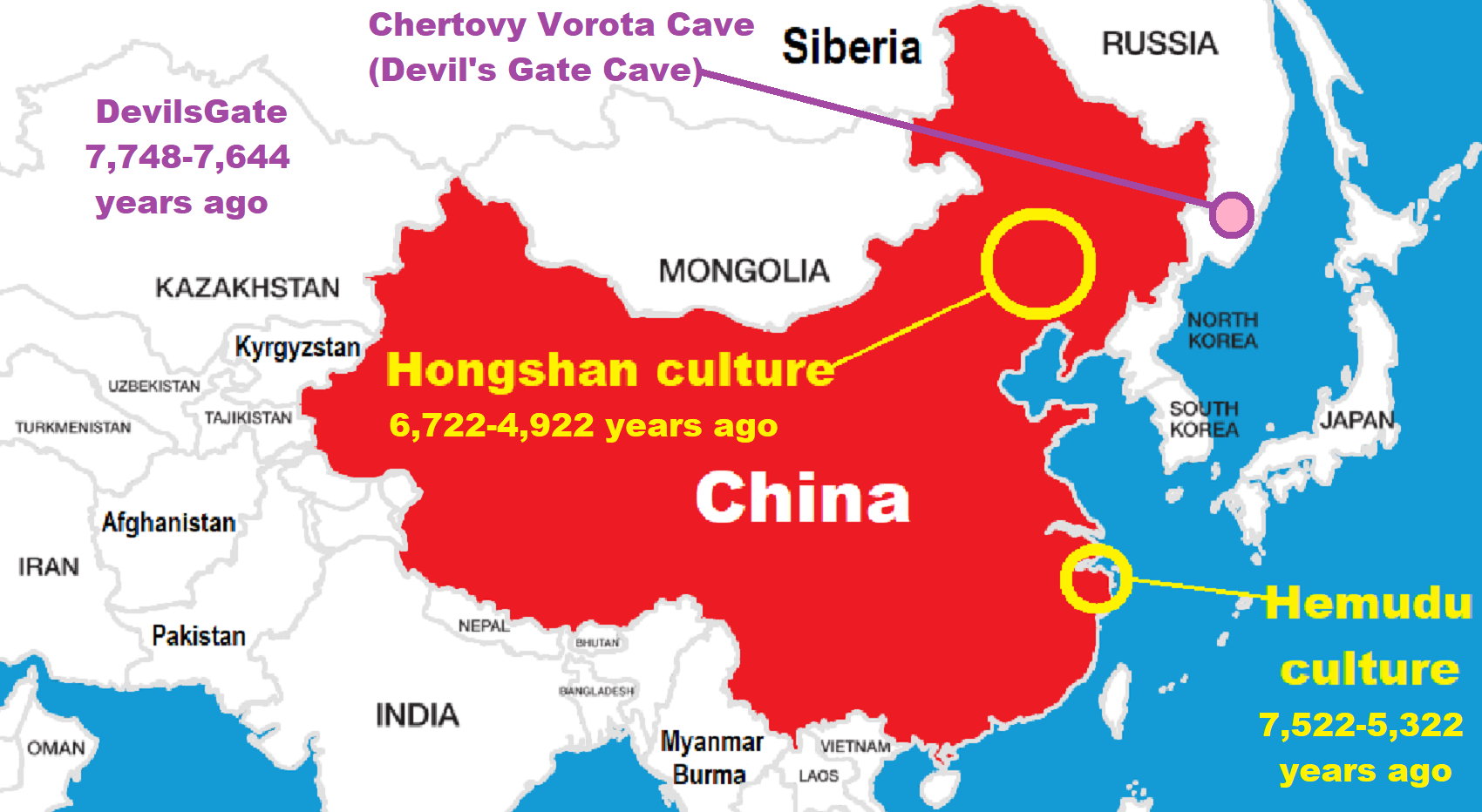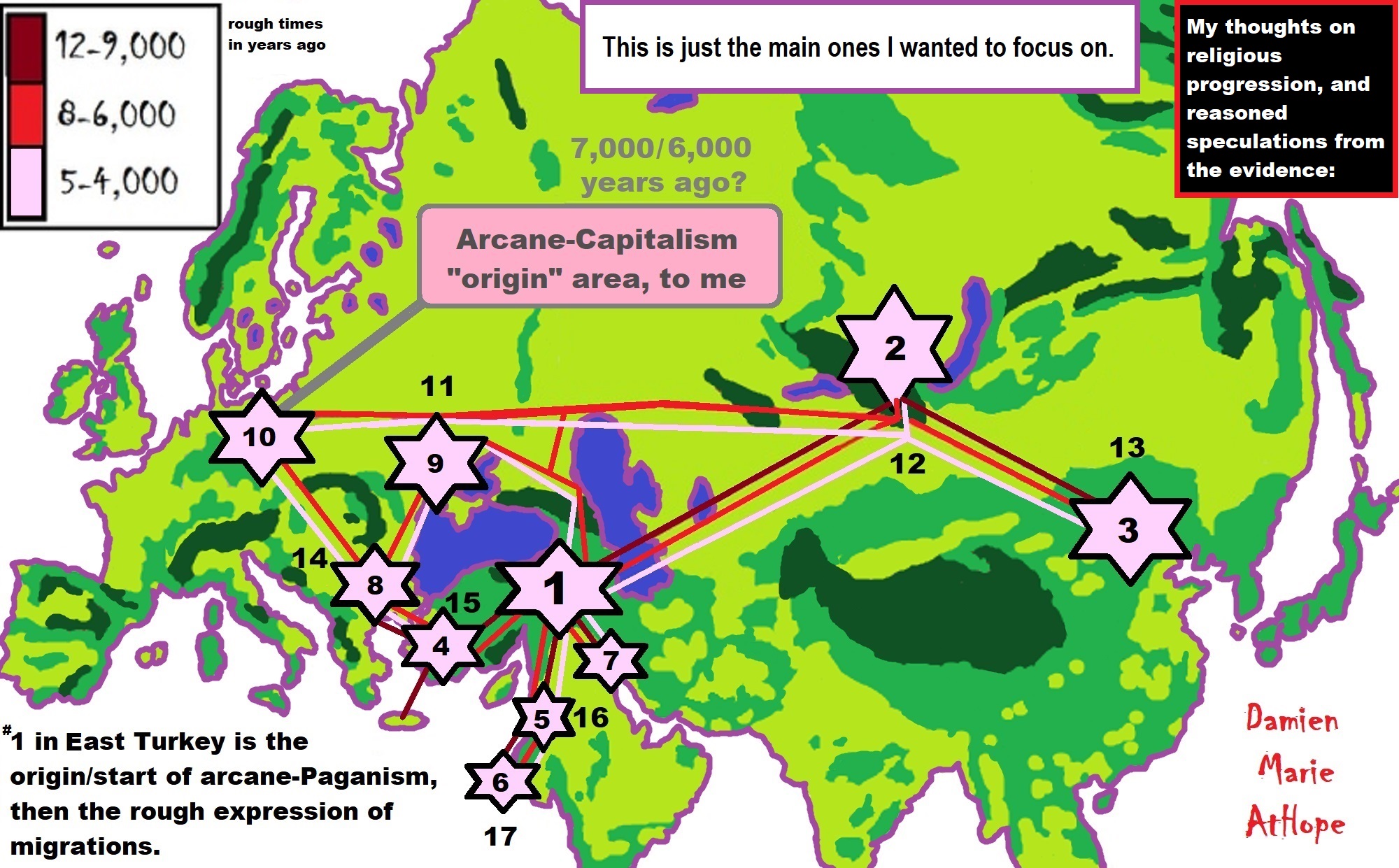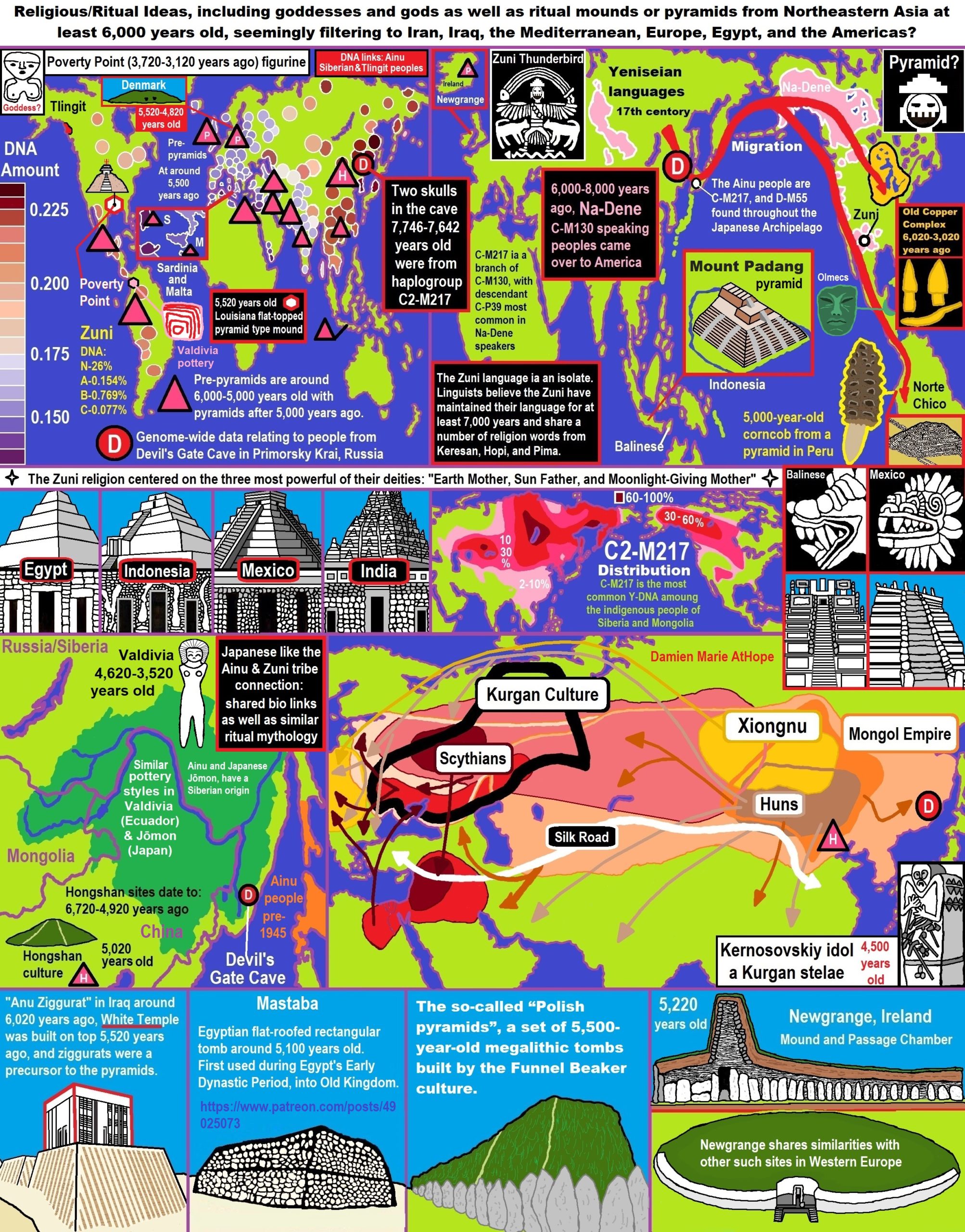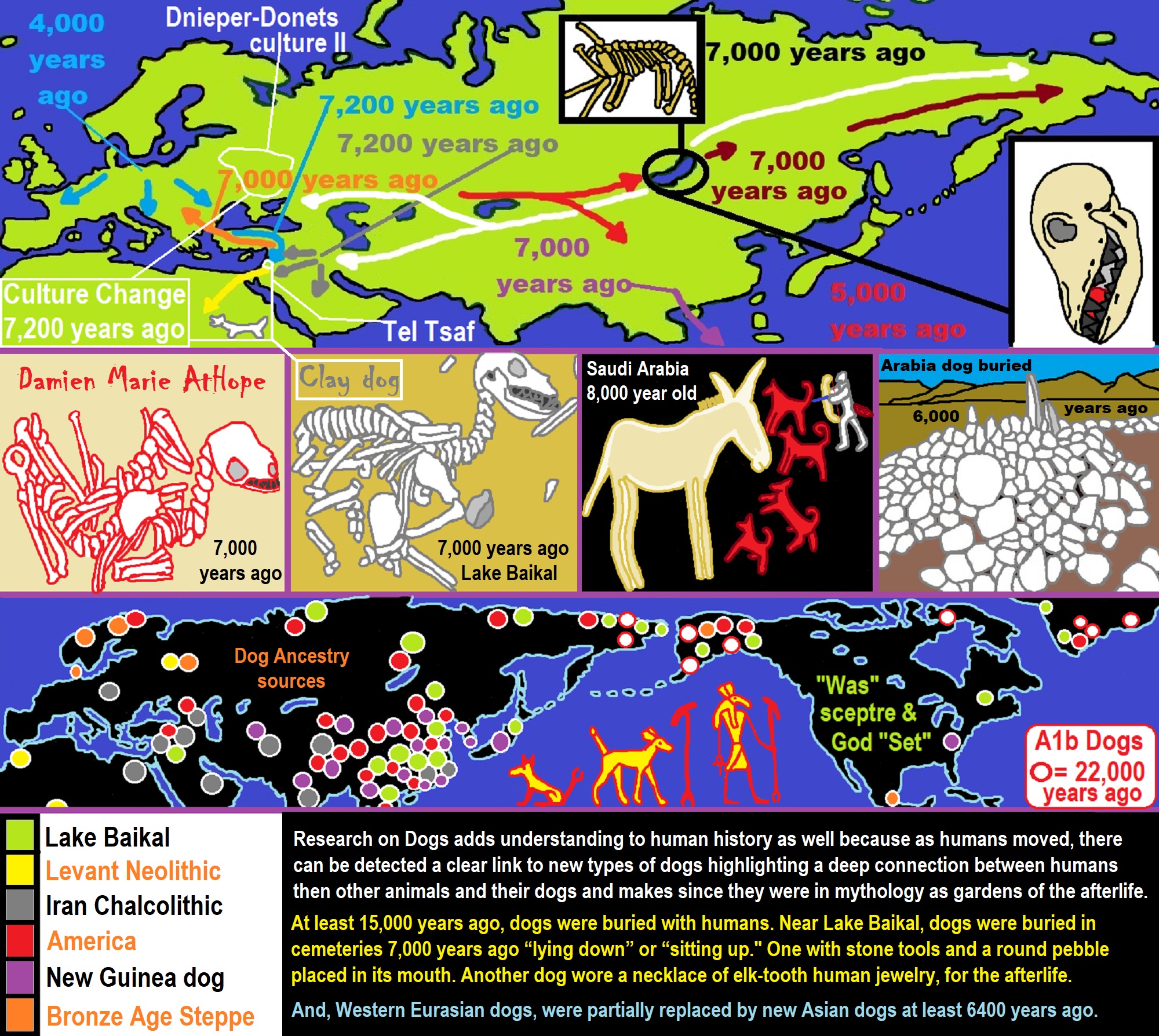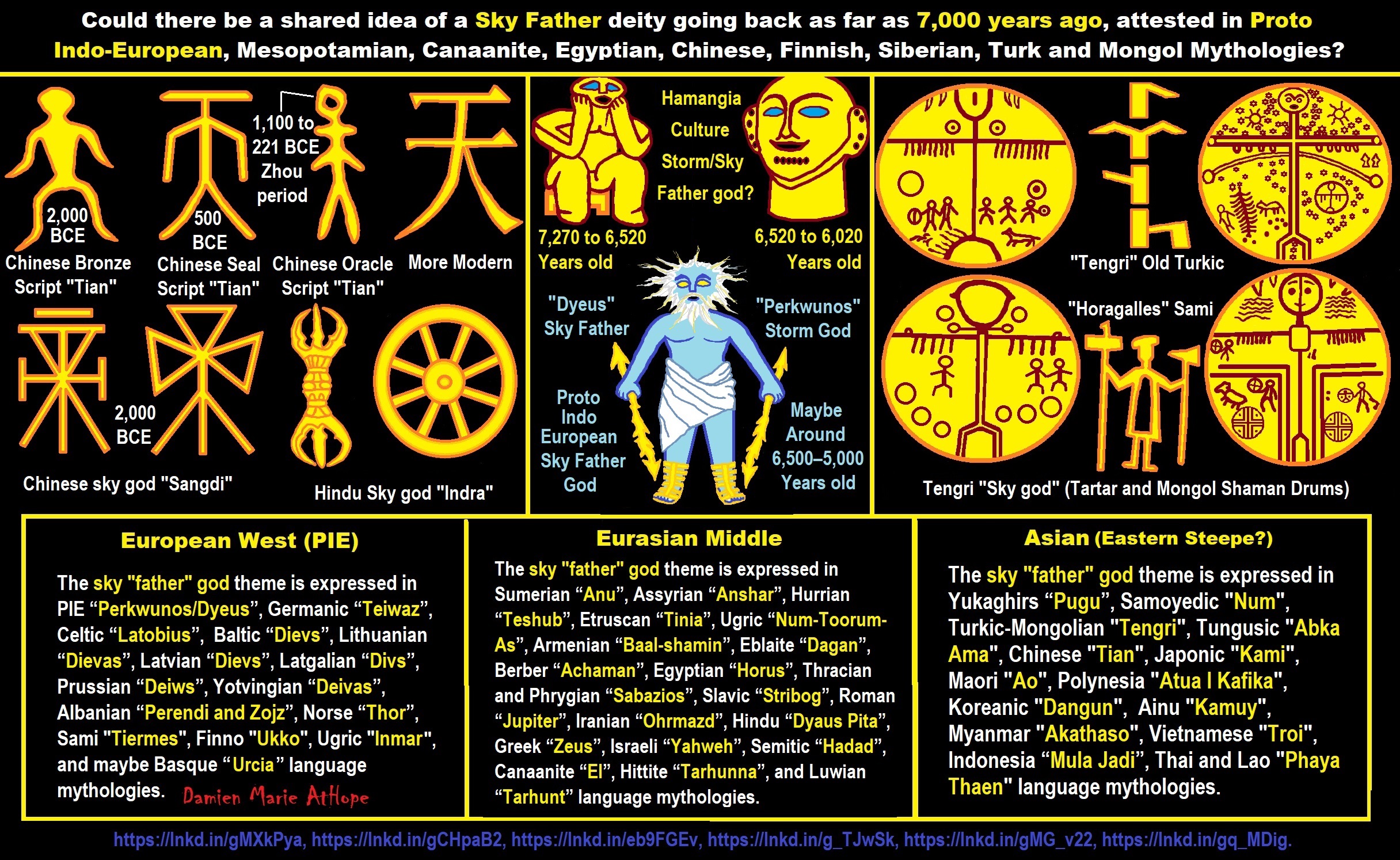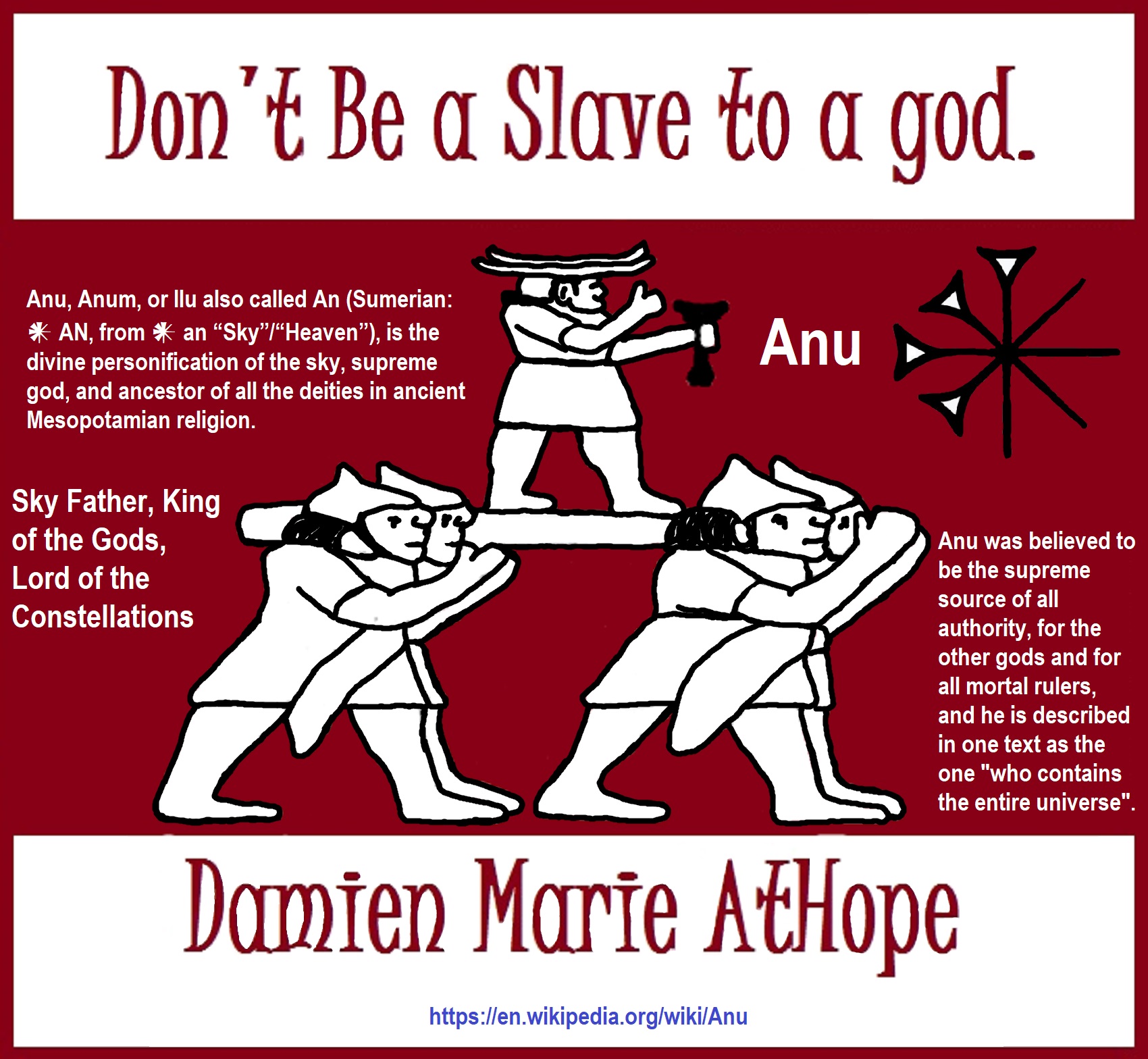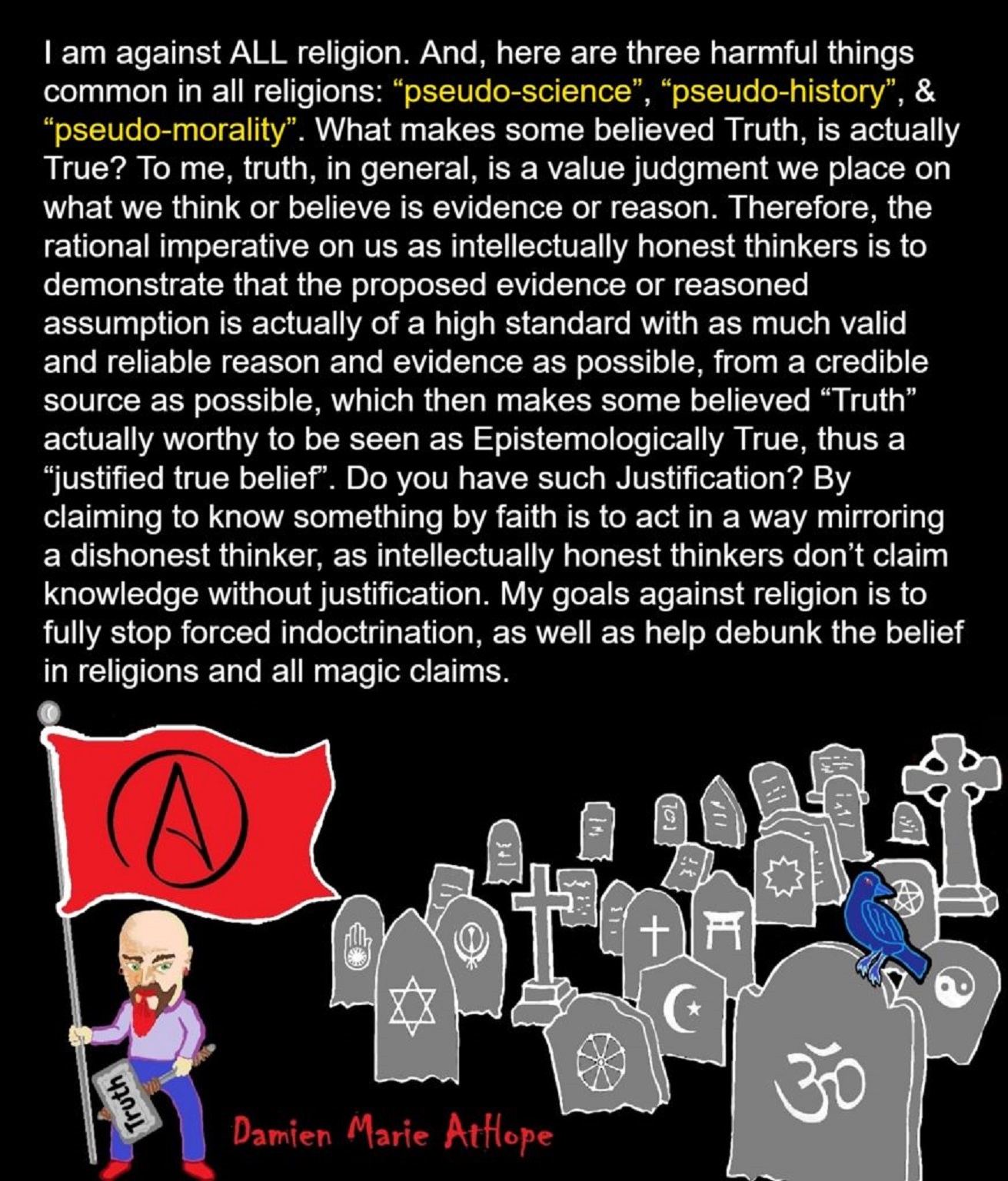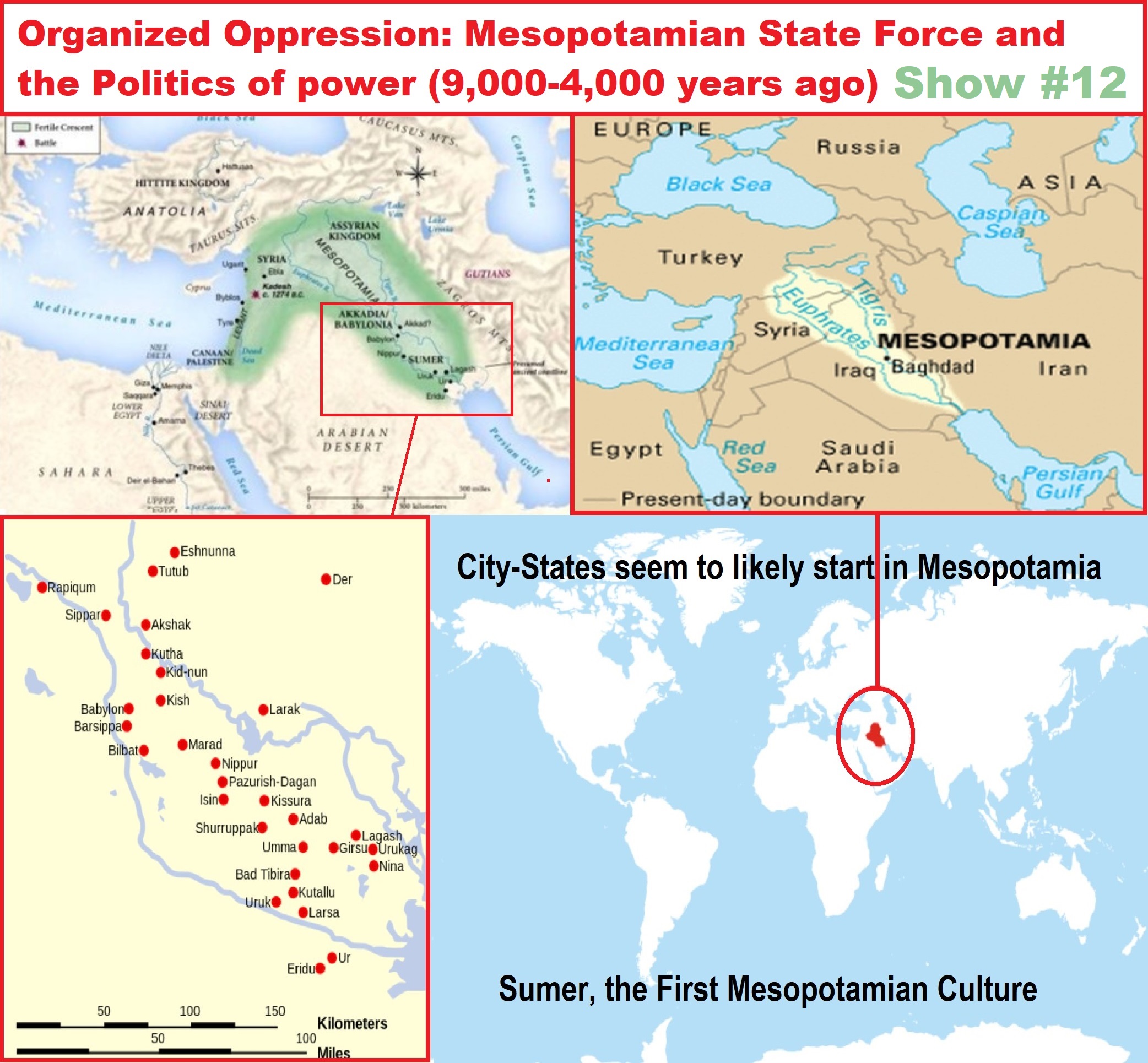
“Mesopotamia is a historical region of Western Asia situated within the Tigris–Euphrates river system, in the northern part of the Fertile Crescent. Mesopotamia occupies most of present-day Iraq and Kuwait. The historical region includes the head of the Persian Gulf and parts of present-day Iran, Syria, and Turkey.” ref
“The Sumerians and Akkadians (including Assyrians and Babylonians) dominated Mesopotamia from the beginning of written history (c. 3100 BCE or 5,121 years ago) to the fall of Babylon in 539 BCE or 2,560 years ago, when it was conquered by the Achaemenid Empire. It fell to Alexander the Great in 332 BCE or 2,353 years ago, and after his death, it became part of the Greek Seleucid Empire. Later the Arameans dominated major parts of Mesopotamia (900 BCE – 270 CE).” ref
“Around 150 BCE or 2,171 years ago, Mesopotamia was under the control of the Parthian Empire. Mesopotamia became a battleground between the Romans and Parthians, with western parts of Mesopotamia coming under ephemeral Roman control. In 226 CE, the eastern regions of Mesopotamia fell to the Sassanid Persians. The division of Mesopotamia between Roman (Byzantine from 395 AD) and Sassanid Empires lasted until the 7th-century Muslim conquest of Persia of the Sasanian Empire and Muslim conquest of the Levant from Byzantines.” ref
“A number of primarily neo-Assyrian and Christian native Mesopotamian states existed between the 1st century BCE and 3rd century BCE, including Adiabene, Osroene, and Hatra. Mesopotamia is the site of the earliest developments of the Neolithic Revolution from around 10,000 BCE or 12,021 years ago. It has been identified as having “inspired some of the most important developments in human history, including the invention of the wheel, the planting of the first cereal crops, and the development of cursive script, mathematics, astronomy, and agriculture“. It has been known as one of the earliest civilizations to ever exist in the world.” ref
City-States seem to likely start in Mesopotamia
“As time went on, many small villages became the first cities, one of them being Eridu, according to the Mesopotamians themselves. Scholars, however, consider Uruk to be the first city in history. Other Sumerian cities include Ur, Lagash, Adab, Kish, Larsa, Nippur, Kullah, and Adab among others.” ref
“In 4000 BCE or 6,021 years ago. came the first villages and the beginning of towns. By 3,500 BCE or 5,521 years ago, the Sumerian city-states began forming, all centered around temples to the gods. By this time, Sumerian people had invented writing, the wheel, irrigation and water control, and sailboats. One of the names for Mesopotamia is the “cradle of civilization,” as the land between the Tigris and Euphrates Rivers was the birthplace of civilization as we know it.” ref
“Sumer’s city-states were first ruled by priest-kings, known as Ensi. As society grew more complex, however, and city-states began battling over land and water rights, a secular kingship began, with the rule of a city-state in the hands of a Lugal, or strong man. The Lugal supervised wars and oversaw important trade with other lands. Trade brought in goods such as metal ores that were unobtainable in Sumer itself. It was probably the necessity of record-keeping in long-distance trade that spurred the development of cuneiform writing.” ref
“While the archeological record reveals the life of common Sumerians, the Sumerian King List provides some detail of Sumer’s kings. The King List, a cuneiform document that lists and briefly describes all the kings of the region beginning with Etana of Kish, who ruled c. 3100 BCE or 5,121 years ago. A scribe in the city of Lagash wrote the document around 2100 BCE or 4,121 years ago at the instigation of a king who wished to legitimate his rule by connecting his name with the known kings and their great deeds.” ref
“Sumer’s city-states warred with each other continually for land, water rights, and other natural resources. One king might create a larger alliance, but no one managed to rule them all until Eannutum of Lagash, who managed to subdue most of the city-states of Sumer under his rule. Lugalzagesi of Umma then held that proto-empire together until he was overthrown by Sargon the Great circa 2234 BCE or 4,255 years ago. Sargon, a Semite rather than a Sumerian, originated from northern Mesopotamia.” ref
“The Akkadian Empire dominated Sumer for the next 150 years. Sumer, however, would rise again during the Sumerian Renaissance of 2047-1750 BCE or 4,068 years ago. Sumer’s civilization provided the world with many firsts: first legal codes, court system, schools, proverbs, moral and ethical ideas, mathematical systems, libraries, bronze, writing, astrological signs, our division of time into hours and minutes and many technological innovations.” ref
Divine right of Kings
“Historically, many Notions of rights have been authoritarian and hierarchical, with different people granted different rights and some having more rights than others. For instance, the right of a father to receive respect from his son did not indicate a right for the son to receive a return from that respect. Analogously, the divine right of kings, which permitted absolute power over subjects, provided few rights for the subjects themselves.” ref
Pre-Christian conceptions of the Divine Right of Kings
Divine Right of Kings and Zoroastrianism (Iranian world)
The Indo-Iranian languages (also Indo-Iranic languages or Aryan languages) constitute the largest and southeasternmost extant branch of the Indo-European language family.
“Khvarenah “Ahura Mazda the god reportedly gives divine kingship to Ardashir.” Khvarenah is an Iranian and Zoroastrian concept, which literally means glory, about the divine right of the kings. This may stem from early Mesopotamian culture, where kings were often regarded as deities after their death. Shulgi of Ur was among the first Mesopotamian rulers to declare himself to be divine. In the Iranian view, kings would never rule, unless Khvarenah is with them, and they will never fall unless Khvarenah leaves them. For example, according to the Kar-namag of Ardashir, when Ardashir I of Persia and Artabanus V of Parthia fought for the throne of Iran, on the road Artabanus and his contingent are overtaken by an enormous ram, which is also following Ardashir. Artabanus’s religious advisors explain to him that the ram is the manifestation of the khwarrah of the ancient Iranian kings, which is leaving Artabanus to join Ardashir.” ref
Roman Empire (Italic languages)
Italic languages form a branch of the Indo-European language family, whose earliest known members were spoken on the Italian Peninsula in the first millennium BCE.
“The Imperial cult of ancient Rome identified Roman emperors and some members of their families with the “divinely sanctioned” authority (auctoritas) of the Roman State. The official offer of cultus to a living emperor acknowledged his office and rule as divinely approved and constitutional: his Principate should therefore demonstrate pious respect for traditional Republican deities and mores. Many of the rites, practices, and status distinctions that characterized the cult to emperors were perpetuated in the theology and politics of the Christianised Empire.” ref
Christian conceptions of the Divine Right of Kings
“In European Christianity, the divine right of kings, divine right, or God’s mandation is a political and religious doctrine of political legitimacy of a monarchy. It stems from a specific metaphysical framework in which a monarch is, before birth, pre-ordained to inherit the crown. According to this theory of political legitimacy, the subjects of the crown have actively (and not merely passively) turned over the metaphysical selection of the king’s soul – which will inhabit the body and rule them – to God. In this way, the “divine right” originates as a metaphysical act of humility and/or submission towards God. The Divine Right has been a key element of the legitimation of many absolute monarchies.” ref
“Significantly, the doctrine asserts that a monarch is not accountable to any earthly authority (such as a parliament) because their right to rule is derived from divine authority. Thus, the monarch is not subject to the will of the people, of the aristocracy, or of any other estate of the realm. It follows that only divine authority can judge a monarch, and that any attempt to depose, dethrone or restrict their powers runs contrary to God’s will and may constitute a sacrilegious act. It is often expressed in the phrase by the Grace of God, which has historically been attached to the titles of certain reigning monarchs. Note, however, that such accountability only to God does not per se make the monarch a sacred king.” ref
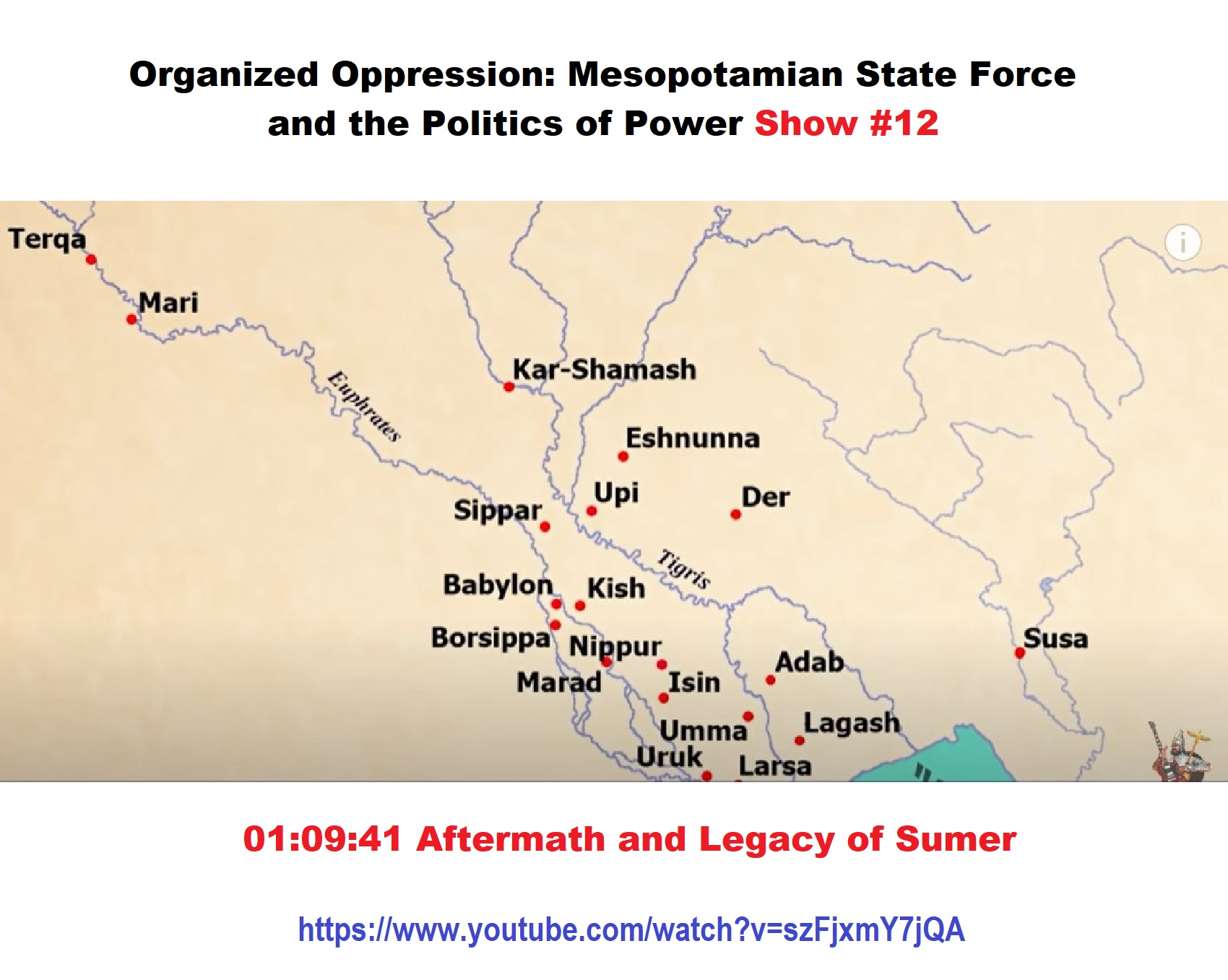
Organized Oppression: Mesopotamian State Force and the Politics of Power Show #12
01:09:41 Aftermath and Legacy of Sumer Video Used
This series idea was addressed in, Anarchist Teaching as Free Public Education or Free Education in the Public: VIDEO
Our 12 video series: Organized Oppression: Mesopotamian State Force and the Politics of power (9,000-4,000 years ago), is adapted from: The Complete and Concise History of the Sumerians and Early Bronze Age Mesopotamia (7000-2000 BC): https://www.youtube.com/watch?v=szFjxmY7jQA by “History with Cy“
Show #1: Mesopotamian State Force and the Politics of Power (Samarra, Halaf, Ubaid)
Show #2: Mesopotamian State Force and the Politics of Power
Show #3: Mesopotamian State Force and the Politics of Power (Uruk and the First Cities)
Show #4: Mesopotamian State Force and the Politics of Power (First Kings)
Show #5: Mesopotamian State Force and the Politics of Power (Early Dynastic Period)
Show #6: Mesopotamian State Force and the Politics of Power
Show #7: Mesopotamian State Force and the Politics of Power (Sargon and Akkadian Rule)
Show #9: Mesopotamian State Force and the Politics of Power (Gudea of Lagash and Utu-hegal)
Show #12: Mesopotamian State Force and the Politics of Power (Aftermath and Legacy of Sumer)
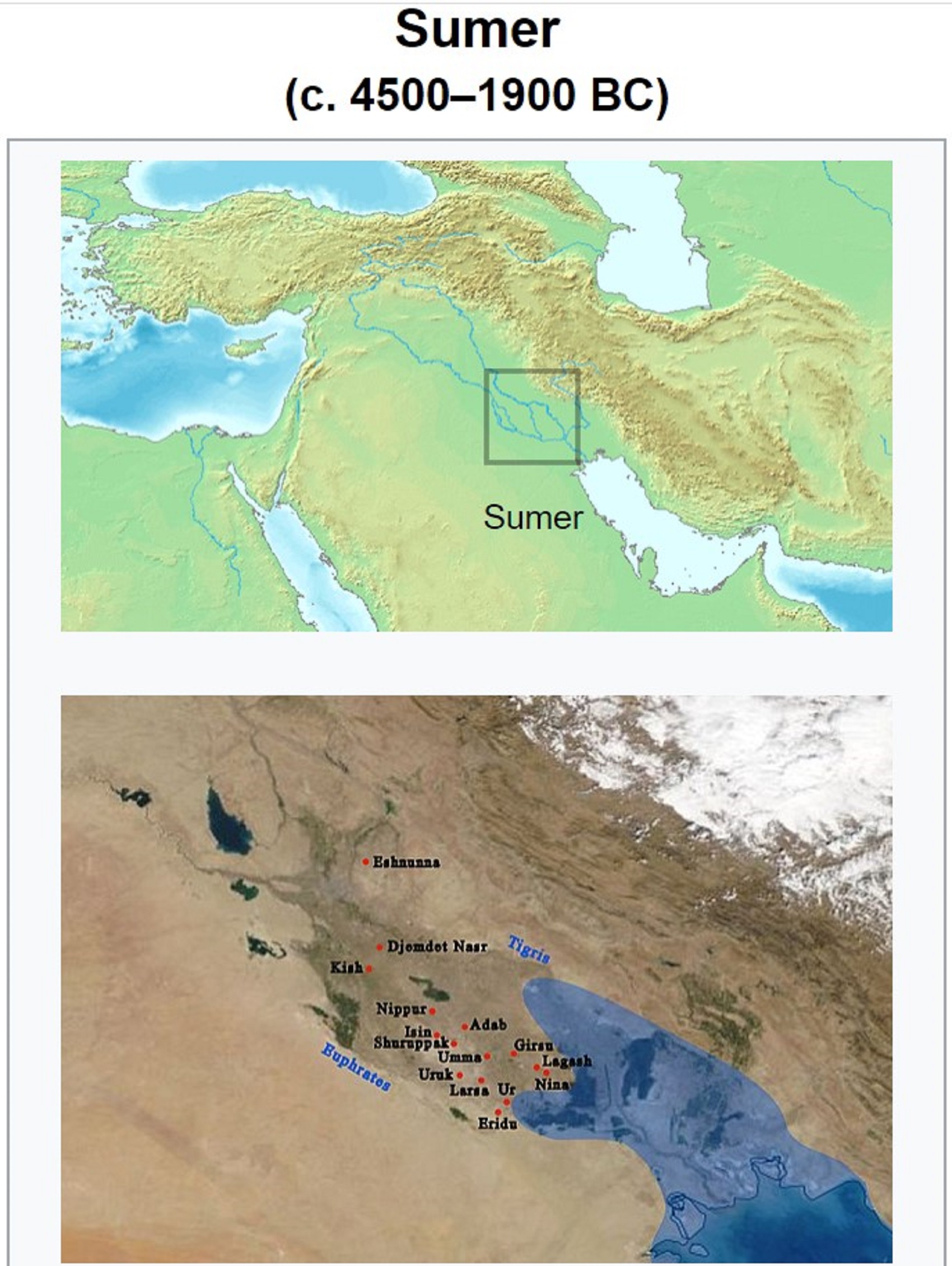
Pic ref
Sumer (c. 4500–1900 BCE or 6,522-3,922 years ago)
“Sumer (/ˈsuːmər/) is the earliest known civilization in the historical region of southern Mesopotamia (south-central Iraq), emerging during the Chalcolithic and early Bronze Ages between the sixth and fifth millennium BCE. It is also one of the first civilizations in the world, along with ancient Egypt, Elam, the Caral-Supe civilization, the Indus Valley Civilisation, the Minoan civilization, and ancient China. Living along the valleys of the Tigris and Euphrates, Sumerian farmers grew an abundance of grain and other crops, the surplus from which enabled them to form urban settlements. Proto-writing dates back before 3000 BCE. The earliest texts come from the cities of Uruk and Jemdet Nasr, and date to between c. 3500 to 3000 BCE.” ref
“The term “Sumer” (Sumerian: ???????? eme-gi or ???????? eme-ĝir15, Akkadian: ???????????? šumeru) is the name given to the language spoken by the “Sumerians”, the ancient non-Semitic-speaking inhabitants of southern Mesopotamia, by their successors the East Semitic-speaking Akkadians. The Sumerians themselves referred to their land as Kengir, the ‘Country of the noble lords’ (????????????, k-en-gi(-r), lit. ‘country’ + ‘lords’ + ‘noble’) as seen in their inscriptions.” ref
“The origin of the Sumerians is not known, but the people of Sumer referred to themselves as “Black Headed Ones” or “Black-Headed People” (???? ????, saĝ-gíg, lit. ‘head’ + ‘black’, or ???? ???? ????, saĝ-gíg-ga phonetically /saŋ ɡi ɡa/, lit. ‘head’ + ‘black’ + ‘carry’). For example, the Sumerian king Shulgi described himself as “the king of the four quarters, the pastor of the black-headed people”. The Akkadians also called the Sumerians ‘black-headed people’, or ṣalmat-qaqqadi, in the Semitic Akkadian language. The Akkadian word Šumer may represent the geographical name in dialect, but the phonological development leading to the Akkadian term šumerû is uncertain. Hebrew שִׁנְעָר Šinʿar, Egyptian Sngr, and Hittite Šanhar(a), all referring to southern Mesopotamia, could be western variants of Sumer.” ref
Sumerian Origins
“Most historians have suggested that Sumer was first permanently settled between c. 5500 to 4000 BCE by a West Asian people who spoke the Sumerian language (pointing to the names of cities, rivers, basic occupations, etc., as evidence), a non-Semitic and non-Indo-European agglutinative language isolate. In contrast to its Semitic neighbors, it was not an inflected language.” ref
“Others have suggested that the Sumerians were a North African people who migrated from the Green Sahara into the Middle East and were responsible for the spread of farming in the Middle East. However, with evidence strongly suggesting the first farmers originated from the Fertile Crescent, this suggestion is often discarded. Although not specifically discussing Sumerians, Lazaridis et al. 2016 have suggested a partial North African origin for some pre-Semitic cultures of the Middle East, particularly Natufians, after testing the genomes of Natufian and Pre-Pottery Neolithic culture-bearers. Alternatively, a recent (2013) genetic analysis of four ancient Mesopotamian skeletal DNA samples suggests an association of the Sumerians with Indus Valley Civilization, possibly as a result of ancient Indus-Mesopotamia relations. According to some data, the Sumerians are associated with the Hurrians and Urartians, and the Caucasus is considered their homeland.” ref
“A prehistoric people who lived in the region before the Sumerians have been termed the “Proto-Euphrateans” or “Ubaidians“, and are theorized to have evolved from the Samarra culture of northern Mesopotamia. The Ubaidians, though never mentioned by the Sumerians themselves, are assumed by modern-day scholars to have been the first civilizing force in Sumer. They drained the marshes for agriculture, developed trade, and established industries, including weaving, leatherwork, metalwork, masonry, and pottery.” ref
“Some scholars contest the idea of a Proto-Euphratean language or one substrate language; they think the Sumerian language may originally have been that of the hunting and fishing peoples who lived in the marshland and the Eastern Arabia littoral region and were part of the Arabian bifacial culture. Reliable historical records begin much later; there are none in Sumer of any kind that have been dated before Enmebaragesi (Early Dynastic I). Juris Zarins believes the Sumerians lived along the coast of Eastern Arabia, today’s Persian Gulf region, before it was flooded at the end of the Ice Age.” ref
“Sumerian civilization took form in the Uruk period (4th millennium BCE), continuing into the Jemdet Nasr and Early Dynastic periods. The Sumerians progressively lost control to Semitic states from the northwest. Sumer was conquered by the Semitic-speaking kings of the Akkadian Empire around 2270 BCE (short chronology), but Sumerian continued as a sacred language. Native Sumerian rule re-emerged for about a century in the Third Dynasty of Ur at approximately 2100–2000 BCE, but the Akkadian language also remained in use for some time.” ref
“The Sumerian city of Eridu, on the coast of the Persian Gulf, is considered to have been one of the oldest cities, where three separate cultures may have fused: that of peasant Ubaidian farmers, living in mud-brick huts and practicing irrigation; that of mobile nomadic Semitic pastoralists living in black tents and following herds of sheep and goats; and that of fisher folk, living in reed huts in the marshlands, who may have been the ancestors of the Sumerians.” ref
City-states in Mesopotamia
Further information: List of cities of the ancient Near East and Geography of Mesopotamia
“In the late 4th millennium BC, Sumer was divided into many independent city-states, which were divided by canals and boundary stones. Each was centered on a temple dedicated to the particular patron god or goddess of the city and ruled over by a priestly governor (ensi) or by a king (lugal) who was intimately tied to the city’s religious rites.” ref
“The five “first” cities, said to have exercised pre-dynastic kingship “before the flood”:
- Eridu (Tell Abu Shahrain)
- Bad-tibira (probably Tell al-Madain)
- Larak 1
- Sippar (Tell Abu Habbah)
- Shuruppak (Tell Fara)
Other principal cities:
- Uruk (Warka)
- Kish (Tell Uheimir and Ingharra)
- Ur (Tell al-Muqayyar)
- Nippur (Afak)
- Lagash (Tell al-Hiba)
- Girsu (Tello or Telloh)
- Umma (Tell Jokha)
- Hamazi 1
- Adab (Tell Bismaya)
- Mari (Tell Hariri) 2
- Akshak 1
- Akkad 1
- Isin (Ishan al-Bahriyat)
- Larsa (Tell as-Senkereh)
- (1 location uncertain)
- (2 an outlying city in northern Mesopotamia)
Minor cities (from south to north):
- Kuara (Tell al-Lahm)
- Zabala (Tell Ibzeikh)
- Kisurra (Tell Abu Hatab)
- Marad (Tell Wannat es-Sadum)
- Dilbat (Tell ed-Duleim)
- Borsippa (Birs Nimrud)
- Kutha (Tell Ibrahim)
- Der (al-Badra)
- Eshnunna (Tell Asmar)
- Nagar (Tell Brak) 2
(2 an outlying city in northern Mesopotamia)” ref
“Apart from Mari, which lies full 330 kilometers (205 miles) north-west of Agade, but which is credited in the king list as having “exercised kingship” in the Early Dynastic II period, and Nagar, an outpost, these cities are all in the Euphrates-Tigris alluvial plain, south of Baghdad in what are now the Bābil, Diyala, Wāsit, Dhi Qar, Basra, Al-Muthannā and Al-Qādisiyyah governorates of Iraq.” ref
“The Sumerian city-states rose to power during the prehistoric Ubaid and Uruk periods. Sumerian written history reaches back to the 27th century BCE and before, but the historical record remains obscure until the Early Dynastic III period, c. 23rd century BCE, when a now deciphered syllabary writing system was developed, which has allowed archaeologists to read contemporary records and inscriptions. The Akkadian Empire was the first state that successfully united larger parts of Mesopotamia in the 23rd century BC. After the Gutian period, the Ur III kingdom similarly united parts of northern and southern Mesopotamia. It ended in the face of Amorite incursions at the beginning of the second millennium BCE. The Amorite “dynasty of Isin” persisted until c. 1700 BCE, when Mesopotamia was united under Babylonian rule. The Sumerians were eventually absorbed into the Akkadian (Assyro-Babylonian) population.” ref
- “Ubaid period: 6500–4100 BCE (Pottery Neolithic to Chalcolithic)
- Uruk period: 4100–2900 BCE (Late Chalcolithic to Early Bronze Age I)Uruk XIV–V: 4100–3300 BCE
Uruk IV period: 3300–3100 BCE
Jemdet Nasr period (Uruk III): 3100–2900 BCE - Early Dynastic period (Early Bronze Age II–IV)Early Dynastic I period: 2900–2800 BCE
Early Dynastic II period: 2800–2600 BCE (Gilgamesh)
Early Dynastic IIIa period: 2600–2500 BCE
Early Dynastic IIIb period: c. 2500–2334 BCE - Akkadian Empire period: c. 2334–2218 BCE (Sargon)
- Gutian period: c. 2218–2047 BCE (Early Bronze Age IV)
- Ur III period: c. 2047–1940 BCE” ref
Sumer’s Fall and transmission
“This period is generally taken to coincide with a major shift in population from southern Mesopotamia toward the north. Ecologically, the agricultural productivity of the Sumerian lands was being compromised as a result of rising salinity. Soil salinity in this region had been long recognized as a major problem. Poorly drained irrigated soils, in an arid climate with high levels of evaporation, led to the buildup of dissolved salts in the soil, eventually reducing agricultural yields severely.” ref
“During the Akkadian and Ur III phases, there was a shift from the cultivation of wheat to the more salt-tolerant barley, but this was insufficient, and during the period from 2100 to 1700 BCE, it is estimated that the population in this area declined by nearly three-fifths. This greatly upset the balance of power within the region, weakening the areas where Sumerian was spoken, and comparatively strengthening those where Akkadian was the major language. Henceforth, Sumerian would remain only a literary and liturgical language, similar to the position occupied by Latin in medieval Europe.” ref
“Following an Elamite invasion and sack of Ur during the rule of Ibbi-Sin (c. 2028–2004 BCE), Sumer came under Amorite rule (taken to introduce the Middle Bronze Age). The independent Amorite states of the 20th to 18th centuries are summarized as the “Dynasty of Isin” in the Sumerian king list, ending with the rise of Babylonia under Hammurabi c. 1800 BCE. Later rulers who dominated Assyria and Babylonia occasionally assumed the old Sargonic title “King of Sumer and Akkad”, such as Tukulti-Ninurta I of Assyria after c. 1225 BCE.” ref
Sumer’s Population
“Uruk, one of Sumer’s largest cities, has been estimated to have had a population of 50,000–80,000 at its height; given the other cities in Sumer, and the large agricultural population, a rough estimate for Sumer’s population might be 0.8 million to 1.5 million. The world population at this time has been estimated at about 27 million.” ref
“The Sumerians spoke a language isolate, but a number of linguists have claimed to be able to detect a substrate language of unknown classification beneath Sumerian because names of some of Sumer’s major cities are not Sumerian, revealing influences of earlier inhabitants. However, the archaeological record shows clear uninterrupted cultural continuity from the time of the early Ubaid period (5300–4700 BCE C-14) settlements in southern Mesopotamia. The Sumerian people who settled here farmed the lands in this region that were made fertile by silt deposited by the Tigris and the Euphrates.” ref
“Some archaeologists have speculated that the original speakers of ancient Sumerian may have been farmers, who moved down from the north of Mesopotamia after perfecting irrigation agriculture there. The Ubaid period pottery of southern Mesopotamia has been connected via Choga Mami transitional ware to the pottery of the Samarra period culture (c. 5700–4900 BCE C-14) in the north, who were the first to practice a primitive form of irrigation agriculture along the middle Tigris River and its tributaries. The connection is most clearly seen at Tell el-‘Oueili near Larsa, excavated by the French in the 1980s, where eight levels yielded pre-Ubaid pottery resembling Samarran ware. According to this theory, farming peoples spread down into southern Mesopotamia because they had developed a temple-centered social organization for mobilizing labor and technology for water control, enabling them to survive and prosper in a difficult environment.” ref
“Others have suggested a continuity of Sumerians, from the indigenous hunter-fisherfolk traditions, associated with the bifacial assemblages found on the Arabian littoral. Juris Zarins believes the Sumerians may have been the people living in the Persian Gulf region before it flooded at the end of the last Ice Age.” ref
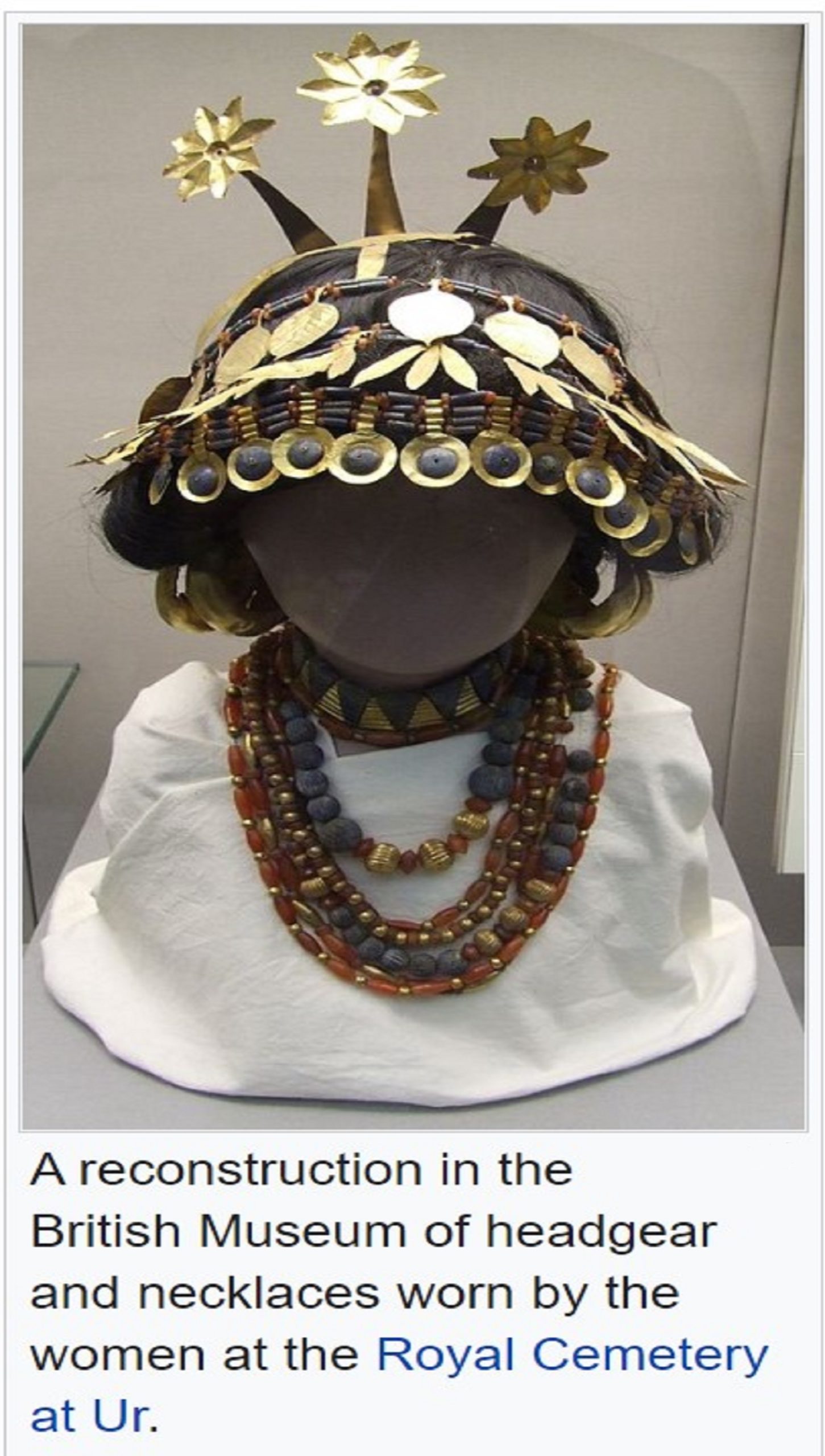
Pic ref
Social and family life in Sumer
In the early Sumerian period, the primitive pictograms suggest that
- “Pottery was very plentiful, and the forms of the vases, bowls, and dishes were manifold; there were special jars for honey, butter, oil, and wine, which was probably made from dates. Some of the vases had pointed feet, and stood on stands with crossed legs; others were flat-bottomed, and were set on square or rectangular frames of wood. The oil-jars, and probably others also, were sealed with clay, precisely as in early Egypt. Vases and dishes of stone were made in imitation of those of clay.”
- “A feathered head-dress was worn. Beds, stools, and chairs were used, with carved legs resembling those of an ox. There were fire-places and fire-altars.”
- “Knives, drills, wedges, and an instrument that looks like a saw were all known. While spears, bows, arrows, and daggers (but not swords) were employed in war.”
- “Tablets were used for writing purposes. Daggers with metal blades and wooden handles were worn, and copper was hammered into plates, while necklaces or collars were made of gold.”
- “Time was reckoned in lunar months.” ref
“There is considerable evidence concerning Sumerian music. Lyres and flutes were played, among the best-known examples being the Lyres of Ur. Inscriptions describing the reforms of king Urukagina of Lagash (c. 2350 BCE) say that he abolished the former custom of polyandry in his country, prescribing that a woman who took multiple husbands be stoned with rocks upon which her crime had been written.” ref
“Sumerian culture was male-dominated and stratified. The Code of Ur-Nammu, the oldest such codification yet discovered, dating to the Ur III, reveals a glimpse at a societal structure in late Sumerian law. Beneath the lu-gal (“great man” or king), all members of society belonged to one of two basic strata: The “lu” or free person, and the slave (male, arad; female geme). The son of a lu was called a dumu-nita until he married. A woman (munus) went from being a daughter (dumu-mi), to a wife (dam), then if she outlived her husband, a widow (numasu) and she could then remarry another man who was from the same tribe.” ref
“Marriages were usually arranged by the parents of the bride and groom; engagements were usually completed through the approval of contracts recorded on clay tablets. These marriages became legal as soon as the groom delivered a bridal gift to his bride’s father. One Sumerian proverb describes the ideal, happy marriage through the mouth of a husband who boasts that his wife has borne him eight sons and is still eager to have sex.” ref
“The Sumerians generally seem to have discouraged premarital sex. Neither Sumerians nor Akkadians had a word exactly corresponding to the English word ‘virginity‘, and the concept was expressed descriptively, for example as a/é-nu-gi4-a (Sum.)/la naqbat (Akk.) ‘un-deflowered’, or giš nunzua, ‘never having known a penis’. It is unclear whether terms such as šišitu in Akkadian medical texts indicate the hymen, but it appears that the intactness of the hymen was much less relevant to assessing a woman’s virginity than in later cultures of the Near East, and most assessments of virginity depended on the woman’s own account.” ref
“From the earliest records, the Sumerians had very relaxed attitudes toward sex and their sexual mores were determined not by whether a sexual act was deemed immoral, but rather by whether or not it made a person ritually unclean. The Sumerians widely believed that masturbation enhanced sexual potency, both for men and for women, and they frequently engaged in it, both alone and with their partners. The Sumerians did not regard anal sex as taboo either. Entu priestesses were forbidden from producing offspring and frequently engaged in anal sex as a method of birth control. Prostitution existed but it is not clear if sacred prostitution did.” ref
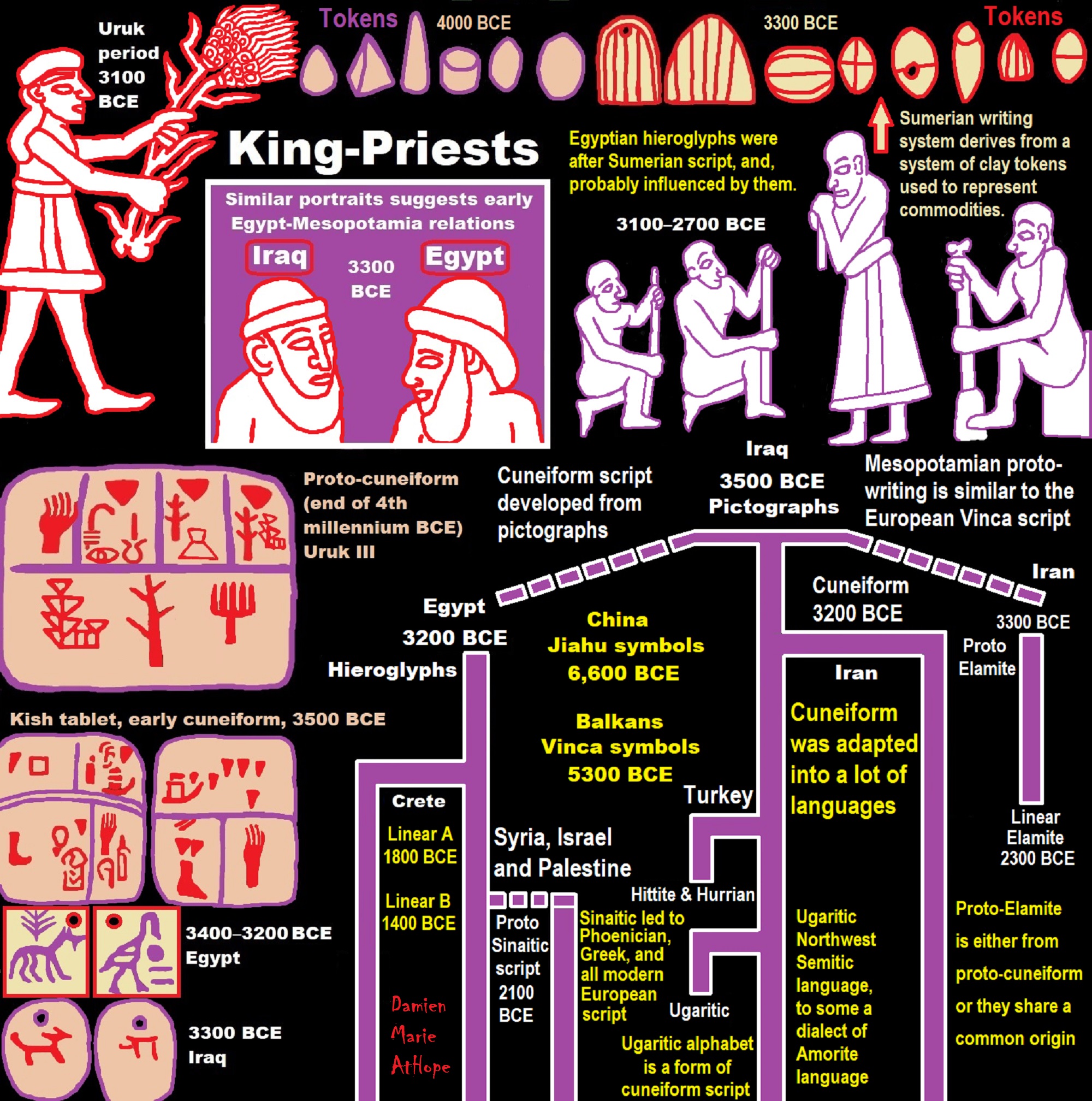

Pic ref
Language and writing
History of writing, Sumerian language, and Cuneiform
“The most important archaeological discoveries in Sumer are a large number of clay tablets written in cuneiform script. Sumerian writing is considered to be a great milestone in the development of humanity’s ability to not only create historical records but also in creating pieces of literature, both in the form of poetic epics and stories as well as prayers and laws. Although pictures—that is, hieroglyphs—were used first, cuneiform and then ideograms (where symbols were made to represent ideas) soon followed.” ref
“Triangular or wedge-shaped reeds were used to write on moist clay. A large body of hundreds of thousands of texts in the Sumerian language have survived, including personal and business letters, receipts, lexical lists, laws, hymns, prayers, stories, and daily records. Full libraries of clay tablets have been found. Monumental inscriptions and texts on different objects, like statues or bricks, are also very common. Many texts survive in multiple copies because they were repeatedly transcribed by scribes in training. Sumerian continued to be the language of religion and law in Mesopotamia long after Semitic speakers had become dominant.” ref
“A prime example of cuneiform writing would be a lengthy poem that was discovered in the ruins of Uruk. The Epic of Gilgamesh was written in the standard Sumerian cuneiform. It tells of a king from the Early Dynastic II period named Gilgamesh or “Bilgamesh” in Sumerian. The story relates to the fictional adventures of Gilgamesh and his companion, Enkidu. It was laid out on several clay tablets and is thought to be the earliest known surviving example of fictional literature.” ref
“The Sumerian language is generally regarded as a language isolate in linguistics because it belongs to no known language family; Akkadian, by contrast, belongs to the Semitic branch of the Afroasiatic languages. There have been many failed attempts to connect Sumerian to other language families. It is an agglutinative language; in other words, morphemes (“units of meaning”) are added together to create words, unlike analytic languages where morphemes are purely added together to create sentences. Some authors have proposed that there may be evidence of a substratum or adstratum language for geographic features and various crafts and agricultural activities, called variously Proto-Euphratean or Proto Tigrean, but this is disputed by others.” ref
“Understanding Sumerian texts today can be problematic. Most difficult are the earliest texts, which in many cases do not give the full grammatical structure of the language and seem to have been used as an “aide-mémoire” for knowledgeable scribes. Akkadian gradually replaced Sumerian as a spoken language somewhere around the turn of the 3rd and the 2nd millennium BCE, but Sumerian continued to be used as a sacred, ceremonial, literary, and scientific language in Babylonia and Assyria until the 1st century CE.” ref
“The Sumerians introduced writing, and under their rule the arts flourished. Their temples—dedicated to such gods as to Innin, the goddess of fertility, or to Dumuzi, a kind of Sumerian Adonis—were huge edifices of mud brick made splendid by intricate mosaics of colored earth. The temples rose in staged towers much as did the Tower of Babel, and each formed a kind of artificial mountain—a steppingstone by which the gods could commute to earth. A design on a piece of pottery in early Mesopotamian art showing four goats chasing about in a circle gradually was transformed, in later work, into an abstract Maltese cross. On the other hand, early statues of gods merely suggested the figure—the face being left out as if the artists feared to trespass farther—but then gradually moved toward realism. Kings and high priests were realistically portrayed, but ordinary people placed stylized figures of themselves in temples as stand-in worshippers.” ref
“Two Minds. The statues uncovered at Nippur portray a cross section of Sumerian society. A priestess standing majestically with a ritual cup in one hand and a branch in the other hobnobs with an old woman with a matronly double chin. A bearded man and his wife sit holding hands in one of the very few Sumerian double statues ever found. A carefully carved woman is made of a translucent green stone not yet identified. Her face is of gold—a metal that was believed to possess purifying properties and was frequently used for the noblest parts of the sculptures, the face and the hands. As in so much of Sumerian art, the facial expressions of the statues tell a story of their own. Some of the worshippers are strained and goggle-eyed; others are composed and serene. The Sumerians were apparently of two minds about their gods: What would they send, affliction or comfort?” ref
“Sacred mountains are central to certain religions, and are usually the subjects of many legends. For many, the most symbolic aspect of a mountain is the peak because it is believed that it is closest to heaven or other religious realms. Many religions have traditions centered on sacred mountains, which either are or were considered holy (such as Mount Olympus in Greek mythology) or are related to famous events (like Mount Sinai in Judaism, Christianity, and descendant religions or Mount Kailash in Hinduism). In some cases, the sacred mountain is purely mythical, like the Hara Berezaiti in Zoroastrianism. Mount Kailash is believed to be the abode of the deities Shiva and Parvati, and is considered sacred in four religions: Hinduism, Bon, Buddhism, and Jainism. Volcanoes, such as Mount Etna in Italy, were also considered sacred, Mount Etna being believed to have been the home of Vulcan, the Roman god of fire and the forge.” ref
“Edwin Bernbaum, a preeminent scholar of sacred mountains around the world, identifies the following ten themes expressed through sacred mountains that are particularly widespread in cultures around the world, summarized below. A particular sacred mountain may have one or more of these themes represented in it; some may have nearly all of them.
- Height: When we look at a mountain the first thing to impress us is usually not its central location, but its height, which evokes an immediate response of wonder and awe. Poised above the surrounding landscape, set in a fluid realm of drifting clouds and flowing sky, its summit appears to float in another world, higher and more perfect than the one in which we dwell.
- Center: The view of the mountain as the center appears in its most comprehensive form as a central axis linking together the three levels of the cosmos – heaven, earth, and hell or underworld. As the link between heaven earth, and hell, it acts as a conduit of power, the place where sacred energies, both divine and demonic, spew into the world of human existence.
- Power: Many sacred mountains are revered as places of awesome power manifested in various ways – natural, supernatural, and even political.
- Deity or abode of deity: As places of power and heavens on high, mountains serve as abodes of gods and goddesses, often situated at the center of the cosmos, world, or region.
- Temple or place of worship: Mountains often appear in the form of temples housing the deities who reside on or within them. As centers and high places open to the sky, mountains provide altars for making offerings to gods and spirits. Also, mountains may take the form of places of worship, viewed or imagined as shrines, churches, and cathedrals.
- Paradise or garden: Modern societies share with traditional cultures the widespread view of mountains as sacred gardens and earthly paradises.
- Ancestors and the dead: Whether revered as heavens or feared as hells, mountains have a widespread and important role as hallowed places of the dead. In many cases, the resemblance of mountains to tombs, which often mimic the shape of hills, make them natural places of burial. In seeing mountains as abodes of the dead, people often regard them as the places from which their ancestors came – or as those ancestors themselves.
- Identity: As divine ancestors, mountains provide many societies with their identity and cohesiveness.
- Source: People throughout the world look up to mountains as sources of innumerable blessings, sometimes attributed to the ancestral spirits dwelling within them. For many cultures the most important of these blessings is water. Other blessings that flow from sacred mountains include fertility, health, and well-being, as well as treasures of various kinds.
- Revelation, transformation, inspiration, and renewal: As places of power, close to heaven, mountains serve as dramatic sites of revelation, transformation, inspiration, and renewal. The revelation or vision on a mountain often transforms the person who receives it. Hermits of traditions around the world seek out mountains as places to transform themselves through practices of physical austerity and spiritual contemplation. Poets and mystics have visualized the ascent of the sacred mountain as a symbol of the ultimate pilgrimage, leading to the heights of heaven and the final goal of spiritual realization. For lay people who do not aspire to the supreme heights of spiritual transcendence or enlightenment, mountains serve as places where they can find inspiration and renewal.” ref
Sumerian Religion
“Sumerian religion seems to have been founded upon two separate cosmogenic myths. The first saw creation as the result of a series of hieroi gamoi or sacred marriages, involving the reconciliation of opposites, postulated as a coming together of male and female divine beings, the gods. This pattern continued to influence regional Mesopotamian myths. Thus, in the later Akkadian Enuma Elish, creation was seen as the union of fresh and salt water, between male Abzu, and female Tiamat. The products of that union, Lahm and Lahmu, “the muddy ones”, were titles given to the gate keepers of the E-Abzu temple of Enki in Eridu, the first Sumerian city.” ref
“Mirroring the way that muddy islands emerge from the confluence of fresh and salty water at the mouth of the Euphrates, where the river deposits its load of silt, a second hieros gamos supposedly resulted in the creation of Anshar and Kishar, the “sky-pivot” (or axle), and the “earth pivot”, parents in turn of Anu (the sky) and Ki (the earth). Another important Sumerian hieros gamos was that between Ki, here known as Ninhursag or “Lady of the Mountains”, and Enki of Eridu, the god of fresh water which brought forth greenery and pasture. At an early stage, following the dawn of recorded history, Nippur, in central Mesopotamia, replaced Eridu in the south as the primary temple city, whose priests exercised political hegemony on the other city-states. Nippur retained this status throughout the Sumerian period.” ref
“Sumerians believed in an anthropomorphic polytheism, or the belief in many gods in human form. There was no common set of gods; each city-state had its own patrons, temples, and priest-kings. Nonetheless, these were not exclusive; the gods of one city were often acknowledged elsewhere. Sumerian speakers were among the earliest people to record their beliefs in writing, and were a major inspiration in later Mesopotamian mythology, religion, and astrology.” ref
“The Sumerians worshiped:
- An as the full-time god equivalent to heaven; indeed, the word an in Sumerian means sky, and his consort Ki, means earth.
- Enki in the south at the temple in Eridu. Enki was the god of beneficence and of wisdom, ruler of the freshwater depths beneath the earth, a healer and friend to humanity who in Sumerian myth was thought to have given humans the arts and sciences, the industries and manners of civilization; the first law book was considered his creation.
- Enlil was the god of storm, wind, and rain. He was the chief god of the Sumerian pantheon and the patron god of Nippur. His consort was Ninlil, the goddess of the south wind.
- Inanna was the goddess of love, sexuality, and war; the deification of Venus, the morning (eastern) and evening (western) star, at the temple (shared with An) at Uruk. Deified kings may have re-enacted the marriage of Inanna and Dumuzid with priestesses.
- The sun-god Utu at Larsa in the south and Sippar in the north,
- The moon god Sin at Ur.” ref
“These deities formed the main pantheon, and in addition to this there were hundreds of other minor gods. Sumerian gods were often associated with different cities, and their religious importance often waxed and waned with those cities’ political power. The gods were said to have created human beings from clay for the purpose of serving them. The temples organized the mass labor projects needed for irrigation agriculture. Citizens had a labor duty to the temple, though they could avoid it by a payment of silver. Sumerians believed that the universe consisted of a flat disk enclosed by a dome. The Sumerian afterlife involved a descent into a gloomy netherworld to spend eternity in a wretched existence as a Gidim (ghost).” ref
“The universe to the Sumerians was divided into four quarters:
- To the north were the hill-dwelling Subartu, who were periodically raided for slaves, timber, and other raw materials.
- To the west were the tent-dwelling Martu, ancient Semitic-speaking peoples living as pastoral nomads tending herds of sheep and goats.
- To the south was the land of Dilmun, a trading state associated with the land of the dead and the place of creation.
- To the east were the Elamites, a rival people with whom the Sumerians were frequently at war.” ref
“Their known world extended from The Upper Sea or Mediterranean coastline, to The Lower Sea, the Persian Gulf, and the land of Meluhha (probably the Indus Valley) and Magan (Oman), famed for its copper ores.” ref
Sumerian Temples and Temple organization
“Ziggurats (Sumerian temples) each had an individual name and consisted of a forecourt, with a central pond for purification. The temple itself had a central nave with aisles along either side. Flanking the aisles would be rooms for the priests. At one end would stand the podium and a mudbrick table for animal and vegetable sacrifices. Granaries and storehouses were usually located near the temples. After a time the Sumerians began to place the temples on top of multi-layered square constructions built as a series of rising terraces, giving rise to the Ziggurat style.” ref
Sumerian Funerary practices
“It was believed that when people died, they would be confined to a gloomy world of Ereshkigal, whose realm was guarded by gateways with various monsters designed to prevent people entering or leaving. The dead were buried outside the city walls in graveyards where a small mound covered the corpse, along with offerings to monsters and a small amount of food. Those who could afford it sought burial at Dilmun. Human sacrifice was found in the death pits at the Ur royal cemetery where Queen Puabi was accompanied in death by her servants.” ref
Sumer’s Legacy
“Evidence of wheeled vehicles appeared in the mid-4th millennium BCE, near-simultaneously in Mesopotamia, the Northern Caucasus (Maykop culture), and Central Europe. The wheel initially took the form of the potter’s wheel. The new concept led to wheeled vehicles and mill wheels. The Sumerians’ cuneiform script is the oldest (or second oldest after the Egyptian hieroglyphs) which has been deciphered (the status of even older inscriptions such as the Jiahu symbols and Tartaria tablets is controversial). The Sumerians were among the first astronomers, mapping the stars into sets of constellations, many of which survived in the zodiac and were also recognized by the ancient Greeks. They were also aware of the five planets that are easily visible to the naked eye.” ref
“They invented and developed arithmetic by using several different number systems including a mixed radix system with an alternating base 10 and base 6. This sexagesimal system became the standard number system in Sumer and Babylonia. They may have invented military formations and introduced the basic divisions between infantry, cavalry, and archers. They developed the first known codified legal and administrative systems, complete with courts, jails, and government records. The first true city-states arose in Sumer, roughly contemporaneously with similar entities in what are now Syria and Lebanon. Several centuries after the invention of cuneiform, the use of writing expanded beyond debt/payment certificates and inventory lists to be applied for the first time, about 2600 BCE, to messages and mail delivery, history, legend, mathematics, astronomical records, and other pursuits. Conjointly with the spread of writing, the first formal schools were established, usually under the auspices of a city-state’s primary temple.” ref
“Though invaded by the Elamites, Akkadians, and Gutians in the 3rd millennium BCE and conquered definitively by the Amorites around 1900 BCE, the wealth of Sumer’s cultural legacy was arguably unparalleled, with their invented system of writing occupying a chief place. The Epic of Gilgamesh, estimated to have been written around 2100 BCE under Sumerian rule in cuneiform, was the world’s first epic poem, dramatizing the exploits of the Sumerian king Gilgamesh, who came to power in Uruk around 2700 BCE. Cuneiform had massive staying power: for two thousand years after Sumer’s conquest by the Amorites, successor civilizations in the Near East used it to record their languages. The ziggurat was a hallmark of Sumerian architecture, and the influence of its design carried into subsequent Babylonian structures. To the list of Sumerian innovations already mentioned, we can add the pottery wheel, systematized irrigation that included dams and canals, the two-wheeled chariot, industrial-scale textile mills, molds for mass-producing bricks, bellows-based furnaces for working metal, and a basic system of mathematics. The Sumerians laid the blueprint for creating, sustaining, and expanding a culture—a blueprint that paved the way for a plethora of cultures that soon came after.” ref

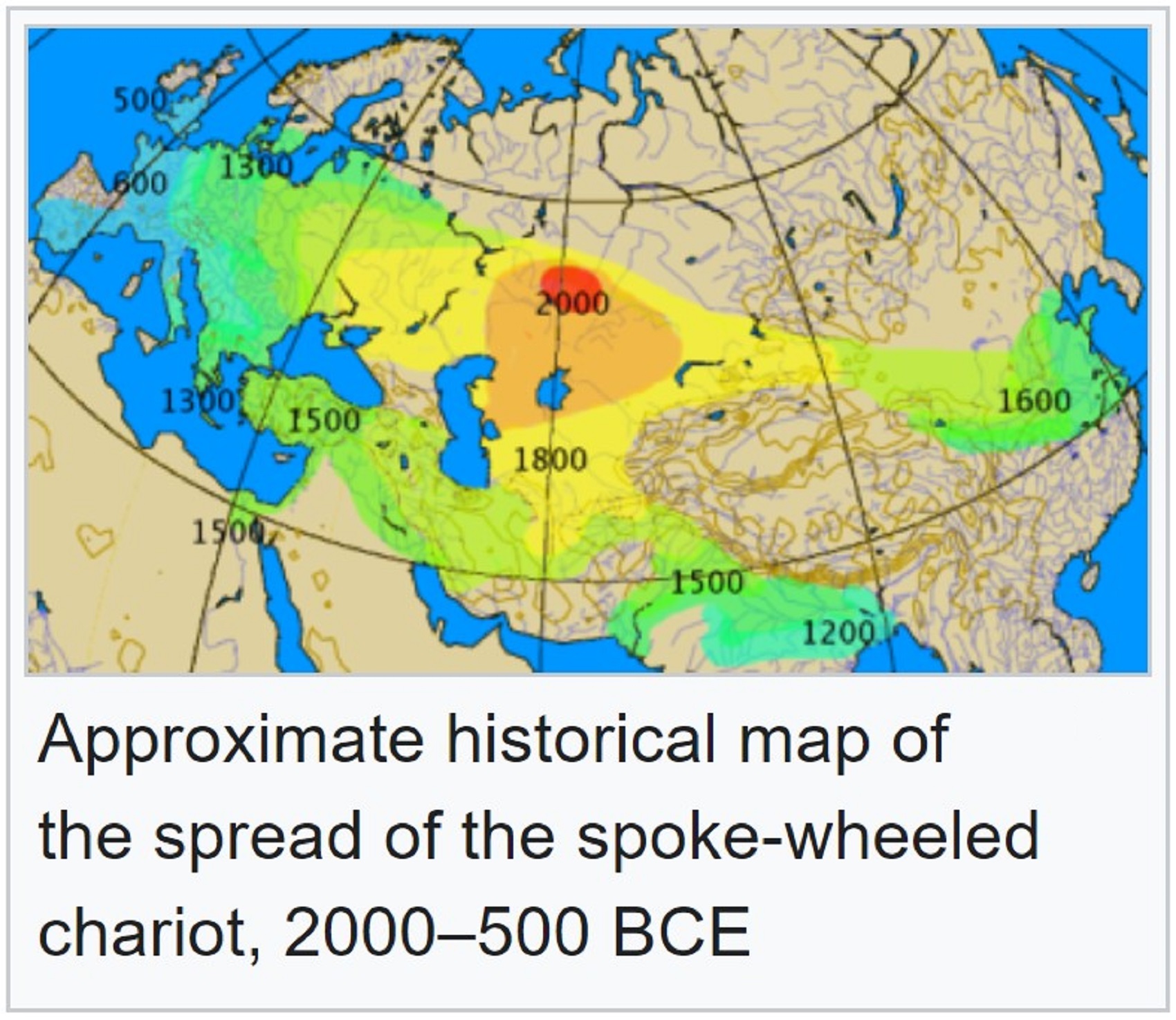
Pic ref
“A chariot is a type of cart driven by a charioteer, usually using horses to provide rapid motive power. The oldest known chariots have been found in burials of the Sintashta culture in modern-day Chelyabinsk Oblast, Russia, dated to c. 2000 BCE or 4,022 years ago. The critical invention that allowed the construction of light, horse-drawn chariots was the spoked wheel. The chariot was a fast, light, open, two-wheeled conveyance drawn by two or more horses that were hitched side by side, and was little more than a floor with a waist-high guard at the front and sides. It was initially used for ancient warfare during the Bronze and Iron Ages, but after its military capabilities had been superseded by light and heavy cavalries, chariots continued to be used for travel and transport, in processions, for games, and in races.” ref
“By the 4th millennium BCE or between 6,022 to 5,022 years ago, the agricultural revolution had developed to the point where small cities developed in Mesopotamia. Now the ball could get rolling. Military conquests expanded city-states into empires begin in the 3rd millennium BCE or between 5,022 to 4,022 years ago. Sargon I, created the first empire (Akkadian Empire) and pioneered combined arms tactics using archers, donkey chariots, and spear-armed infantry units. The Pharaoh Senusret I in the 20th century BC conquered Nubia and placed it under Egyptian control. Babylonia and later the brutally efficient Assyrians built empires in Mesopotamia. While the Hittite Empire ruled much of Anatolia and the Pharaohs ruled the Nile delta. Chariots first appeared on the Eurasian steppes in the 20th century BC, and become central to warfare in the ancient Near East after massive invasions of Chariot using tribes slammed into the settled river valley civilizations. The Aryan (Indo-Iranian), Kassite, and Hyksos conquered and ruled the once proud civilizations. The Hyksos took control of the Nile Delta, ruling for several hundred years until the ancient Egyptian military, led by a Prince who still ruled the middle section of the Nile Valley defeated them using their own Chariot tactics against them.” ref

“Religion is an Evolved Product” and Yes, Religion is Like Fear Given Wings…
Atheists talk about gods and religions for the same reason doctors talk about cancer, they are looking for a cure, or a firefighter talks about fires because they burn people and they care to stop them. We atheists too often feel a need to help the victims of mental slavery, held in the bondage that is the false beliefs of gods and the conspiracy theories of reality found in religions.

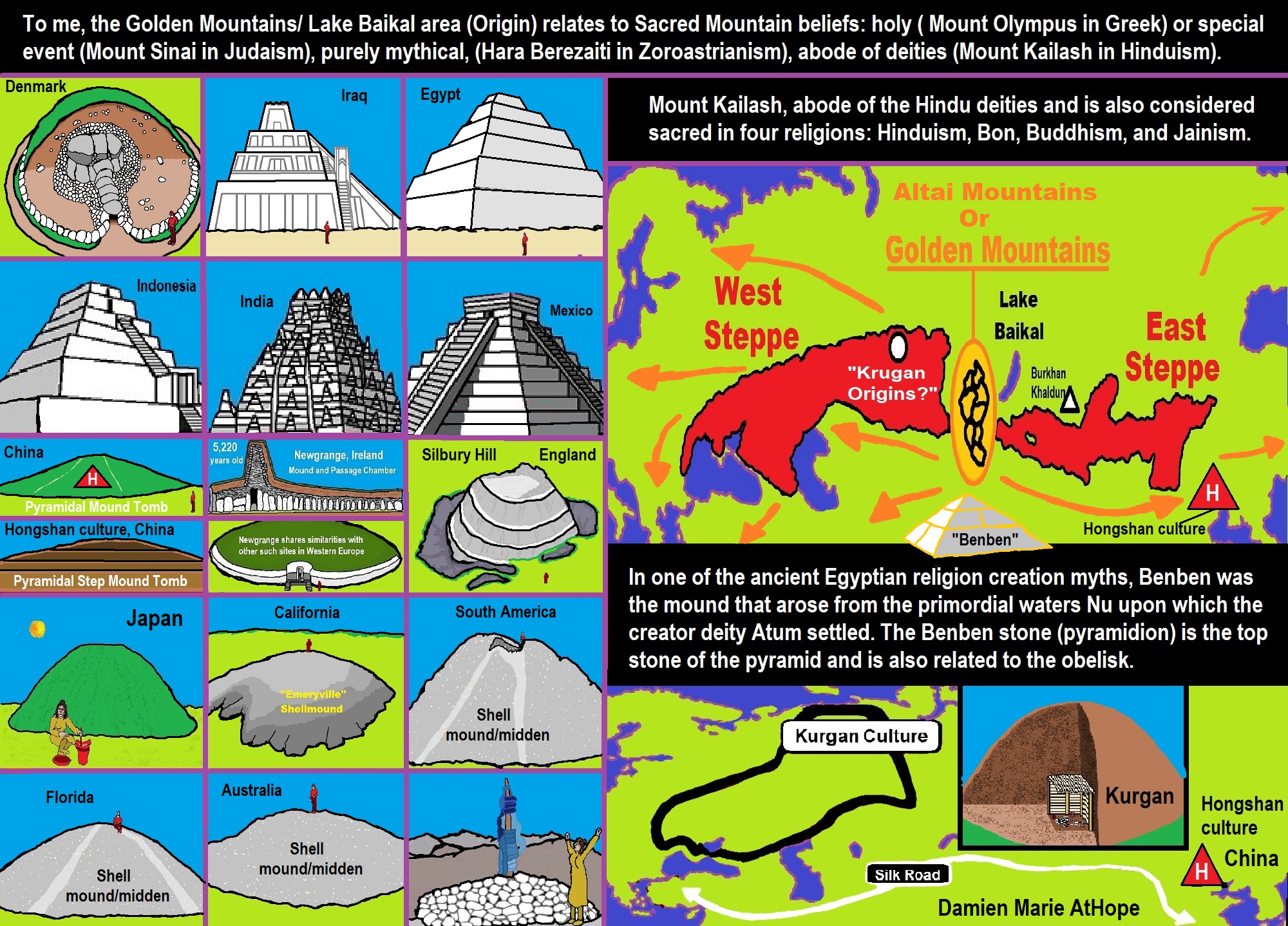
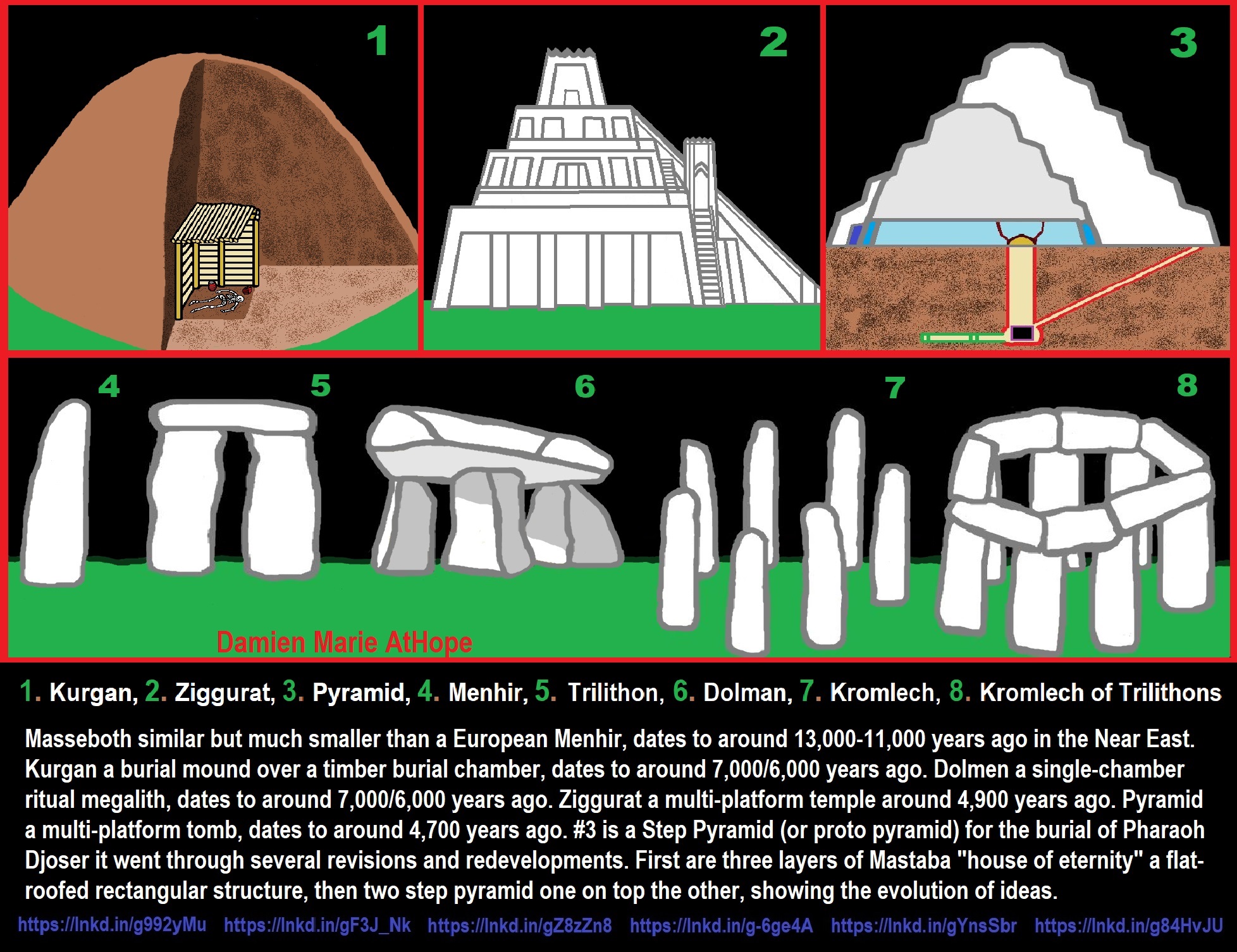
Primitive communism? Yes, and no?
“Primitive communism is a way of describing the gift economies of hunter-gatherers throughout history, where resources and property hunted or gathered are shared with all members of a group in accordance with individual needs. In political sociology and anthropology, it is also a concept (often credited to Karl Marx and Friedrich Engels), that describes hunter-gatherer societies as traditionally being based on egalitarian social relations and common ownership. Anarchists, including Peter Kropotkin and Élisée Reclus, believed that societies that exemplified primitive communism were also examples of anarchist society before industrialisation. An example of this is Kropotkin’s anthropological work on anarchism and gift economies, Mutual Aid: A Factor of Evolution, which uses a study of the San people of southern Africa for its thesis.” ref
While Damien can roughly agree with anarchist Kropotkin on African hunter-gatherer societies, that animist heavy cultures in central/southern Africa, do seem to exhibit an anarchist socialism these cultures have varied styles and should be viewed as variations more than a single group or approach.
“The hunter-gatherer San are among the oldest cultures on Earth, and are thought to be descended from the first inhabitants of what is now Botswana and South Africa. The San peoples also derogatorily called “Bushmen” are the members of the indigenous hunter-gatherer cultures of southern Africa, and the oldest surviving cultures of the region. Their ancestral territories span Botswana, Namibia, Angola, Zambia, Zimbabwe, Lesotho, and South Africa. The designations “Bushmen” and “San” are both exonyms. “San” is a derogatory word originally used by the pastoralist Khoekhoe. Anthropologist Henry Harpending stated, In the 1970s the name “San” spread in Europe and America because it seemed to be politically correct, while “Bushmen” sounded derogatory and sexist. [But] one did not call someone a San to his face. The San refer to themselves as their individual nations, such as ǃKung (also spelled ǃXuun, including the Juǀʼhoansi), ǀXam, Nǁnǂe (part of the ǂKhomani), Kxoe (Khwe and ǁAni), Haiǁom, Ncoakhoe, Tshuwau, Gǁana and Gǀui (ǀGwi), etc. Representatives of San peoples in 2003 stated their preference for the use of such individual group names where possible over the use of the collective term San.” ref
Primitive communism in hunter-gatherers Venus figures from the Kostenki – Borshevo cultures of Russia 30,000 to 20,000?
Damien does not think so; rather to Damien, it seems there may have been signs of slavery or at least some level of inequality may be expressed thus primitive communism in this area seems lacking.
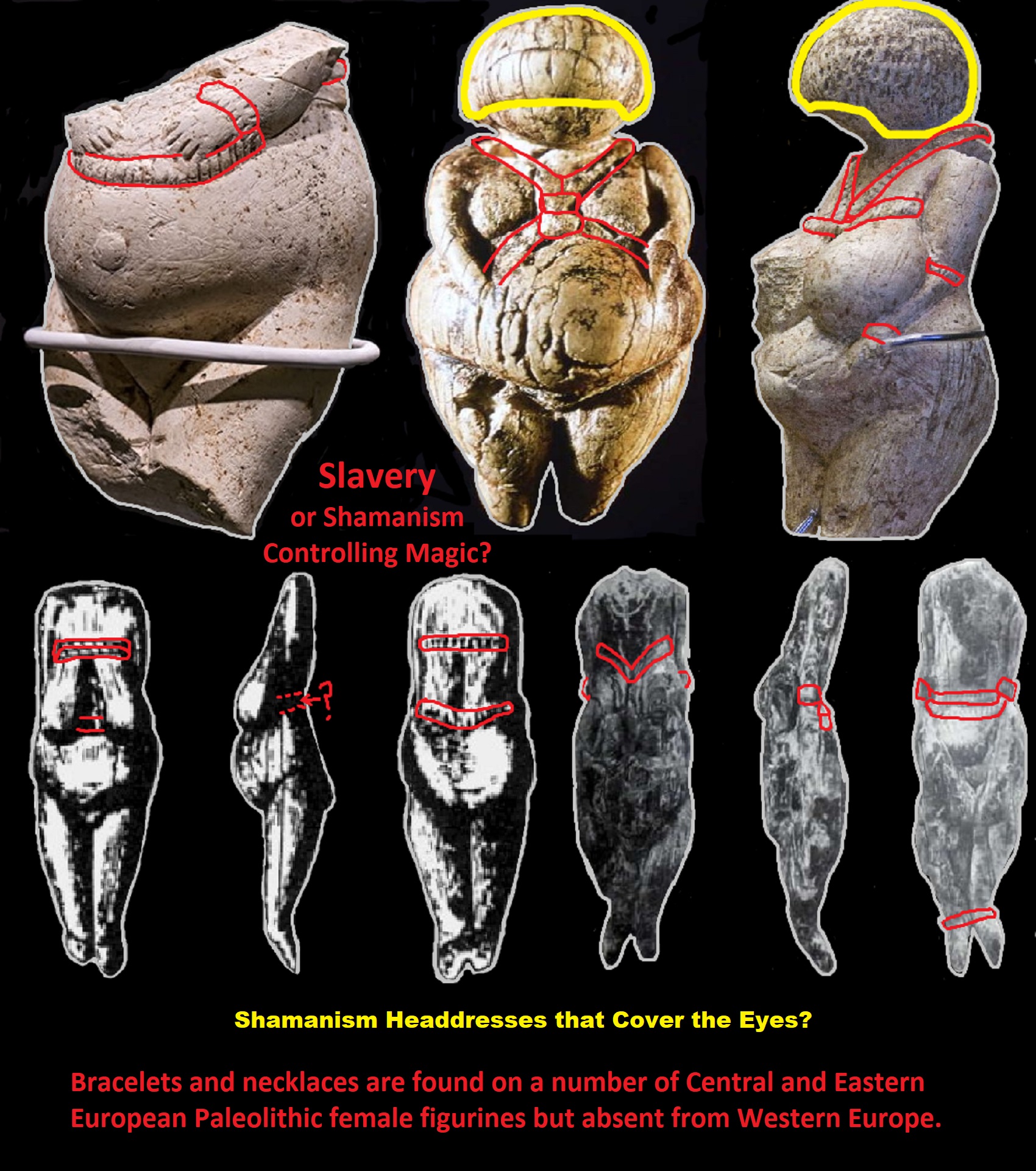
Slavery or Shamanism Controlling Magic, or Both?
“Bracelets and necklaces are found on a number of Central and Eastern European Paleolithic female figurines but absent from Western Europe.” ref
Venus figures from the Kostenki – Borshevo: link
“The Venus figurines of Kostenki are prehistoric representations of the female body, usually in ivory and usually dated to between 25,000 and 20,000 years ago, making them part of the Gravettian industry of the Upper Palaeolithic period. Found in the Kostyonki-Borshchyovo archeological complex in Russia.” ref
“Kostenki is a very important Paleolithic site on the Don River in Russia. It was a settlement which contained venus figures, dwellings made of mammoth bones, and many flint tools and bone implements. Kostenki / Kostienki is not actually a single site but really an area on the right bank of the Don River in the regions of the villages of Kostenki and Borshevo, consisting of more than twenty site locations, all dating to the Paleolithic.” ref
“The Kostyonki–Borshchyovo archaeological complex is an area where numerous Upper Paleolithic archaeological sites have been found, located around the villages of Kostyonki (also Kostenki) and Borshchyovo (also Borshchevo). The area is found on the western (right) bank of the Don River in Khokholsky District, Voronezh Oblast, Russia, some 25 km south of the city of Voronezh. The 26 Paleolithic sites of the area are numbered Kostenki 1–21 and Borshchevo 1–5. It is known for its high concentration of cultural remains of anatomically modern humans from the beginning of the Upper Paleolithic era, before 40,000 years ago. Finds are on exhibit in situ, at the State Archaeological Museum–Reserve Kostyonki built atop the mammoth bone circle Kostenki 11. Kostyonki is considered as belonging to the Aurignacian culture.” ref
“Kostenki-1/2 (site Kostenki-1, layer 2), Kostenki-1/3, Kostenki-6 (Streletskaya), Kostenki-11 and Kostenki 12/3 below the volcanic CI tephra layer are associated to the nontransitional local “Strelets culture”, analogous to early Upper Paleolithic cultures from central and western Europe such as the Szeletian culture. This initial cultural development might be attributable to local Neanderthals. Ornaments predating the volcanic eruption, found at Kostenki 17/2 (“Spitsyn culture”, 38–32 ka), were apparently perforated by a hand-operated rotary drill or drills; these may suggest that the population was technologically capable of preparing for a volcanic winter. Just above the ash layer sewing needles were found. Kostenki 1/1, Kostenki 4/2, Kostyonki 8/2 and Kostenki 21/3 belong to the eastern Gravettian (24 to 22 ka). Kostenki 2, Kostenki 3, Kostenki 11-1a and Kostenki-19 belong to the Zamyatino culture (22 to 17 ka). Kostenki 8/2 (Telmanskaya) is eponymous of “Telman culture.”As of 2016, archaeological work is done at Kostenki-14 (Markina Gora), Kostenki-6 (Streletskaya), Kostenki-15 (Gorodtsovskaya), Kostenki-16 (Ugljanka), Kostenki-17 (Spitsynskaya) and Kostenki-21 (Gmelinskaya).” ref
“Some of the earliest directly dated human remains from this site are dated to 32,600 ± 1,100 14C years and consist of a tibia and a fibula, with traits classifying the bones as European early modern humans. In 2009, DNA was extracted from the remains of a male hunter-gatherer from Kostenki-12 who lived circa around 30,000 years ago and died aged 20–25. His maternal lineage was found to be mtDNA haplogroup U2. He was buried in an oval pit in a crouched position and covered with red ochre. Kostenki 12 was later found to belong to the patrilineal Y-DNA haplogroup C1* (C-F3393).” ref
“A male from Kostenki-14 (Markina Gora), who lived approximately 38,700–36,200 year ago, was also found to belong to mtDNA haplogroup U2. His Y-DNA haplogroup was C1b* (C-F1370). The Kostenki-14 genome represents early evidence for the separation of Europeans and East Asian lineages. It was found to have a close relationship to both “Mal’ta boy” (24 ka) of south-east Siberia (Ancient North Eurasian) and to the later Mesolithic hunter-gatherers of Europe and western Siberia, as well as with a basal population ancestral to Early European Farmers, but not to East Asians. Yang et al. 2020 found that the early hunter-gatherers lineage of Kostenski-14 may have contributed (c. 68%) ancestry to the Ancient North Eurasian Yana and Mal’ta samples, with the remainder ancestry (c. 32%) being contributed from an East-Eurasian Tianyuan-related population. Kostenki-14 had some level of ancient Neanderthal admixture, which has been dated as going back to circa around 54,000 years ago.” ref
“Hello Damien. Have you done any research into the history of transgenderism and the belief in reincarnation? Another thought, is there a link between shamanism and transgenderism? I see a lot of the persecution of trans people nowadays is also a persecution of non-Abrahamic beliefs?” – Questioner on Twitter
Damien’s response, Transgenderism and the belief in reincarnation? I don’t know. Shamanism and transgenderism/gender-switching? I think so, in some versions of shamanism, yes, and especially it seems so in Siberian shamanism.
Animism and Gender?
“Among the Ojibwe and speakers of cognate Algonkian language, a grammatical distinction is made between animate and inanimate genders, not between male and female genders. Persons and personal actions are talked about in a different way from objects and impersonal events. As demonstrated in the work of such scholars as Marjorie Balzer, Marie Czaplicka, and Bernard Saladin D’Anglure, these and other indigenous conceptions of gender, sex, and sexual orientation, tend to disrupt Western binary conventions of “male” and “female,” conflations of sex and gender, and heterosexuality as normative.” ref
Shamanic Gender Identities?
“Shamanic behavior necessitates a broadening of the notion of gender to be more fluid and dynamic, to include not only male and female but also various mediating identities. Czaplicka, for example, notes that Siberian shamans are a “third class,” separate from males and females, and Saladin D’Anglure proposes a “ternary” model for Inuit shamans wherein shamans are “in between” persons (by persuasion or initiation) who embody a “third gender” due to their ability to mediate. The “third gender” status of Inuit shamans is part of wider gender concepts: children are understood to have decided which gender to be before or at birth, their genitalia adapting to their decision. Other children are given the name of a deceased relative of the opposite gender, performing that gender identity for the time that they hold the name.” ref
Third Gender and Changing Ones?
“Third gender” (shamans in other instances may have a fourth or even multiple gender identity) overlaps in some examples with homosexuality, with the marriage of some shamans to same-sex “spirit” partners involving, in some examples, homosexual marriages in the “ordinary world.” Shamans’ costumes may combine features peculiar to the dress of both men and women. Early explorers assumed biological males dressed in women’s clothing (some of whom were shamans) were transvestites, and the pejorative French term berdache (“male prostitute,” “transvestite”) entered anthropological literature. The more sensitive “two-spirit” was proposed by Native Americans in the 1990s, referring to the individual having two spirits, although “changing ones” more successfully avoids reproducing a Western binary opposition.” ref
Nonhuman Sexual Relations?
“Cross-dressing may indicate shamans’ difference from the rest of the community or show that they have formed an intimate, sexual, and/or marital relationship with a nonhuman person of the same gender. Transvestitism may be temporary, a part of specific performances, or permanent as a sign of a distinctive everyday identity. Shamans may undertake marriage to non-human persons of the same gender as themselves and, for example, a female shaman may sometimes be “male” in relation to a spirit wife: a Sora shaman of the Indian subcontinent marries a man, and the “spirit son” of her predecessor, who is her own aunt. The tightly bound relationship between shamans and their other world helpers, especially those with whom they form sexual and/or marital relationships, may mean that secrets are kept, and the revealing of such secrets may lead to the withdrawal of assistance from a nonhuman helper, thus compromising the shaman’s ability to shamanize. Sex has been theorized as key to understanding shamanism by Roberte Hamayon, who attends to shamans, sex, and gender in Siberian shamanism. She argues that shamanic séances among the Evenk and Buryats are “sexual encounters” in themselves. She views the “marriage” between shamans and their non-human helpers as more significant in understanding what these shamans do than the “ecstasy,” “mastery of spirits,” “altered states” or “journeying” emphasized by other scholars.” ref
Gender Identities Conclusion?
“Early work on Siberian shamans by Sergei Shirokogoroff demonstrated that shamans may be either (or both) “hostages to the spirits” and their sexual and/or marital partners. Shamans might, then, be defined as people who welcome “possession” as an embodiment of (sexual and/or marital) relationship with otherthan-human-persons. As the most effective mediators, then–between genders, between humans and nonhumans, the living and dead, and so on–shamans mediate between all the many constituent elements, beings, and situations of the cosmos. They thereby actively accomplish meanings through the construction of relations between human and other-than-human worlds.” ref
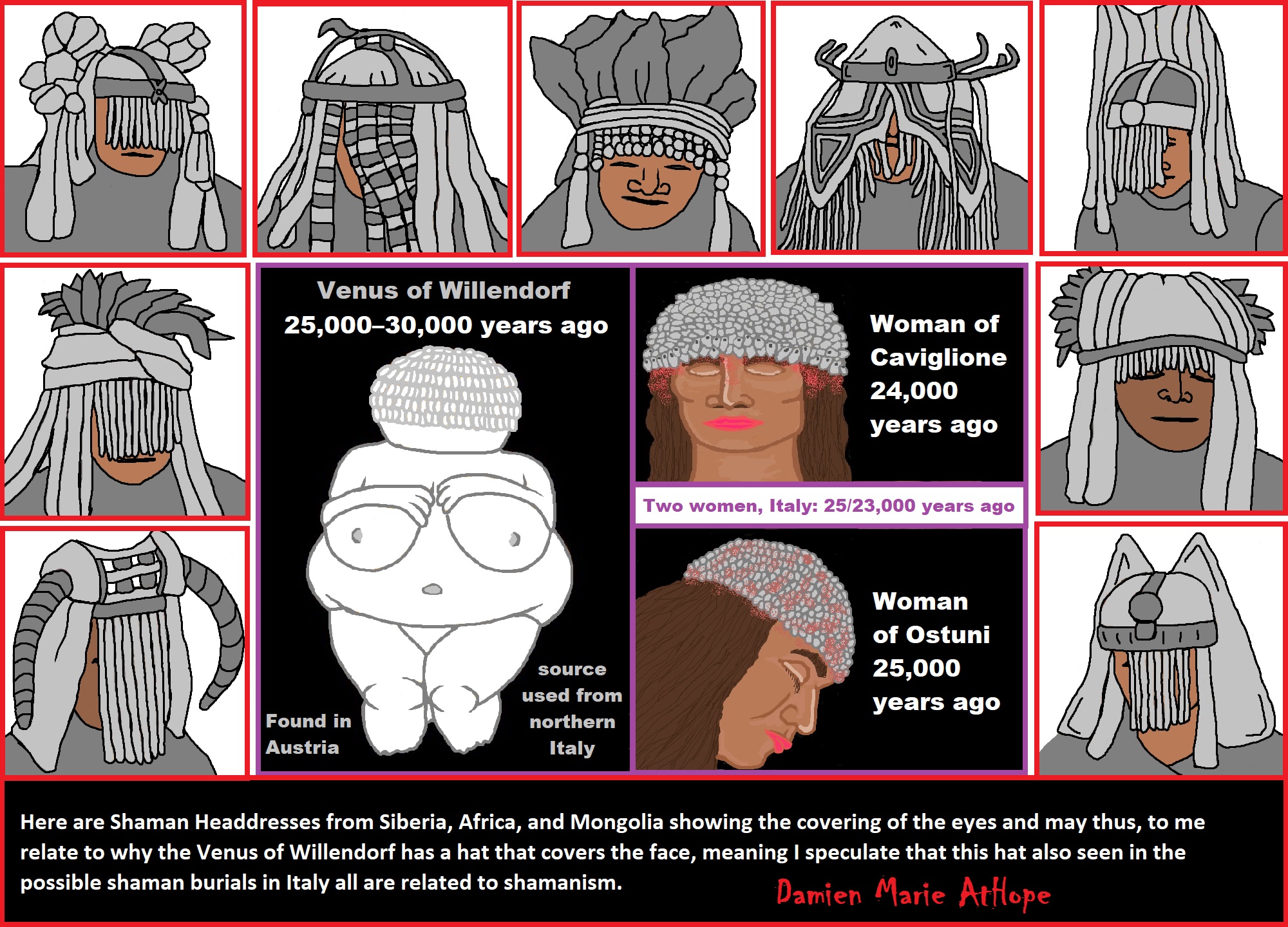
Here are Shaman Headdresses from Siberia, Africa, and Mongolia showing the covering of the eyes and may thus, to me relate to why the Venus of Willendorf has a hat that covers the face, meaning I speculate that this hat, also seen in the possible shaman burials in Italy all are related to shamanism.
“Venus figurines have been unearthed in Europe, Siberia, and much of Eurasia. Most date from the Gravettian period but start in the Aurignacian era, and lasts to the Magdalenian time.” ref
“Egalitarian and communist-like hunter-gatherer societies have been studied and described by many well-known social anthropologists including James Woodburn, Richard Borshay Lee, Alan Barnard, and Jerome Lewis. Anthropologists such as Christopher Boehm, Chris Knight, and Lewis offer theoretical accounts to explain how communistic, assertively egalitarian social arrangements might have emerged in the prehistoric past. Despite differences in emphasis, these and other anthropologists follow Engels in arguing that evolutionary change—resistance to primate-style sexual and political dominance—culminated eventually in a revolutionary transition. Lee criticizes the mainstream and dominant culture‘s long-time bias against the idea of primitive communism, deriding “Bourgeois ideology [that] would have us believe that primitive communism doesn’t exist. In popular consciousness it is lumped with romanticism, exoticism: the noble savage.” ref
“Due to the strong evidence of an egalitarian society, lack of hierarchy, and lack of economic inequality, historian Murray Bookchin has argued that Çatalhöyük was an early example of anarcho-communism, and so an example of primitive communism in a proto-city. However, still others use Çatalhöyük as an example that refutes the concept of primitive communism.” ref
Damien does not think Çatalhöyük is great as representing to Damien there is some amount of hierarchy/special leader burials for a few males and special female burials seeming to be a shaman or religious authority or at least some level of inequality may be expressed thus primitive communism in this area seems lacking.
Damien will add some of his art as a helpful reference to show the inequality.
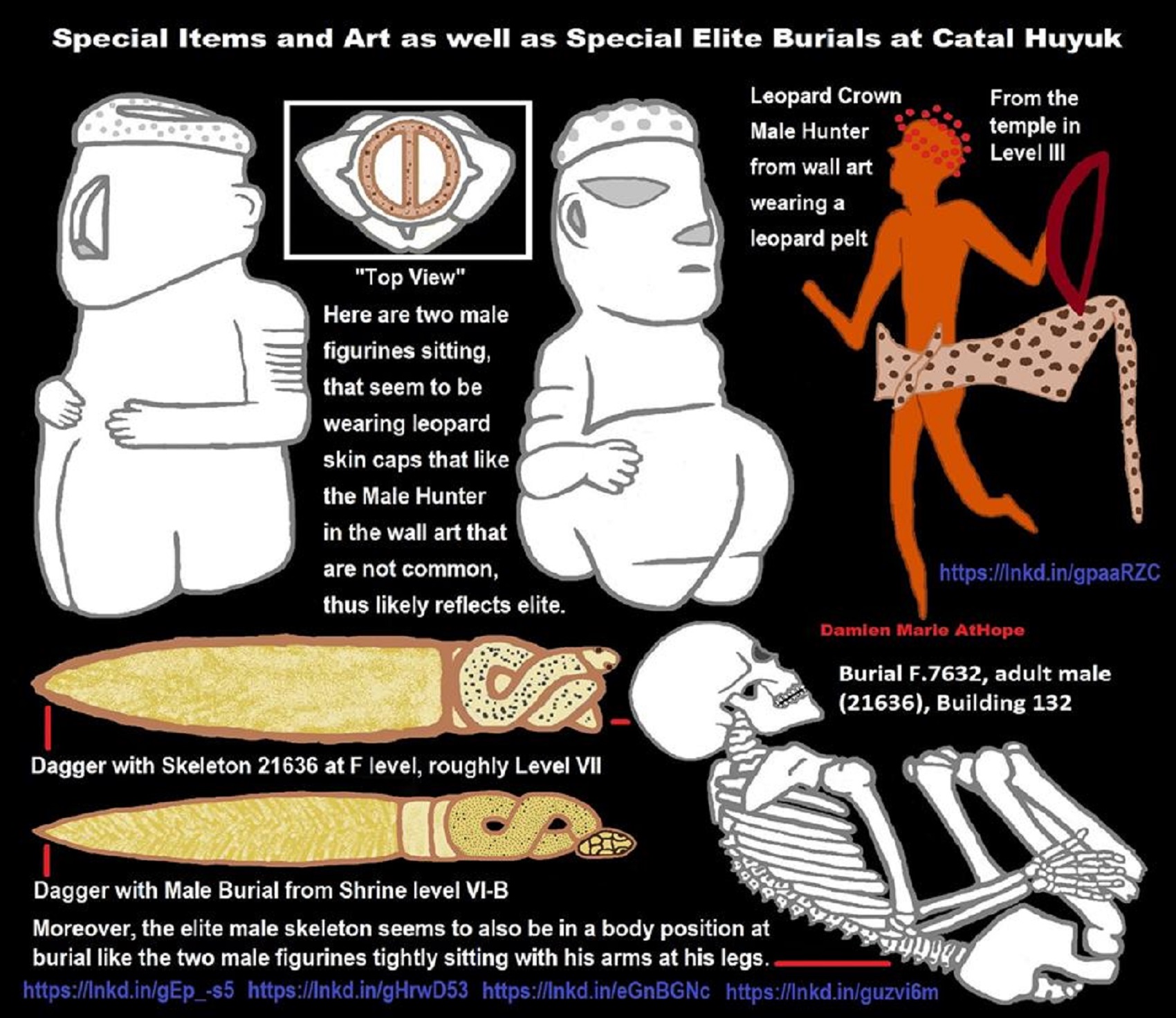

There are other clothing resembling miniskirts that have been identified by archaeologists and historians as far back as 3,390–3,370 years ago. But this is much older. ref
Leopard claw-bone pendant from the Possible Woman Shaman/Priestess burial with the plastered and painted woman’s head in her arms that is several generations removed. She was buried under the floor of the history house (house with multiple burials beyond that of the connected family) with the twin facing leopards at Catal Huyuk. Ref
“From about 7500 B.C.E to 5700 B.C.E., early farmers grew wheat, barley, and peas, and raised sheep, goats, and cattle. At its height, some 10,000 people lived there. Among its more noteworthy features, Çatalhöyük’s inhabitants were obsessed with plaster, lining their walls with it, using it as a canvas for artwork, and even coating the skulls of their dead to recreate the lifelike countenances of their loved ones.” ref
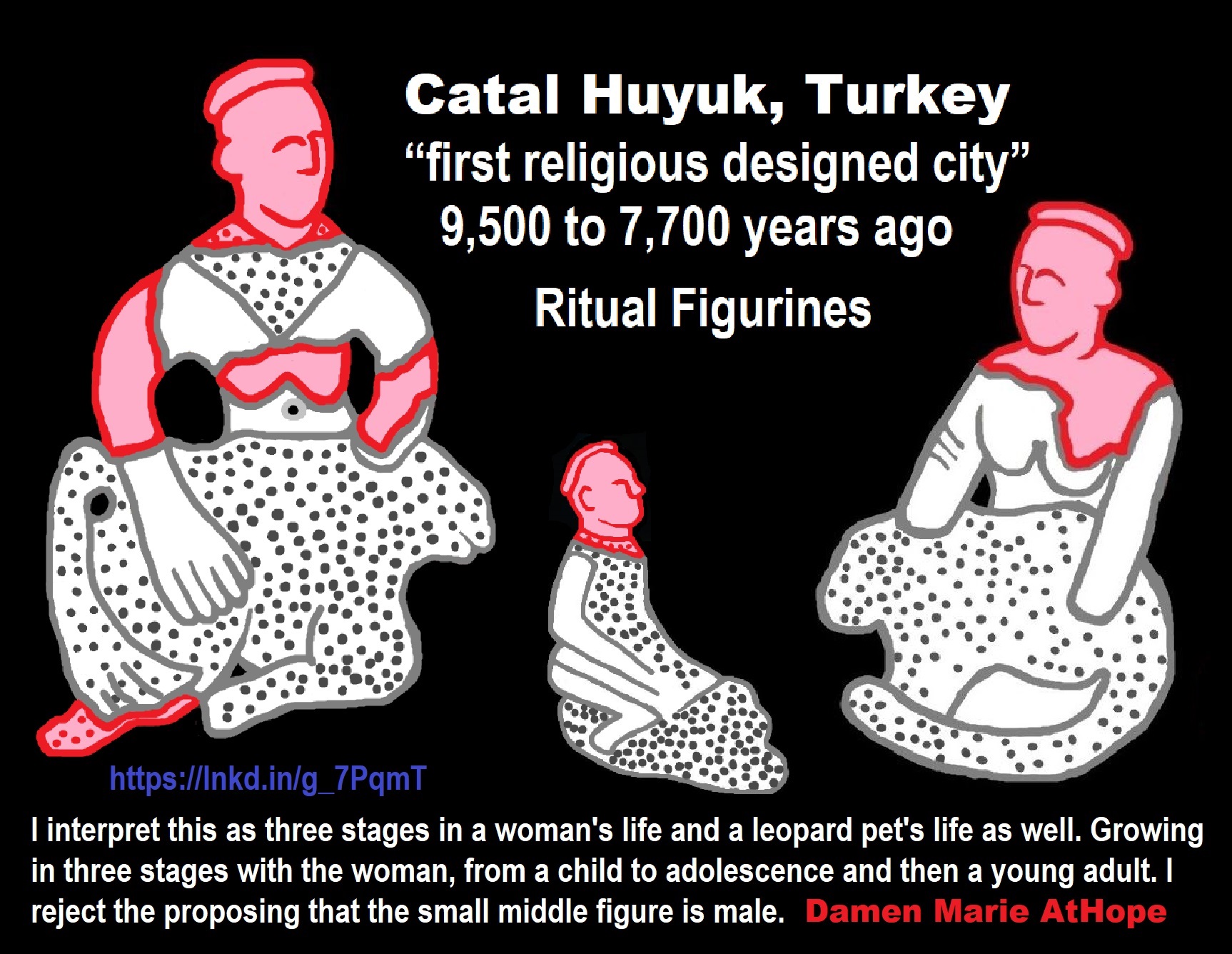
No gentry but grave-makers: inequality beyond property accumulation at Neolithic Çatalhöyük
“ABSTRACT: Archaeologists have adopted the Gini coefficient to evaluate unequal accumulations of material, supporting narratives modeled on modern inequality discourse. Proxies are defined for wealth and the household, to render 21st century-style economic tensions perceptible in the past. This ‘property paradigm’ treats material culture as a generic rather than substantive factor in unequal pasts. We question this framing while suggesting that the Gini coefficient can prompt a deeper exploration of value. Our study grows from multi-material evaluation of inequality at Çatalhöyük, Turkey. Here we use the Gini coefficient to scrutinise distributions of burial practices among houses. To the expectations of the property paradigm, the result is unintuitive – becoming slightly more equal despite rising social complexity. We explore possible explanations for this result, each pointing to a more substantive link between past futures and differentiated lives as a framework for archaeologies of inequality.” ref
‘Primitive Communism’: Did it Ever Exist? 10/11/2021 By Conor Kostick
“A review of The Dawn of Everything: A New History of Humanity by David Graeber and David Wengrow and an explanation of why the concept of primitive communism is mistaken. For some years now, the evidence has been growing for a pre-history of humanity that shows an extraordinary richness, both in terms of material production, like massive settlements of thousands of people, and in terms of cultural exchanges over immense distances. It will come as a surprise to everyone on the left who held to the ‘undeveloped human labor’ model for the origin of classes – just as it came as a surprise to me – to read of sites like Çatalhöyük in modern-day Turkey, where perhaps 10,000 people flourished around 7,000 BCE.” https://independentleft.ie/primitive-communism/
There is evidence of Violent Injuries at Neolithic Çatalhöyük, (thought by some as evidence of control by some type of leader/leaders) https://www.cambridge.org/core/books/abs/violence-and-the-sacred-in-the-ancient-near-east/girardian-framework-for-violent-injuries-at-neolithic-catalhoyuk-in-their-western-asian-context/E68BE060DCA18A291D6339FBD2924FBB
“The Çatalhöyük community presents a compelling record of elevated levels of interpersonal violence, represented by healed cranial depressed fractures in 25 individuals of the sample of 93 crania analyzed in an on-going study. The morphology of the lesions suggests that these injuries were caused by blows to the head involving hard, round objects. A comparison of these data with archaeological findings from the site suggests that scores of hardened clay balls recovered from house and other contexts may have been the weapon of choice. Clay balls are especially well suited for sling propulsion, and their size and shape would fit the general morphology of the cranial injuries observed in the Çatalhöyük victims. The demographic distribution of the injuries is highly patterned. Slightly more females than males are affected overall (13 vs. 10, respectively, for crania with a clear sex identification). Twelve of the 93 (13%) were injury recidivists, having sustained anywhere from 2 to 5 injuries over a span of time. Those with some of the highest recurrent injuries are adult females. For those victims, trauma predominates on the superior and posterior surfaces of their cranial vaults, suggesting that those women affected by interpersonal violence were not facing their assailants when struck. Chronologically, frequencies of cranial injuries are in line with the hypothesis of an increase in interpersonal violence during the Middle Period due to the changes in population size and density. An argument can be made for elevated stress and conflict within the community. This finding matches those from a number of settings today and in the archaeological past, confirming the association between violence and demographic pressure. On the other hand, the high degree of variation in trauma frequencies documented in past and present communities living in crowded settings does not, by itself, explain the variation in cranial trauma at Çatalhöyük. However, the association between social circumstances and interpersonal violence is compelling, especially in the development of a behavioral reconstruction in a crowded community and one engaged in relatively high-intensity farming.” https://www.pnas.org/doi/10.1073/pnas.1904345116
“What Happened to Turkey’s Ancient Utopia? Turkey’s Neolithic city of Çatalhöyük may have been an orderly society built on tolerance and equality — until it fell apart. “The cranium had a depressed fracture,” says Knüsel. “We started going through the other remains looking for more.” He and Glencross found dozens of skulls with similar wounds, all showing a consistent pattern of injury to the top back of the skull. “The pattern of the wounds suggests that most of them were inflicted by thrown projectiles, but all of them were healed, meaning they were not fatal.” They speculate that the attacks that caused the injuries were meant only to stun, perhaps to control wayward members of the group, or to abduct outsiders as wives or slaves. In line with Hodder’s theory, the skulls with this characteristic were found primarily in later levels of the site, when more independence and differentiation between households started to emerge. Hodder speculates that, with these inequalities potentially creating new tensions among the community’s members, non-fatal violence may have been a means to keep everyone in check and prevent or diffuse full-fledged conflicts that could break the settlement apart. “The head wounds, in a way, confirm the idea of a controlled society,” Hodder says. “They suggest that violence was contained and regulated, not something that led to large-scale killing.” https://www.discovermagazine.com/the-sciences/what-happened-to-turkeys-ancient-utopia
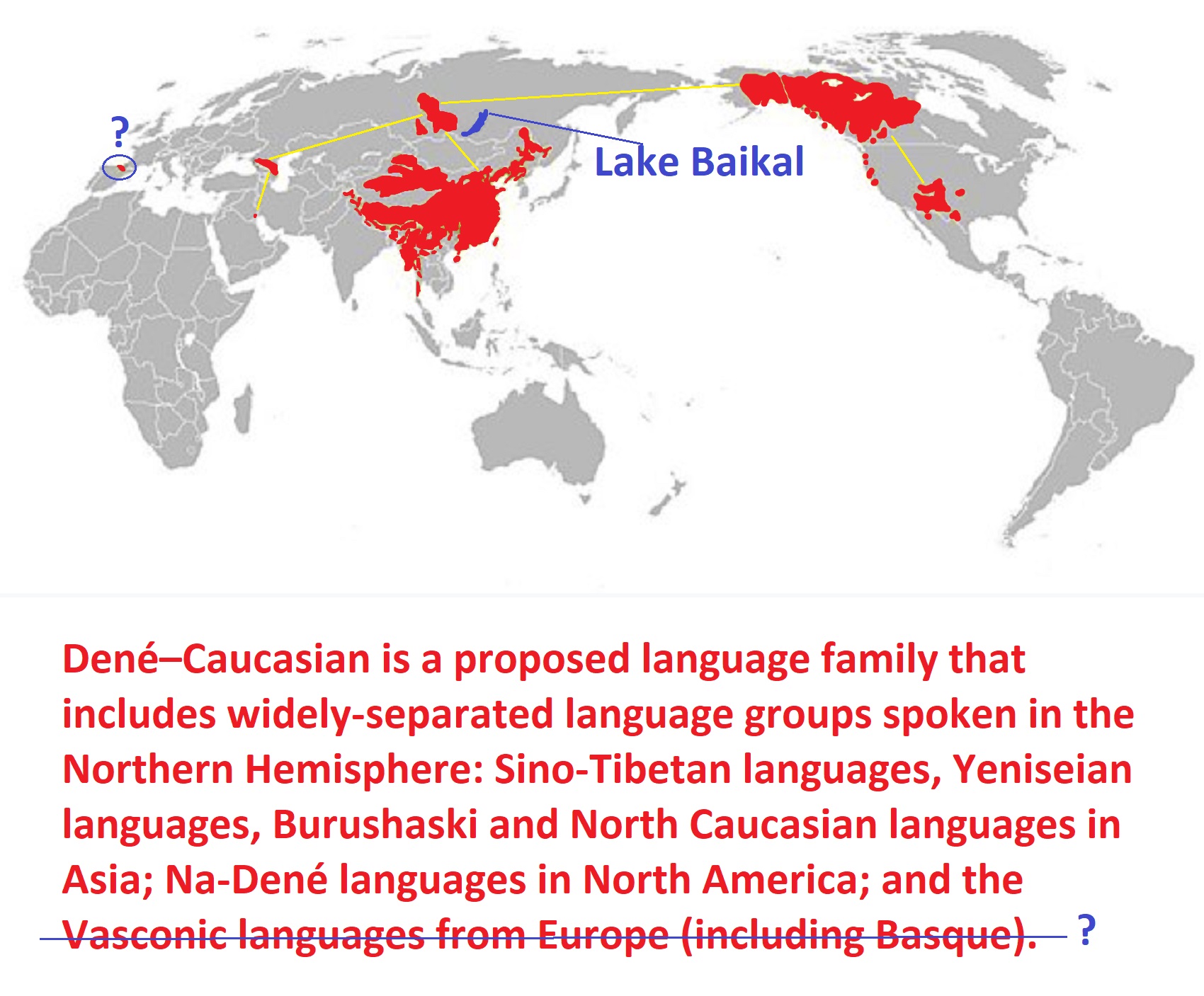
Dené–Caucasian languages?
“Dené–Caucasian is a proposed language family that includes widely-separated language groups spoken in the Northern Hemisphere: Sino-Tibetan languages, Yeniseian languages, Burushaski and North Caucasian languages in Asia; Na-Dené languages in North America; and the Vasconic languages from Europe (including Basque). A narrower connection specifically between North American Na-Dené and Siberian Yeniseian (the Dené–Yeniseian languages hypothesis) was proposed by Edward Vajda in 2008, and has met with some acceptance within the community of professional linguists. The validity of the rest of the family, however, is viewed as doubtful or rejected by nearly all historical linguists.” ref
“Classifications similar to Dené–Caucasian were put forward in the 20th century by Alfredo Trombetti, Edward Sapir, Robert Bleichsteiner, Karl Bouda, E. J. Furnée, René Lafon, Robert Shafer, Olivier Guy Tailleur, Morris Swadesh, Vladimir N. Toporov, and other scholars.” ref
“Morris Swadesh included all of the members of Dené–Caucasian in a family that he called “Basque-Dennean” (when writing in English, 2006/1971: 223) or “vascodene” (when writing in Spanish, 1959: 114). It was named for Basque and Navajo, the languages at its geographic extremes. According to Swadesh (1959: 114), it included “Basque, the Caucasian languages, Ural-Altaic, Dravidian, Tibeto-Burman, Chinese, Austronesian, Japanese, Chukchi (Siberia), Eskimo-Aleut, Wakash, and Na-Dene”, and possibly “Sumerian.” ref
“Swadesh’s Basque-Dennean thus differed from Dené–Caucasian in including (1) Uralic, Altaic, Japanese, Chukotian, and Eskimo-Aleut (languages which are classed as Eurasiatic by the followers of Sergei Starostin and those of Joseph Greenberg), (2) Dravidian, which is classed as Nostratic by Starostin’s school, and (3) Austronesian (which according to Starostin is indeed related to Dené–Caucasian, but only at the next stage up, which he termed Dené–Daic, and only via Austric (see Starostin’s Borean macrofamily)). Swadesh’s colleague Mary Haas attributes the origin of the Basque-Dennean hypothesis to Edward Sapir. In the 1980s, Sergei Starostin, using strict linguistic methods (proposing regular phonological correspondences, reconstructions, glottochronology, etc.), became the first to put the idea that the Caucasian, Yeniseian, and Sino-Tibetan languages are related on firmer ground. In 1991, Sergei L. Nikolaev added the Na-Dené languages to Starostin’s classification.” ref
“The inclusion of the Na-Dené languages has been somewhat complicated by the ongoing dispute over whether Haida belongs to the family. The proponents of the Dené–Caucasian hypothesis incline towards supporters of Haida’s membership in Na-Dené, such as Heinz-Jürgen Pinnow or, most recently, John Enrico. Edward J. Vajda, who otherwise rejects the Dené–Caucasian hypothesis, has suggested that Tlingit, Eyak, and the Athabaskan languages are closely related to the Yeniseian languages, but he denies any genetic relationship of the former three to Haida. Vajda’s ideas on the relationship of Athabaskan–Eyak–Tlingit and Yeniseian have found support independently in works of various authors, including Heinrich K. Werner or Merritt Ruhlen. DNA analyses have not shown any special connection between the modern Ket population and the modern speakers of the Na-Dené languages.” ref
“In 1996, John D. Bengtson added the Vasconic languages (including Basque, its extinct relative or ancestor Aquitanian, and possibly Iberian), and in 1997 he proposed the inclusion of Burushaski. The same year, in his article for Mother Tongue, Bengtson concluded that Sumerian might have been a remnant of a distinct subgroup of the Dené–Caucasian languages. However, two other papers on the genetic affinity of Sumerian appeared in the same volume: while Allan R. Bomhard considered Sumerian to be a sister of Nostratic, Igor M. Diakonoff compared it to the Munda languages.” ref
“In 1998, Vitaly V. Shevoroshkin rejected the Amerind affinity of the Almosan (Algonquian-Wakashan) languages, suggesting instead that they had a relationship with Dené–Caucasian. Several years later, he offered a number of lexical and phonological correspondences between the North Caucasian, Salishan, and Wakashan languages, concluding that Salishan and Wakashan may represent a distinct branch of North Caucasian and that their separation from it must postdate the dissolution of the Northeast Caucasian unity (Avar-Andi-Tsezian), which took place around the 2nd or 3rd millennium BCE.” ref
“The existence of Dené–Caucasian is supported by:
- Many words that correspond between some or all of the families referred to Dené–Caucasian.
- The presence in the shared vocabulary of words that are rarely borrowed or otherwise replaced, such as personal pronouns.
- Elements of grammar, such as verb prefixes and their positions (see below), noun class prefixes, and case suffixes that are shared between at least some of the component families.
- A reconstruction of the sound system, the basic parts of the grammar, and much of the vocabulary of the macrofamily’s most recent common ancestor, the so-called Proto-Dené–Caucasian language.” ref
“Potential problems include:
- The somewhat heavy reliance on the reconstruction of Proto-(North-)Caucasian by Starostin and Nikolayev. This reconstruction contains much uncertainty due to the extreme complexity of the sound systems of the Caucasian languages; the sound correspondences between these languages are difficult to trace.
- The use of the reconstruction of Proto-Sino-Tibetan by Peiros and Starostin, parts of which have been criticized on various grounds, although Starostin himself has proposed a few revisions. All reconstructions of Proto-Sino-Tibetan suffer from the facts that many languages of the huge Sino-Tibetan family are underresearched and that the shape of the Sino-Tibetan tree is poorly known and partly controversial.
- The use of Starostin’s reconstruction of Proto-Yeniseian rather than the competing one by Vajda or that by Werner.
- The use of Bengtson’s reconstruction of Proto-/Pre-Basque rather than Trask’s.
- The slow progress in the reconstruction of Proto-Na-Dené, so that Haida and Athabaskan–Eyak–Tlingit have so far mostly been considered separately.” ref
“Several roots can be reconstructed for the 1st and 2nd person singular pronouns. This may indicate that there were pronouns with irregular declension (suppletion) in Proto-Dené–Caucasian, like “I” vs “me” throughout Indo-European. In the presumed daughter languages some of the roots are often affixes (such as verb prefixes or possessive noun prefixes) instead of independent pronouns. The Algic, Salishan, Wakashan, and Sumerian comparisons should be regarded as especially tentative because regular sound correspondences between these families and the more often accepted Dené–Caucasian families have not yet been reconstructed. To a lesser degree this also holds for the Na-Dené comparisons, where only a few sound correspondences have yet been published. /V/ means that the vowel in this position has not been successfully reconstructed. /K/ could have been any velar or uvular plosive, /S/ could have been any sibilant or assibilate.” ref
“Noun classification occurs in the North Caucasian languages, Burushaski, Yeniseian, and the Na-Dené languages. In Basque and Sino-Tibetan, only fossilized vestiges of the prefixes remain. One of the prefixes, */s/-, seems to be abundant in Haida, though again fossilized.” ref
Verb morphology
“In general, many Dené–Caucasian languages (and Sumerian) have polysynthetic verbs with several prefixes in front of the verb stem, but usually few or no suffixes. (The big exceptions are East Caucasian, where there is usually only one prefix and many suffixes, the similarly suffixing Haida, and Sino-Tibetan, for which little morphology can so far be reconstructed at all; Classical Tibetan with its comparatively rich morphology has at most two prefixes and one suffix. In Burushaski, the number of suffixes can surpass the rather large number of prefixes.)” ref
Indoeuropeanized Sumerian language and Maikop-Uruk relations
“Ancient Indo-European Languages, Indo-European Studies, Sumerian, Indo-European Linguistics, Uruk Expansion, Uruk Period, Comparative Indo-European Linguistics, Assyriology Sumerology Akkadian Sumerian Sumerian & Akkadian literature Sumerian Religion Mesopotamia History Ancient Mesopotamian Religions Cuneiform Ancient Near East Ancient Near Eastern Languages Religious Studies, Late Chalcolithic, Early Maikop Culture, Maykop culture, Proto Literate Archaeology (Uruk and Proto Elamite Periods), Indo European Problem. Maikop might be of Sumerian Uruk origin while the Indo-European component in Sumerian might be of possible Indo-Iranian pre-Maikop Meshoko-Svobodnoye origin or/and possible Hittite-Luwian post-Maikop Novosvobodnaya origin.” ref
“Indo-European stratum in Sumerian G. Whittaker suggests Proto-Indo-European parallels to Sumerian words, e. g.: Sum. hu ‘bird’ (with a possible correlate of IE laryngeal): PIE *hau-i- (Luwian huwa-), Sum. sah ‘pig’ (with a possible correlate of IE laryngeal): PIE *s(e)uh- , Sum. ner, nir ‘lord, prince, hero’: PIE *h 2 nēr ‘man, hero’ as a Graeco-Aryan word, Sum. igi ‘eye’: PIE *hok u – ‘eye’ etc, including grammar elements: Sum. in ‘in, to; from’: PIE *en, Sum. ana ‘to, for, at, according to’: PIE *ana ‘on, up, according to’. The presence of possible correlates of laryngeals can give us a possibility of dating of the Indo-European influence on Sumerian as Proto-Indo-European or Hittite-Luwian. Hurro-Urartian, perhaps Kura-Araxes, had also laryngeals. Basing on the parallels, G. Whittaker proposes the reconstruction of the ‘Euphratic society’ of the Late Uruk period.” ref
“Sumerian conserved pre-grammaticalized forms (da ‘arm’, ‘to hold’, ‘to be near’, ‘with, and’, comitative -da ‘with’, ablative-ta ‘from’: PIE *da- ‘give’ and Nostratic da ‘and’; Nostratic case marker -da is independent word in Sumerian da, ta ‘from’, ‘to’; sam ‘equivalent’: PIE *sem ‘1’ and prefixe). Sumerian pronoun morphems (possessive suffixes -ngu ‘my’, -me ‘our’, -zu ‘your’, -ani ‘his, her’) are Indo-European rather than common Nostratic (while men ‘I, myself’ is Nostratic) and resemble F. Bopp’s agglutinative theory.” ref
The ‘Uruk Expansion’
“The fact that the characteristics of the culture of the Uruk region are found across such a large territory (from northern Syria to the Iranian plateau), with Lower Mesopotamia as a clear centre, led the archaeologists who studied this period to see this phenomenon as an “Uruk expansion”. This has been reinforced by the political situation in the modern Near East and the impossibility of excavating in Mesopotamia. Recent excavations have focused on sites outside Mesopotamia, as a ‘periphery’, and with an interest in how they related to the ‘centre’, which is paradoxically the region in this period which is least well-known—limited to the impressionistic discoveries of the monuments of Uruk. Subsequently, theories and knowledge have developed to the point of general models, drawing on parallels from other places and periods, which has posed some problems in terms of getting the models and parallels to fit the facts revealed by excavations.” ref
“Guillermo Algaze adopted the World-systems theory of Immanuel Wallerstein and theories of international trade, elaborating the first model that sought to explain the Uruk civilization. In his view, which has met with some approval, but has also found many critics, the ‘Urukians’ created a collection of colonies outside Lower Mesopotamia, first in Upper Mesopotamia (Habuba Kabira and Jebel Aruda, as well as Nineveh, Tell Brak and Samsat to the north), then in Susiana and the Iranian plateau. For Algaze, the motivation of this activity is considered to be a form of economic imperialism: the elites of southern Mesopotamia wanted to obtain the numerous raw materials which were not available in the Tigris and Euphrates floodplains, and founded their colonies on nodal points which controlled a vast commercial network (although it remains impossible to determine what exactly was exchanged), settling them with refugees as in some models of Greek colonisation.” ref
“The relations established between Lower Mesopotamia and the neighbouring regions were thus of an asymmetric kind. The inhabitants of Lower Mesopotamia had the advantage in the interactions with neighbouring regions as a result of the high productivity of their lands, which had allowed their region to “take off” (he speaks of “the Sumerian takeoff”) resulting in both a comparative advantage and a competitive advantage. They had the most developed state structures and were thus able to develop long-distance commercial links, exercise influence over their neighbours, and perhaps engage in military conquest.” ref
“Algaze’s theory, like other alternative models, has been criticised, particularly because a solid model remains difficult to demonstrate while the Uruk civilization remains poorly known in Lower Mesopotamia aside from the two monumental complexes that have been excavated at Uruk itself. We are therefore poorly placed to evaluate the impact of the development of southern Mesopotamia, since we have almost no archaeological evidence about it. Moreover, the chronology of this period is far from established, which makes it difficult to date the expansion. It has proven difficult to make the levels at different sites correspond closely enough to attribute them to a single period, making the elaboration of relative chronology very complicated. Among the theories that have been advanced to explain the Uruk expansion, the commercial explanation is frequently revived.” ref
“However, although long-distance trade is undoubtedly a secondary phenomenon for the south Mesopotamian states compared to local production and seems to follow the development of increased social complexity rather than causing it, this does not necessarily prove a process of colonisation. Some other theories propose a form of agrarian colonisation resulting from a shortage of land in Lower Mesopotamia or a migration of refugees after the Uruk region suffered ecological or political upheavals. These explanations are largely advanced to explain the sites of the Syro-Anatolian world, rather than as global theories.” ref
“Other explanations avoid political and economic factors in order to focus on the Uruk expansion as a long-term cultural phenomenon, using concepts of koine, acculturation, hybridity and cultural emulation to emphasise their differentiation according to the cultural regions and sites in question. P. Butterlin has proposed that the links tying southern Mesopotamia to its neighbours in this period should be seen as a ‘world culture’ rather than an economic ‘world system’, in which the Uruk region provided a model to its neighbours, each of which took up more adaptable elements in their own way and retained some local traits essentially unchanged. This is intended to explain the different degrees of influence or acculturation.” ref
“In effect, the impact of Uruk is generally distinguished in specific sites and regions, which has led to the development of multiple typologies of material considered to be characteristic of the Uruk culture (especially the pottery and the bevelled rim bowls). It has been possible to identify multiple types of site, ranging from colonies that could be actual Urukian sites through to trading posts with an Urukian enclave and sites that are mostly local with a weak or non-existent Urukian influence, as well as others where contacts are more or less strong without supplanting the local culture. The case of Susiana and the Iranian plateau, which is generally studied by different scholars from those who work on Syrian and Anatolian sites, has led to some attempted explanations based on local developments, notably the development of the proto-Elamite culture, which is sometimes seen as a product of the expansion and sometimes as an adversary.” ref
“The case of the southern Levant and Egypt is different again and helps to highlight the role of local cultures as receivers of the Uruk culture. In the Levant, there was no stratified society with embryonic cities and bureaucracy, and therefore no strong elite to act as local intermediaries of Urukian culture and as a result Urukian influence is especially weak. In Egypt, Urukian influence seems to be limited to a few objects which were seen as prestigious or exotic (most notably the knife of Jebel el-Arak), chosen by the elite at a moment when they needed to assert their power in a developing state.” ref
“It might be added that an interpretation of the relations of this period as centre/periphery interaction, although often relevant in period, risks prejudicing researchers to see decisions in an asymmetric or diffusionist fashion, and this needs to be nuanced. Thus, it increasingly appears that the regions neighbouring Lower Mesopotamia did not wait for the Urukians in order to begin an advanced process of increasing social complexity or urbanisation, as the example of the large site of Tell Brak in Syria shows, which encourages us to imagine the phenomenon from a more ‘symmetrical’ angle.” ref
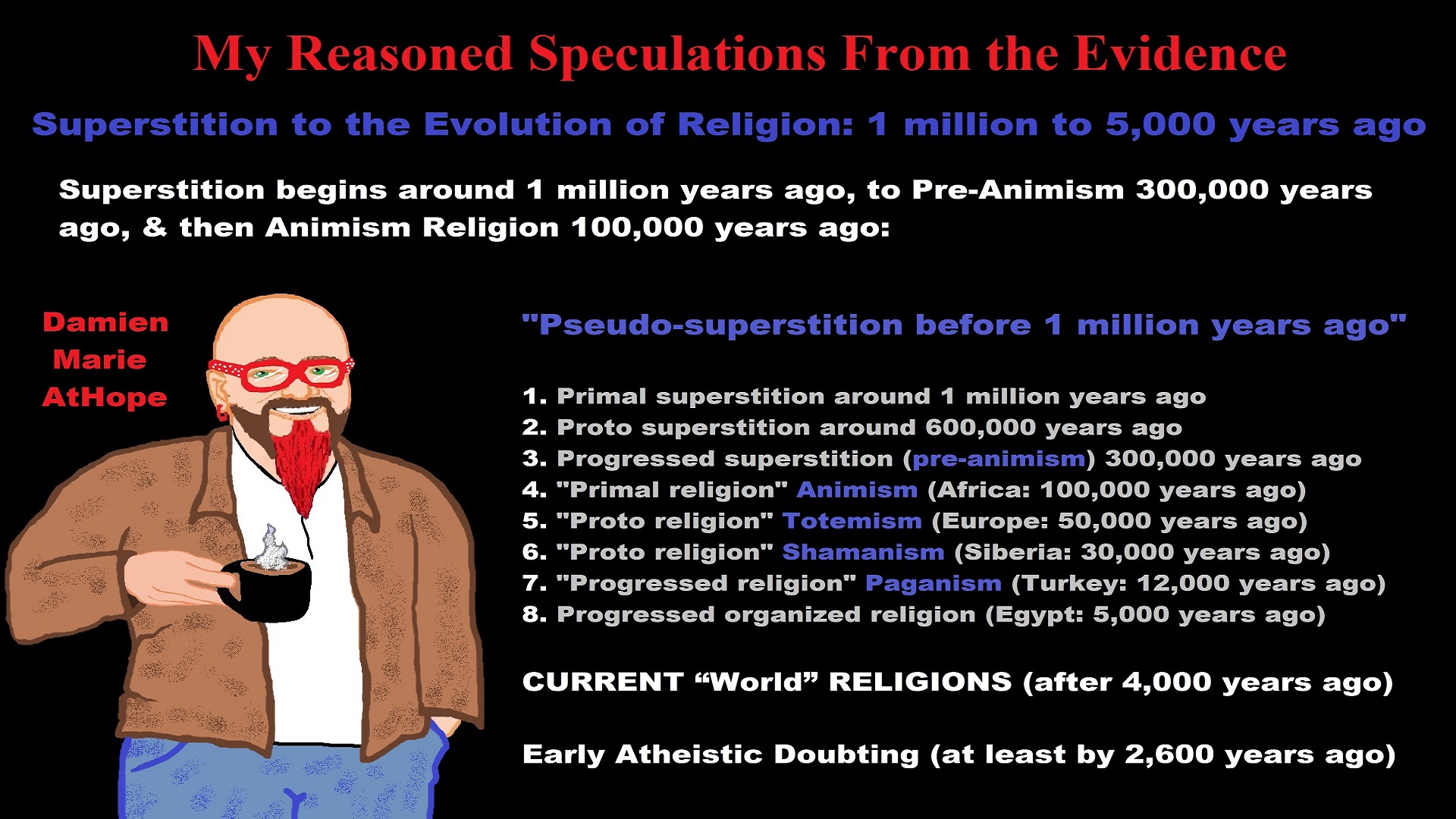
My thoughts on Religion Evolution with external links for more info:
- (Pre-Animism Africa mainly, but also Europe, and Asia at least 300,000 years ago), (Pre-Animism – Oxford Dictionaries)
- (Animism Africa around 100,000 years ago), (Animism – Britannica.com)
- (Totemism Europe around 50,000 years ago), (Totemism – Anthropology)
- (Shamanism Siberia around 30,000 years ago), (Shamanism – Britannica.com)
- (Paganism Turkey around 12,000 years ago), (Paganism – BBC Religion)
- (Progressed Organized Religion “Institutional Religion” Egypt around 5,000 years ago), (Ancient Egyptian Religion – Britannica.com)
- (CURRENT “World” RELIGIONS after 4,000 years ago) (Origin of Major Religions – Sacred Texts)
- (Early Atheistic Doubting at least by 2,600 years ago) (History of Atheism – Wikipedia)
“Religion is an Evolved Product” and Yes, Religion is Like Fear Given Wings…
Atheists talk about gods and religions for the same reason doctors talk about cancer, they are looking for a cure, or a firefighter talks about fires because they burn people and they care to stop them. We atheists too often feel a need to help the victims of mental slavery, held in the bondage that is the false beliefs of gods and the conspiracy theories of reality found in religions.
Understanding Religion Evolution:
- Pre-Animism (at least 300,000 years ago)
- Animism (Africa: 100,000 years ago)
- Totemism (Europe: 50,000 years ago)
- Shamanism (Siberia: 30,000 years ago)
- Paganism (Turkey: 12,000 years ago)
- Progressed organized religion (Egypt: 5,000 years ago), (Egypt, the First Dynasty 5,150 years ago)
- CURRENT “World” RELIGIONS (after 4,000 years ago)
- Early Atheistic Doubting (at least by 2,600 years ago)
“An Archaeological/Anthropological Understanding of Religion Evolution”
It seems ancient peoples had to survived amazing threats in a “dangerous universe (by superstition perceived as good and evil),” and human “immorality or imperfection of the soul” which was thought to affect the still living, leading to ancestor worship. This ancestor worship presumably led to the belief in supernatural beings, and then some of these were turned into the belief in gods. This feeble myth called gods were just a human conceived “made from nothing into something over and over, changing, again and again, taking on more as they evolve, all the while they are thought to be special,” but it is just supernatural animistic spirit-belief perceived as sacred.
Quick Evolution of Religion?
Pre-Animism (at least 300,000 years ago) pre-religion is a beginning that evolves into later Animism. So, Religion as we think of it, to me, all starts in a general way with Animism (Africa: 100,000 years ago) (theoretical belief in supernatural powers/spirits), then this is physically expressed in or with Totemism (Europe: 50,000 years ago) (theoretical belief in mythical relationship with powers/spirits through a totem item), which then enlists a full-time specific person to do this worship and believed interacting Shamanism (Siberia/Russia: 30,000 years ago) (theoretical belief in access and influence with spirits through ritual), and then there is the further employment of myths and gods added to all the above giving you Paganism (Turkey: 12,000 years ago) (often a lot more nature-based than most current top world religions, thus hinting to their close link to more ancient religious thinking it stems from). My hypothesis is expressed with an explanation of the building of a theatrical house (modern religions development). Progressed organized religion (Egypt: 5,000 years ago) with CURRENT “World” RELIGIONS (after 4,000 years ago).
Historically, in large city-state societies (such as Egypt or Iraq) starting around 5,000 years ago culminated to make religion something kind of new, a sociocultural-governmental-religious monarchy, where all or at least many of the people of such large city-state societies seem familiar with and committed to the existence of “religion” as the integrated life identity package of control dynamics with a fixed closed magical doctrine, but this juggernaut integrated religion identity package of Dogmatic-Propaganda certainly did not exist or if developed to an extent it was highly limited in most smaller prehistoric societies as they seem to lack most of the strong control dynamics with a fixed closed magical doctrine (magical beliefs could be at times be added or removed). Many people just want to see developed religious dynamics everywhere even if it is not. Instead, all that is found is largely fragments until the domestication of religion.
Religions, as we think of them today, are a new fad, even if they go back to around 6,000 years in the timeline of human existence, this amounts to almost nothing when seen in the long slow evolution of religion at least around 70,000 years ago with one of the oldest ritual worship. Stone Snake of South Africa: “first human worship” 70,000 years ago. This message of how religion and gods among them are clearly a man-made thing that was developed slowly as it was invented and then implemented peace by peace discrediting them all. Which seems to be a simple point some are just not grasping how devastating to any claims of truth when we can see the lie clearly in the archeological sites.
I wish people fought as hard for the actual values as they fight for the group/clan names political or otherwise they think support values. Every amount spent on war is theft to children in need of food or the homeless kept from shelter.
Here are several of my blog posts on history:
- To Find Truth You Must First Look
- (Magdalenian/Iberomaurusian) Connections to the First Paganists of the early Neolithic Near East Dating from around 17,000 to 12,000 Years Ago
- Natufians: an Ancient People at the Origins of Agriculture and Sedentary Life
- Possible Clan Leader/Special “MALE” Ancestor Totem Poles At Least 13,500 years ago?
- Jewish People with DNA at least 13,200 years old, Judaism, and the Origins of Some of its Ideas
- Baltic Reindeer Hunters: Swiderian, Lyngby, Ahrensburgian, and Krasnosillya cultures 12,020 to 11,020 years ago are evidence of powerful migratory waves during the last 13,000 years and a genetic link to Saami and the Finno-Ugric peoples.
- The Rise of Inequality: patriarchy and state hierarchy inequality
- Fertile Crescent 12,500 – 9,500 Years Ago: fertility and death cult belief system?
- 12,400 – 11,700 Years Ago – Kortik Tepe (Turkey) Pre/early-Agriculture Cultic Ritualism
- Ritualistic Bird Symbolism at Gobekli Tepe and its “Ancestor Cult”
- Male-Homosexual (female-like) / Trans-woman (female) Seated Figurine from Gobekli Tepe
- Could a 12,000-year-old Bull Geoglyph at Göbekli Tepe relate to older Bull and Female Art 25,000 years ago and Later Goddess and the Bull cults like Catal Huyuk?
- Sedentism and the Creation of goddesses around 12,000 years ago as well as male gods after 7,000 years ago.
- Alcohol, where Agriculture and Religion Become one? Such as Gobekli Tepe’s Ritualistic use of Grain as Food and Ritual Drink
- Neolithic Ritual Sites with T-Pillars and other Cultic Pillars
- Paganism: Goddesses around 12,000 years ago then Male Gods after 7,000 years ago
- First Patriarchy: Split of Women’s Status around 12,000 years ago & First Hierarchy: fall of Women’s Status around 5,000 years ago.
- Natufians: an Ancient People at the Origins of Agriculture and Sedentary Life
- J DNA and the Spread of Agricultural Religion (paganism)
- Paganism: an approximately 12,000-year-old belief system
- Paganism 12,000 years old: related to “Anarchism and Socialism” (Pre-Capitalism)
- Shaman burial in Israel 12,000 years ago and the Shamanism Phenomena
- Need to Mythicized: gods and goddesses
- 12,000 – 7,000 Years Ago – Paleo-Indian Culture (The Americas)
- 12,000 – 2,000 Years Ago – Indigenous-Scandinavians (Nordic)
- Norse did not wear helmets with horns?
- Pre-Pottery Neolithic Skull Cult around 11,500 to 8,400 Years Ago?
- 10,400 – 10,100 Years Ago, in Turkey the Nevail Cori Religious Settlement
- 9,000-6,500 Years Old Submerged Pre-Pottery/Pottery Neolithic Ritual Settlements off Israel’s Coast
- Catal Huyuk “first religious designed city” around 9,500 to 7,700 years ago (Turkey)
- Cultic Hunting at Catal Huyuk “first religious designed city”
- Special Items and Art as well as Special Elite Burials at Catal Huyuk
- New Rituals and Violence with the appearance of Pottery and People?
- Haplogroup N and its related Uralic Languages and Cultures
- Ainu people, Sámi people, Native Americans, the Ancient North Eurasians, and Paganistic-Shamanism with Totemism
- Ideas, Technology and People from Turkey, Europe, to China and Back again 9,000 to 5,000 years ago?
- First Pottery of Europe and the Related Cultures
- 9,000 years old Neolithic Artifacts Judean Desert and Hills Israel
- 9,000-7,000 years-old Sex and Death Rituals: Cult Sites in Israel, Jordan, and the Sinai
- 9,000-8500 year old Horned Female shaman Bad Dürrenberg Germany
- Neolithic Jewelry and the Spread of Farming in Europe Emerging out of West Turkey
- 8,600-year-old Tortoise Shells in Neolithic graves in central China have Early Writing and Shamanism
- Swing of the Mace: the rise of Elite, Forced Authority, and Inequality begin to Emerge 8,500 years ago?
- Migrations and Changing Europeans Beginning around 8,000 Years Ago
- My “Steppe-Anatolian-Kurgan hypothesis” 8,000/7,000 years ago
- Around 8,000-year-old Shared Idea of the Mistress of Animals, “Ritual” Motif
- Pre-Columbian Red-Paint (red ochre) Maritime Archaic Culture 8,000-3,000 years ago
- 7,522-6,522 years ago Linear Pottery culture which I think relates to Arcane Capitalism’s origins
- Arcane Capitalism: Primitive socialism, Primitive capital, Private ownership, Means of production, Market capitalism, Class discrimination, and Petite bourgeoisie (smaller capitalists)
- 7,500-4,750 years old Ritualistic Cucuteni-Trypillian culture of Moldova, Romania, and Ukraine
- Roots of a changing early society 7,200-6,700 years ago Jordan and Israel
- Agriculture religion (Paganism) with farming reached Britain between about 7,000 to 6,500 or so years ago and seemingly expressed in things like Western Europe’s Long Barrows
- My Thoughts on Possible Migrations of “R” DNA and Proto-Indo-European?
- “Millet” Spreading from China 7,022 years ago to Europe and related Language may have Spread with it leading to Proto-Indo-European
- Proto-Indo-European (PIE), ancestor of Indo-European languages: DNA, Society, Language, and Mythology
- The Dnieper–Donets culture and Asian varieties of Millet from China to the Black Sea region of Europe by 7,022 years ago
- Kurgan 6,000 years ago/dolmens 7,000 years ago: funeral, ritual, and other?
- 7,020 to 6,020-year-old Proto-Indo-European Homeland of Urheimat or proposed home of their Language and Religion
- Ancient Megaliths: Kurgan, Ziggurat, Pyramid, Menhir, Trilithon, Dolman, Kromlech, and Kromlech of Trilithons
- The Mytheme of Ancient North Eurasian Sacred-Dog belief and similar motifs are found in Indo-European, Native American, and Siberian comparative mythology
- Elite Power Accumulation: Ancient Trade, Tokens, Writing, Wealth, Merchants, and Priest-Kings
- Sacred Mounds, Mountains, Kurgans, and Pyramids may hold deep connections?
- Between 7,000-5,000 Years ago, rise of unequal hierarchy elite, leading to a “birth of the State” or worship of power, strong new sexism, oppression of non-elites, and the fall of Women’s equal status
- Paganism 7,000-5,000 years old: related to “Anarchism and Socialism” (Capitalism) (World War 0) Elite & their slaves
- Hell and Underworld mythologies starting maybe as far back as 7,000 to 5,000 years ago with the Proto-Indo-Europeans?
- The First Expression of the Male God around 7,000 years ago?
- White (light complexion skin) Bigotry and Sexism started 7,000 years ago?
- Around 7,000-year-old Shared Idea of the Divine Bird (Tutelary and/or Trickster spirit/deity), “Ritual” Motif
- Nekhbet an Ancient Egyptian Vulture Goddess and Tutelary Deity
- 6,720 to 4,920 years old Ritualistic Hongshan Culture of Inner Mongolia with 5,000-year-old Pyramid Mounds and Temples
- First proto-king in the Balkans, Varna culture around 6,500 years ago?
- 6,500–5,800 years ago in Israel Late Chalcolithic (Copper Age) Period in the Southern Levant Seems to Express Northern Levant Migrations, Cultural and Religious Transfer
- KING OF BEASTS: Master of Animals “Ritual” Motif, around 6,000 years old or older…
- Around 6000-year-old Shared Idea of the Solid Wheel & the Spoked Wheel-Shaped Ritual Motif
- “The Ghassulian Star,” a mysterious 6,000-year-old mural from Jordan; a Proto-Star of Ishtar, Star of Inanna or Star of Venus?
- Religious/Ritual Ideas, including goddesses and gods as well as ritual mounds or pyramids from Northeastern Asia at least 6,000 years old, seemingly filtering to Iran, Iraq, the Mediterranean, Europe, Egypt, and the Americas?
- Maykop (5,720–5,020 years ago) Caucasus region Bronze Age culture-related to Copper Age farmers from the south, influenced by the Ubaid period and Leyla-Tepe culture, as well as influencing the Kura-Araxes culture
- 5-600-year-old Tomb, Mummy, and First Bearded Male Figurine in a Grave
- Kura-Araxes Cultural 5,520 to 4,470 years old DNA traces to the Canaanites, Arabs, and Jews
- Minoan/Cretan (Keftiu) Civilization and Religion around 5,520 to 3,120 years ago
- Evolution Of Science at least by 5,500 years ago
- 5,500 Years old birth of the State, the rise of Hierarchy, and the fall of Women’s status
- “Jiroft culture” 5,100 – 4,200 years ago and the History of Iran
- Stonehenge: Paganistic Burial and Astrological Ritual Complex, England (5,100-3,600 years ago)
- Around 5,000-year-old Shared Idea of the “Tree of Life” Ritual Motif
- Complex rituals for elite, seen from China to Egypt, at least by 5,000 years ago
- Around 5,000 years ago: “Birth of the State” where Religion gets Military Power and Influence
- The Center of the World “Axis Mundi” and/or “Sacred Mountains” Mythology Could Relate to the Altai Mountains, Heart of the Steppe
- Progressed organized religion starts, an approximately 5,000-year-old belief system
- China’s Civilization between 5,000-3,000 years ago, was a time of war and class struggle, violent transition from free clans to a Slave or Elite society
- Origin of Logics is Naturalistic Observation at least by around 5,000 years ago.
- Paganism 5,000 years old: progressed organized religion and the state: related to “Anarchism and Socialism” (Kings and the Rise of the State)
- Ziggurats (multi-platform temples: 4,900 years old) to Pyramids (multi-platform tombs: 4,700 years old)
- Did a 4,520–4,420-year-old Volcano In Turkey Inspire the Bible God?
- Finland’s Horned Shaman and Pre-Horned-God at least 4,500 years ago?
- 4,000-year-Old Dolmens in Israel: A Connected Dolmen Religious Phenomenon?
- Creation myths: From chaos, Ex nihilo, Earth-diver, Emergence, World egg, and World parent
- Bronze Age “Ritual” connections of the Bell Beaker culture with the Corded Ware/Single Grave culture, which were related to the Yamnaya culture and Proto-Indo-European Languages/Religions
- Low Gods (Earth/ Tutelary deity), High Gods (Sky/Supreme deity), and Moralistic Gods (Deity enforcement/divine order)
- The exchange of people, ideas, and material-culture including, to me, the new god (Sky Father) and goddess (Earth Mother) religion between the Cucuteni-Trypillians and others which is then spread far and wide
- Koryaks: Indigenous People of the Russian Far East and Big Raven myths also found in Tlingit, Haida, Tsimshian, and other Indigenous People of North America
- 42 Principles Of Maat (Egyptian Goddess of the justice) around 4,400 years ago, 2000 Years Before Ten Commandments
- “Happy Easter” Well Happy Eostre/Ishter
- 4,320-3,820 years old “Shimao” (North China) site with Totemistic-Shamanistic Paganism and a Stepped Pyramid
- 4,250 to 3,400 Year old Stonehenge from Russia: Arkaim?
- 4,100-year-old beaker with medicinal & flowering plants in a grave of a woman in Scotland
- Early European Farmer ancestry, Kelif el Boroud people with the Cardial Ware culture, and the Bell Beaker culture Paganists too, spread into North Africa, then to the Canary Islands off West Africa
- Flood Accounts: Gilgamesh epic (4,100 years ago) Noah in Genesis (2,600 years ago)
- Paganism 4,000 years old: related to “Anarchism and Socialism” (First Moralistic gods, then the Origin time of Monotheism)
- When was the beginning: TIMELINE OF CURRENT RELIGIONS, which start around 4,000 years ago.
- Early Religions Thought to Express Proto-Monotheistic Systems around 4,000 years ago
- Kultepe? An archaeological site with a 4,000 years old women’s rights document.
- Single God Religions (Monotheism) = “Man-o-theism” started around 4,000 years ago with the Great Sky Spirit/God Tiān (天)?
- Confucianism’s Tiān (Shangdi god 4,000 years old): Supernaturalism, Pantheism or Theism?
- Yes, Your Male God is Ridiculous
- Mythology, a Lunar Deity is a Goddess or God of the Moon
- Sacred Land, Hills, and Mountains: Sami Mythology (Paganistic Shamanism)
- Horse Worship/Sacrifice: mythical union of Ruling Elite/Kingship and the Horse
- The Amorite/Amurru people’s God Amurru “Lord of the Steppe”, relates to the Origins of the Bible God?
- Bronze Age Exotic Trade Routes Spread Quite Far as well as Spread Religious Ideas with Them
- Sami and the Northern Indigenous Peoples Landscape, Language, and its Connection to Religion
- Prototype of Ancient Analemmatic Sundials around 3,900-3,150 years ago and a Possible Solar Connection to gods?
- Judaism is around 3,450 or 3,250 years old. (“Paleo-Hebrew” 3,000 years ago and Torah 2,500 years ago)
- The Weakening of Ancient Trade and the Strengthening of Religions around 3000 years ago?
- Are you aware that there are religions that worship women gods, explain now religion tears women down?
- Animistic, Totemistic, and Paganistic Superstition Origins of bible god and the bible’s Religion.
- Myths and Folklore: “Trickster gods and goddesses”
- Jews, Judaism, and the Origins of Some of its Ideas
- An Old Branch of Religion Still Giving Fruit: Sacred Trees
- Dating the BIBLE: naming names and telling times (written less than 3,000 years ago, provable to 2,200 years ago)
- Did a Volcano Inspire the bible god?
- The Amorite/Amurru people’s God Amurru “Lord of the Steppe”, relates to the Origins of the Bible God?
- Dené–Yeniseian language, Old Copper Complex, and Pre-Columbian Mound Builders?
- No “dinosaurs and humans didn’t exist together just because some think they are in the bible itself”
- Sacred Shit and Sacred Animals?
- Everyone Killed in the Bible Flood? “Nephilim” (giants)?
- Hey, Damien dude, I have a question for you regarding “the bible” Exodus.
- Archaeology Disproves the Bible
- Bible Battle, Just More, Bible Babble
- The Jericho Conquest lie?
- Canaanites and Israelites?
- Accurate Account on how did Christianity Began?
- Let’s talk about Christianity.
- So the 10 commandments isn’t anything to go by either right?
- Misinformed christian
- Debunking Jesus?
- Paulism vs Jesus
- Ok, you seem confused so let’s talk about Buddhism.
- Unacknowledged Buddhism: Gods, Savior, Demons, Rebirth, Heavens, Hells, and Terrorism
- His Foolishness The Dalai Lama
- Yin and Yang is sexist with an ORIGIN around 2,300 years ago?
- I Believe Archaeology, not Myths & Why Not, as the Religious Myths Already Violate Reason!
- Archaeological, Scientific, & Philosophic evidence shows the god myth is man-made nonsense.
- Aquatic Ape Theory/Hypothesis? As Always, Just Pseudoscience.
- Ancient Aliens Conspiracy Theorists are Pseudohistorians
- The Pseudohistoric and Pseudoscientific claims about “Bakoni Ruins” of South Africa
- Why do people think Religion is much more than supernaturalism and superstitionism?
- Religion is an Evolved Product
- Was the Value of Ancient Women Different?
- 1000 to 1100 CE, human sacrifice Cahokia Mounds a pre-Columbian Native American site
- Feminist atheists as far back as the 1800s?
- Promoting Religion as Real is Mentally Harmful to a Flourishing Humanity
- Screw All Religions and Their Toxic lies, they are all fraud
- Forget Religions’ Unfounded Myths, I Have Substantiated “Archaeology Facts.”
- Religion Dispersal throughout the World
- I Hate Religion Just as I Hate all Pseudoscience
- Exposing Scientology, Eckankar, Wicca and Other Nonsense?
- Main deity or religious belief systems
- Quit Trying to Invent Your God From the Scraps of Science.
- Archaeological, Scientific, & Philosophic evidence shows the god myth is man-made nonsense.
- Ancient Alien Conspiracy Theorists: Misunderstanding, Rhetoric, Misinformation, Fabrications, and Lies
- Misinformation, Distortion, and Pseudoscience in Talking with a Christian Creationist
- Judging the Lack of Goodness in Gods, Even the Norse God Odin
- Challenging the Belief in God-like Aliens and Gods in General
- A Challenge to Christian use of Torture Devices?
- Yes, Hinduism is a Religion
- Trump is One of the Most Reactionary Forces of Far-right Christian Extremism
- Was the Bull Head a Symbol of God? Yes!
- Primate Death Rituals
- Christian – “God and Christianity are objectively true”
- Australopithecus afarensis Death Ritual?
- You Claim Global Warming is a Hoax?
- Doubter of Science and Defamer of Atheists?
- I think that sounds like the Bible?
- History of the Antifa (“anti-fascist”) Movements
- Indianapolis Anti-Blasphemy Laws #Free Soheil Rally
- Damien, you repeat the golden rule in so many forms then you say religion is dogmatic?
- Science is a Trustable Methodology whereas Faith is not Trustable at all!
- Was I ever a believer, before I was an atheist?
- Atheists rise in reason
- Mistrust of science?
- Open to Talking About the Definition of ‘God’? But first, we address Faith.
- ‘United Monarchy’ full of splendor and power – Saul, David, and Solomon? Most likely not.
- Is there EXODUS ARCHAEOLOGY? The short answer is “no.”
- Lacking Proof of Bigfoots, Unicorns, and Gods is Just a Lack of Research?
- Religion and Politics: Faith Beliefs vs. Rational Thinking
- Hammer of Truth that lying pig RELIGION: challenged by an archaeologist
- “The Hammer of Truth” -ontology question- What do You Mean by That?
- Navigation of a bad argument: Ad Hominem vs. Attack
- Why is it Often Claimed that Gods have a Gender?
- Why are basically all monotheistic religions ones that have a male god?
- Shifting through the Claims in support of Faith
- Dear Mr. AtHope, The 20th Century is an Indictment of Secularism and a Failed Atheist Century
- An Understanding of the Worldwide Statistics and Dynamics of Terrorist Incidents and Suicide Attacks
- Intoxication and Evolution? Addressing and Assessing the “Stoned Ape” or “Drunken Monkey” Theories as Catalysts in Human Evolution
- Sacred Menstrual cloth? Inanna’s knot, Isis knot, and maybe Ma’at’s feather?
- Damien, why don’t the Hebrews accept the bible stories?
- Dealing with a Troll and Arguing Over Word Meaning
- Knowledge without Belief? Justified beliefs or disbeliefs worthy of Knowledge?
- Afrocentrism and African Religions
- Crecganford @crecganford offers history & stories of the people, places, gods, & culture
- Empiricism-Denier?
I am not an academic. I am a revolutionary that teaches in public, in places like social media, and in the streets. I am not a leader by some title given but from my commanding leadership style of simply to start teaching everywhere to everyone, all manner of positive education.


ref, ref, ref, ref, ref, ref, ref, ref, ref, ref, ref, ref, ref, ref, ref, ref, ref, ref, ref, ref, ref
Low Gods “Earth” or Tutelary deity and High Gods “Sky” or Supreme deity
“An Earth goddess is a deification of the Earth. Earth goddesses are often associated with the “chthonic” deities of the underworld. Ki and Ninhursag are Mesopotamian earth goddesses. In Greek mythology, the Earth is personified as Gaia, corresponding to Roman Terra, Indic Prithvi/Bhūmi, etc. traced to an “Earth Mother” complementary to the “Sky Father” in Proto-Indo-European religion. Egyptian mythology exceptionally has a sky goddess and an Earth god.” ref
“A mother goddess is a goddess who represents or is a personification of nature, motherhood, fertility, creation, destruction or who embodies the bounty of the Earth. When equated with the Earth or the natural world, such goddesses are sometimes referred to as Mother Earth or as the Earth Mother. In some religious traditions or movements, Heavenly Mother (also referred to as Mother in Heaven or Sky Mother) is the wife or feminine counterpart of the Sky father or God the Father.” ref
“Any masculine sky god is often also king of the gods, taking the position of patriarch within a pantheon. Such king gods are collectively categorized as “sky father” deities, with a polarity between sky and earth often being expressed by pairing a “sky father” god with an “earth mother” goddess (pairings of a sky mother with an earth father are less frequent). A main sky goddess is often the queen of the gods and may be an air/sky goddess in her own right, though she usually has other functions as well with “sky” not being her main. In antiquity, several sky goddesses in ancient Egypt, Mesopotamia, and the Near East were called Queen of Heaven. Neopagans often apply it with impunity to sky goddesses from other regions who were never associated with the term historically. The sky often has important religious significance. Many religions, both polytheistic and monotheistic, have deities associated with the sky.” ref
“In comparative mythology, sky father is a term for a recurring concept in polytheistic religions of a sky god who is addressed as a “father”, often the father of a pantheon and is often either a reigning or former King of the Gods. The concept of “sky father” may also be taken to include Sun gods with similar characteristics, such as Ra. The concept is complementary to an “earth mother“. “Sky Father” is a direct translation of the Vedic Dyaus Pita, etymologically descended from the same Proto-Indo-European deity name as the Greek Zeûs Pater and Roman Jupiter and Germanic Týr, Tir or Tiwaz, all of which are reflexes of the same Proto-Indo-European deity’s name, *Dyēus Ph₂tḗr. While there are numerous parallels adduced from outside of Indo-European mythology, there are exceptions (e.g. In Egyptian mythology, Nut is the sky mother and Geb is the earth father).” ref
Tutelary deity
“A tutelary (also tutelar) is a deity or spirit who is a guardian, patron, or protector of a particular place, geographic feature, person, lineage, nation, culture, or occupation. The etymology of “tutelary” expresses the concept of safety and thus of guardianship. In late Greek and Roman religion, one type of tutelary deity, the genius, functions as the personal deity or daimon of an individual from birth to death. Another form of personal tutelary spirit is the familiar spirit of European folklore.” ref
“A tutelary (also tutelar) in Korean shamanism, jangseung and sotdae were placed at the edge of villages to frighten off demons. They were also worshiped as deities. Seonangshin is the patron deity of the village in Korean tradition and was believed to embody the Seonangdang. In Philippine animism, Diwata or Lambana are deities or spirits that inhabit sacred places like mountains and mounds and serve as guardians. Such as: Maria Makiling is the deity who guards Mt. Makiling and Maria Cacao and Maria Sinukuan. In Shinto, the spirits, or kami, which give life to human bodies come from nature and return to it after death. Ancestors are therefore themselves tutelaries to be worshiped. And similarly, Native American beliefs such as Tonás, tutelary animal spirit among the Zapotec and Totems, familial or clan spirits among the Ojibwe, can be animals.” ref
“A tutelary (also tutelar) in Austronesian beliefs such as: Atua (gods and spirits of the Polynesian peoples such as the Māori or the Hawaiians), Hanitu (Bunun of Taiwan‘s term for spirit), Hyang (Kawi, Sundanese, Javanese, and Balinese Supreme Being, in ancient Java and Bali mythology and this spiritual entity, can be either divine or ancestral), Kaitiaki (New Zealand Māori term used for the concept of guardianship, for the sky, the sea, and the land), Kawas (mythology) (divided into 6 groups: gods, ancestors, souls of the living, spirits of living things, spirits of lifeless objects, and ghosts), Tiki (Māori mythology, Tiki is the first man created by either Tūmatauenga or Tāne and represents deified ancestors found in most Polynesian cultures). ” ref, ref, ref, ref, ref, ref, ref
Mesopotamian Tutelary Deities can be seen as ones related to City-States
“Historical city-states included Sumerian cities such as Uruk and Ur; Ancient Egyptian city-states, such as Thebes and Memphis; the Phoenician cities (such as Tyre and Sidon); the five Philistine city-states; the Berber city-states of the Garamantes; the city-states of ancient Greece (the poleis such as Athens, Sparta, Thebes, and Corinth); the Roman Republic (which grew from a city-state into a vast empire); the Italian city-states from the Middle Ages to the early modern period, such as Florence, Siena, Ferrara, Milan (which as they grew in power began to dominate neighboring cities) and Genoa and Venice, which became powerful thalassocracies; the Mayan and other cultures of pre-Columbian Mesoamerica (including cities such as Chichen Itza, Tikal, Copán and Monte Albán); the central Asian cities along the Silk Road; the city-states of the Swahili coast; Ragusa; states of the medieval Russian lands such as Novgorod and Pskov; and many others.” ref
“The Uruk period (ca. 4000 to 3100 BCE; also known as Protoliterate period) of Mesopotamia, named after the Sumerian city of Uruk, this period saw the emergence of urban life in Mesopotamia and the Sumerian civilization. City-States like Uruk and others had a patron tutelary City Deity along with a Priest-King.” ref
“Chinese folk religion, both past, and present, includes myriad tutelary deities. Exceptional individuals, highly cultivated sages, and prominent ancestors can be deified and honored after death. Lord Guan is the patron of military personnel and police, while Mazu is the patron of fishermen and sailors. Such as Tu Di Gong (Earth Deity) is the tutelary deity of a locality, and each individual locality has its own Earth Deity and Cheng Huang Gong (City God) is the guardian deity of an individual city, worshipped by local officials and locals since imperial times.” ref
“A tutelary (also tutelar) in Hinduism, personal tutelary deities are known as ishta-devata, while family tutelary deities are known as Kuladevata. Gramadevata are guardian deities of villages. Devas can also be seen as tutelary. Shiva is the patron of yogis and renunciants. City goddesses include: Mumbadevi (Mumbai), Sachchika (Osian); Kuladevis include: Ambika (Porwad), and Mahalakshmi. In NorthEast India Meitei mythology and religion (Sanamahism) of Manipur, there are various types of tutelary deities, among which Lam Lais are the most predominant ones. Tibetan Buddhism has Yidam as a tutelary deity. Dakini is the patron of those who seek knowledge.” ref
“A tutelary (also tutelar) The Greeks also thought deities guarded specific places: for instance, Athena was the patron goddess of the city of Athens. Socrates spoke of hearing the voice of his personal spirit or daimonion:
You have often heard me speak of an oracle or sign which comes to me … . This sign I have had ever since I was a child. The sign is a voice which comes to me and always forbids me to do something which I am going to do, but never commands me to do anything, and this is what stands in the way of my being a politician.” ref
“Tutelary deities who guard and preserve a place or a person are fundamental to ancient Roman religion. The tutelary deity of a man was his Genius, that of a woman her Juno. In the Imperial era, the Genius of the Emperor was a focus of Imperial cult. An emperor might also adopt a major deity as his personal patron or tutelary, as Augustus did Apollo. Precedents for claiming the personal protection of a deity were established in the Republican era, when for instance the Roman dictator Sulla advertised the goddess Victory as his tutelary by holding public games (ludi) in her honor.” ref
“Each town or city had one or more tutelary deities, whose protection was considered particularly vital in time of war and siege. Rome itself was protected by a goddess whose name was to be kept ritually secret on pain of death (for a supposed case, see Quintus Valerius Soranus). The Capitoline Triad of Juno, Jupiter, and Minerva were also tutelaries of Rome. The Italic towns had their own tutelary deities. Juno often had this function, as at the Latin town of Lanuvium and the Etruscan city of Veii, and was often housed in an especially grand temple on the arx (citadel) or other prominent or central location. The tutelary deity of Praeneste was Fortuna, whose oracle was renowned.” ref
“The Roman ritual of evocatio was premised on the belief that a town could be made vulnerable to military defeat if the power of its tutelary deity were diverted outside the city, perhaps by the offer of superior cult at Rome. The depiction of some goddesses such as the Magna Mater (Great Mother, or Cybele) as “tower-crowned” represents their capacity to preserve the city. A town in the provinces might adopt a deity from within the Roman religious sphere to serve as its guardian, or syncretize its own tutelary with such; for instance, a community within the civitas of the Remi in Gaul adopted Apollo as its tutelary, and at the capital of the Remi (present-day Rheims), the tutelary was Mars Camulus.” ref
Household deity (a kind of or related to a Tutelary deity)
“A household deity is a deity or spirit that protects the home, looking after the entire household or certain key members. It has been a common belief in paganism as well as in folklore across many parts of the world. Household deities fit into two types; firstly, a specific deity – typically a goddess – often referred to as a hearth goddess or domestic goddess who is associated with the home and hearth, such as the ancient Greek Hestia.” ref
“The second type of household deities are those that are not one singular deity, but a type, or species of animistic deity, who usually have lesser powers than major deities. This type was common in the religions of antiquity, such as the Lares of ancient Roman religion, the Gashin of Korean shamanism, and Cofgodas of Anglo-Saxon paganism. These survived Christianisation as fairy-like creatures existing in folklore, such as the Anglo-Scottish Brownie and Slavic Domovoy.” ref
“Household deities were usually worshipped not in temples but in the home, where they would be represented by small idols (such as the teraphim of the Bible, often translated as “household gods” in Genesis 31:19 for example), amulets, paintings, or reliefs. They could also be found on domestic objects, such as cosmetic articles in the case of Tawaret. The more prosperous houses might have a small shrine to the household god(s); the lararium served this purpose in the case of the Romans. The gods would be treated as members of the family and invited to join in meals, or be given offerings of food and drink.” ref
“In many religions, both ancient and modern, a god would preside over the home. Certain species, or types, of household deities, existed. An example of this was the Roman Lares. Many European cultures retained house spirits into the modern period. Some examples of these include:
- Brownie (Scotland and England) or Hob (England) / Kobold (Germany) / Goblin / Hobgoblin
- Domovoy (Slavic)
- Nisse (Norwegian or Danish) / Tomte (Swedish) / Tonttu (Finnish)
- Húsvættir (Norse)” ref
“Although the cosmic status of household deities was not as lofty as that of the Twelve Olympians or the Aesir, they were also jealous of their dignity and also had to be appeased with shrines and offerings, however humble. Because of their immediacy they had arguably more influence on the day-to-day affairs of men than the remote gods did. Vestiges of their worship persisted long after Christianity and other major religions extirpated nearly every trace of the major pagan pantheons. Elements of the practice can be seen even today, with Christian accretions, where statues to various saints (such as St. Francis) protect gardens and grottos. Even the gargoyles found on older churches, could be viewed as guardians partitioning a sacred space.” ref
“For centuries, Christianity fought a mop-up war against these lingering minor pagan deities, but they proved tenacious. For example, Martin Luther‘s Tischreden have numerous – quite serious – references to dealing with kobolds. Eventually, rationalism and the Industrial Revolution threatened to erase most of these minor deities, until the advent of romantic nationalism rehabilitated them and embellished them into objects of literary curiosity in the 19th century. Since the 20th century this literature has been mined for characters for role-playing games, video games, and other fantasy personae, not infrequently invested with invented traits and hierarchies somewhat different from their mythological and folkloric roots.” ref
“In contradistinction to both Herbert Spencer and Edward Burnett Tylor, who defended theories of animistic origins of ancestor worship, Émile Durkheim saw its origin in totemism. In reality, this distinction is somewhat academic, since totemism may be regarded as a particularized manifestation of animism, and something of a synthesis of the two positions was attempted by Sigmund Freud. In Freud’s Totem and Taboo, both totem and taboo are outward expressions or manifestations of the same psychological tendency, a concept which is complementary to, or which rather reconciles, the apparent conflict. Freud preferred to emphasize the psychoanalytic implications of the reification of metaphysical forces, but with particular emphasis on its familial nature. This emphasis underscores, rather than weakens, the ancestral component.” ref
“William Edward Hearn, a noted classicist, and jurist, traced the origin of domestic deities from the earliest stages as an expression of animism, a belief system thought to have existed also in the neolithic, and the forerunner of Indo-European religion. In his analysis of the Indo-European household, in Chapter II “The House Spirit”, Section 1, he states:
The belief which guided the conduct of our forefathers was … the spirit rule of dead ancestors.” ref
“In Section 2 he proceeds to elaborate:
It is thus certain that the worship of deceased ancestors is a vera causa, and not a mere hypothesis. …
In the other European nations, the Slavs, the Teutons, and the Kelts, the House Spirit appears with no less distinctness. … [T]he existence of that worship does not admit of doubt. … The House Spirits had a multitude of other names which it is needless here to enumerate, but all of which are more or less expressive of their friendly relations with man. … In [England] … [h]e is the Brownie. … In Scotland this same Brownie is well known. He is usually described as attached to particular families, with whom he has been known to reside for centuries, threshing the corn, cleaning the house, and performing similar household tasks. His favorite gratification was milk and honey.” ref
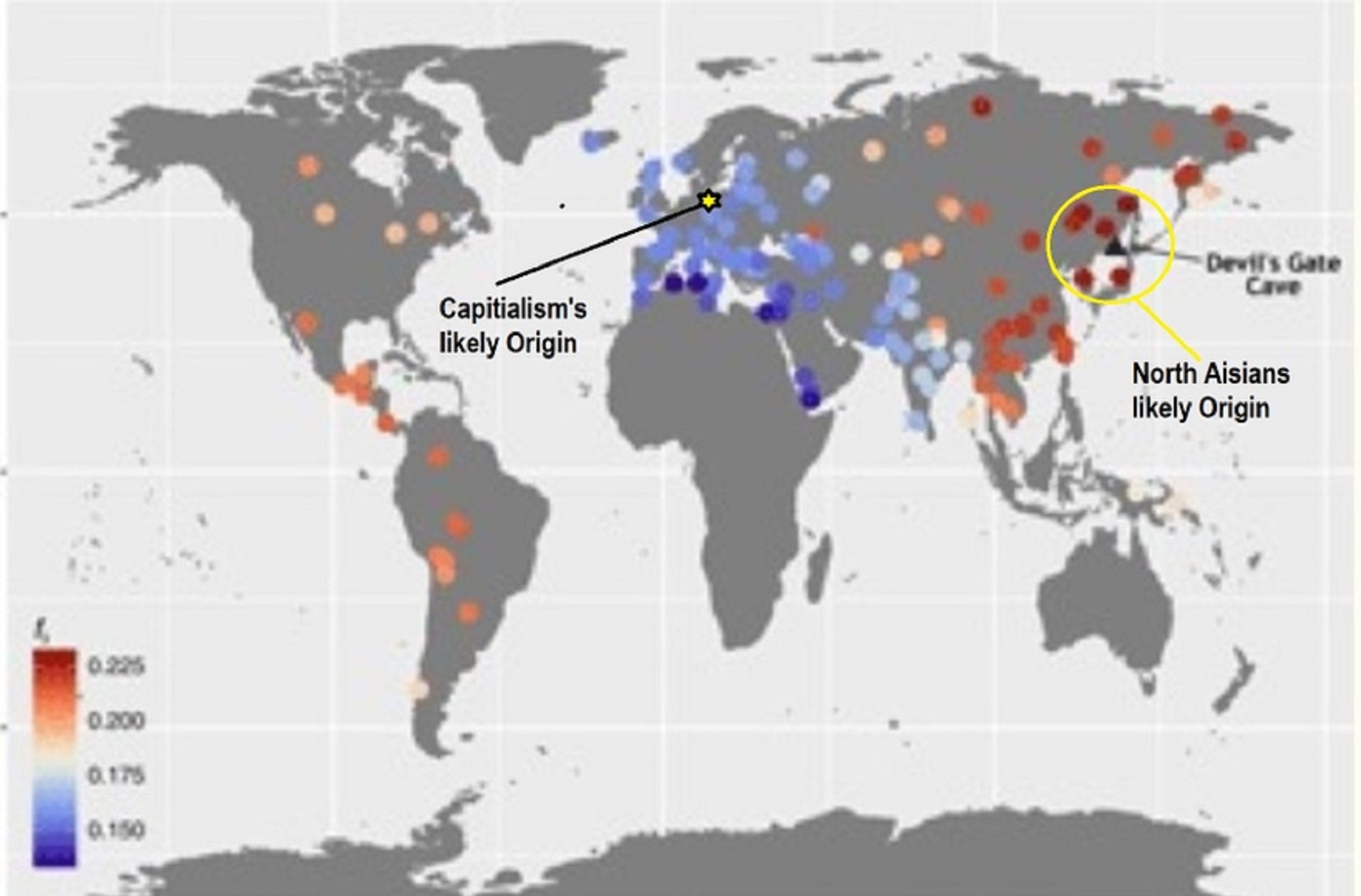
Pic ref
Abstract
“Ancient genomes have revolutionized our understanding of Holocene prehistory and, particularly, the Neolithic transition in western Eurasia. In contrast, East Asia has so far received little attention, despite representing a core region at which the Neolithic transition took place independently ~3 millennia after its onset in the Near East. We report genome-wide data from two hunter-gatherers from Devil’s Gate, an early Neolithic cave site (dated to ~7.7 thousand years ago) located in East Asia, on the border between Russia and Korea. Both of these individuals are genetically most similar to geographically close modern populations from the Amur Basin, all speaking Tungusic languages, and, in particular, to the Ulchi. The similarity to nearby modern populations and the low levels of additional genetic material in the Ulchi imply a high level of genetic continuity in this region during the Holocene, a pattern that markedly contrasts with that reported for Europe.” ref
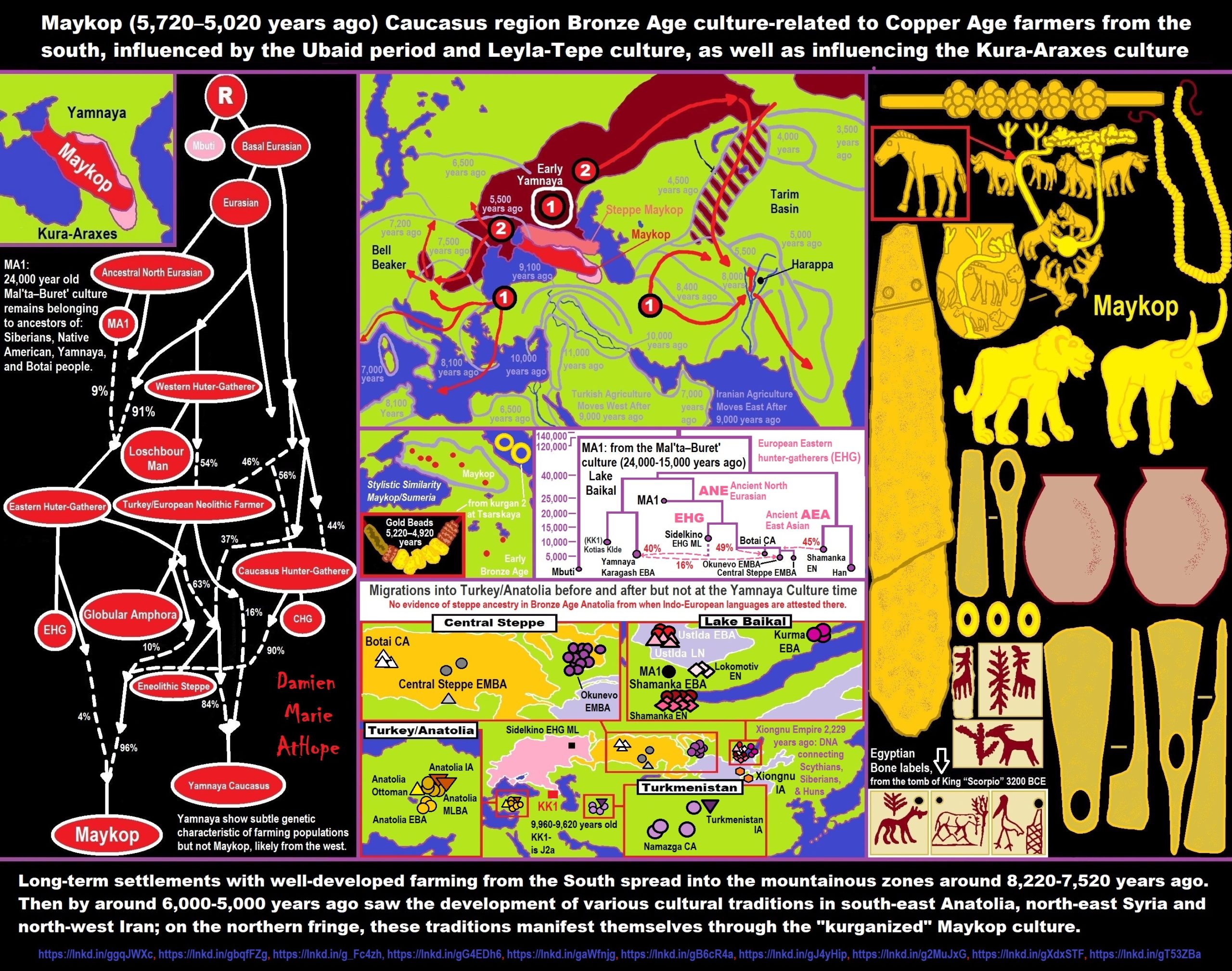
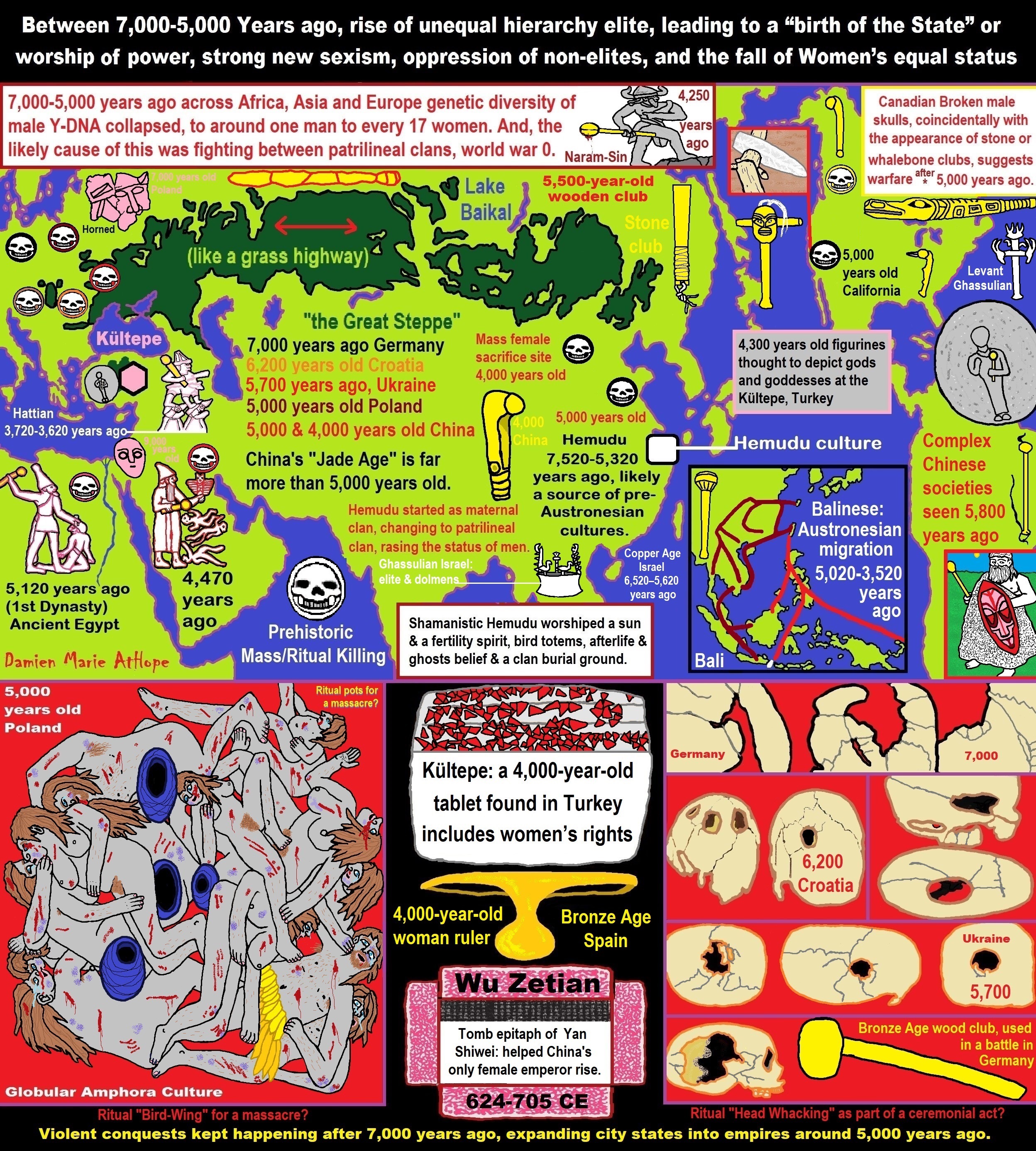
ref, ref, ref, ref, ref, ref, ref, ref, ref, ref, ref, ref, ref, ref, ref, ref, ref, ref, ref, ref, ref, ref, ref, ref, ref, ref, ref, ref, ref, ref, ref, ref, ref, ref, ref, ref, ref, ref, ref, ref, ref, ref, ref, ref, ref, ref, ref, ref, ref, ref, ref, ref, ref, ref, ref, ref, ref, ref, ref, ref, ref, ref, ref, ref, ref, ref, ref, ref, ref, ref, ref, ref, ref, ref, ref, ref, ref, ref, ref, ref, ref, ref, ref, ref, ref, ref, ref, ref, ref, ref

Hinduism around 3,700 to 3,500 years old. ref
Judaism around 3,450 or 3,250 years old. (The first writing in the bible was “Paleo-Hebrew” dated to around 3,000 years ago Khirbet Qeiyafa is the site of an ancient fortress city overlooking the Elah Valley. And many believe the religious Jewish texts were completed around 2,500) ref, ref
Judaism is around 3,450 or 3,250 years old. (“Paleo-Hebrew” 3,000 years ago and Torah 2,500 years ago)
“Judaism is an Abrahamic, its roots as an organized religion in the Middle East during the Bronze Age. Some scholars argue that modern Judaism evolved from Yahwism, the religion of ancient Israel and Judah, by the late 6th century BCE, and is thus considered to be one of the oldest monotheistic religions.” ref
“Yahwism is the name given by modern scholars to the religion of ancient Israel, essentially polytheistic, with a plethora of gods and goddesses. Heading the pantheon was Yahweh, the national god of the Israelite kingdoms of Israel and Judah, with his consort, the goddess Asherah; below them were second-tier gods and goddesses such as Baal, Shamash, Yarikh, Mot, and Astarte, all of whom had their own priests and prophets and numbered royalty among their devotees, and a third and fourth tier of minor divine beings, including the mal’ak, the messengers of the higher gods, who in later times became the angels of Judaism, Christianity and Islam. Yahweh, however, was not the ‘original’ god of Israel “Isra-El”; it is El, the head of the Canaanite pantheon, whose name forms the basis of the name “Israel”, and none of the Old Testament patriarchs, the tribes of Israel, the Judges, or the earliest monarchs, have a Yahwistic theophoric name (i.e., one incorporating the name of Yahweh).” ref
“El is a Northwest Semitic word meaning “god” or “deity“, or referring (as a proper name) to any one of multiple major ancient Near Eastern deities. A rarer form, ‘ila, represents the predicate form in Old Akkadian and in Amorite. The word is derived from the Proto-Semitic *ʔil-, meaning “god”. Specific deities known as ‘El or ‘Il include the supreme god of the ancient Canaanite religion and the supreme god of East Semitic speakers in Mesopotamia’s Early Dynastic Period. ʼĒl is listed at the head of many pantheons. In some Canaanite and Ugaritic sources, ʼĒl played a role as father of the gods, of creation, or both. For example, in the Ugaritic texts, ʾil mlk is understood to mean “ʼĒl the King” but ʾil hd as “the god Hadad“. The Semitic root ʾlh (Arabic ʾilāh, Aramaic ʾAlāh, ʾElāh, Hebrew ʾelōah) may be ʾl with a parasitic h, and ʾl may be an abbreviated form of ʾlh. In Ugaritic the plural form meaning “gods” is ʾilhm, equivalent to Hebrew ʾelōhîm “powers”. In the Hebrew texts this word is interpreted as being semantically singular for “god” by biblical commentators. However the documentary hypothesis for the Old Testament (corresponds to the Jewish Torah) developed originally in the 1870s, identifies these that different authors – the Jahwist, Elohist, Deuteronomist, and the Priestly source – were responsible for editing stories from a polytheistic religion into those of a monotheistic religion. Inconsistencies that arise between monotheism and polytheism in the texts are reflective of this hypothesis.” ref
Jainism around 2,599 – 2,527 years old. ref
Confucianism around 2,600 – 2,551 years old. ref
Buddhism around 2,563/2,480 – 2,483/2,400 years old. ref
Christianity around 2,o00 years old. ref
Shinto around 1,305 years old. ref
Islam around 1407–1385 years old. ref

Knowledge to Ponder:
Stars/Astrology:
- Possibly, around 30,000 years ago (in simpler form) to 6,000 years ago, Stars/Astrology are connected to Ancestors, Spirit Animals, and Deities.
- The star also seems to be a possible proto-star for Star of Ishtar, Star of Inanna, or Star of Venus.
- Around 7,000 to 6,000 years ago, Star Constellations/Astrology have connections to the “Kurgan phenomenon” of below-ground “mound” stone/wood burial structures and “Dolmen phenomenon” of above-ground stone burial structures.
- Around 6,500–5,800 years ago, The Northern Levant migrations into Jordon and Israel in the Southern Levant brought new cultural and religious transfer from Turkey and Iran.
- “The Ghassulian Star,” a mysterious 6,000-year-old mural from Jordan may have connections to the European paganstic kurgan/dolmens phenomenon.
“Astrology is a range of divinatory practices, recognized as pseudoscientific since the 18th century, that claim to discern information about human affairs and terrestrial events by studying the apparent positions of celestial objects. Different cultures have employed forms of astrology since at least the 2nd millennium BCE, these practices having originated in calendrical systems used to predict seasonal shifts and to interpret celestial cycles as signs of divine communications. Most, if not all, cultures have attached importance to what they observed in the sky, and some—such as the Hindus, Chinese, and the Maya—developed elaborate systems for predicting terrestrial events from celestial observations. Western astrology, one of the oldest astrological systems still in use, can trace its roots to 19th–17th century BCE Mesopotamia, from where it spread to Ancient Greece, Rome, the Islamicate world and eventually Central and Western Europe. Contemporary Western astrology is often associated with systems of horoscopes that purport to explain aspects of a person’s personality and predict significant events in their lives based on the positions of celestial objects; the majority of professional astrologers rely on such systems.” ref
Around 5,500 years ago, Science evolves, The first evidence of science was 5,500 years ago and was demonstrated by a body of empirical, theoretical, and practical knowledge about the natural world. ref
Around 5,000 years ago, Origin of Logics is a Naturalistic Observation (principles of valid reasoning, inference, & demonstration) ref
Around 4,150 to 4,000 years ago: The earliest surviving versions of the Sumerian Epic of Gilgamesh, which was originally titled “He who Saw the Deep” (Sha naqba īmuru) or “Surpassing All Other Kings” (Shūtur eli sharrī) were written. ref
Hinduism:
- 3,700 years ago or so, the oldest of the Hindu Vedas (scriptures), the Rig Veda was composed.
- 3,500 years ago or so, the Vedic Age began in India after the collapse of the Indus Valley Civilization.
Judaism:
- around 3,000 years ago, the first writing in the bible was “Paleo-Hebrew”
- around 2,500 years ago, many believe the religious Jewish texts were completed
Myths: The bible inspired religion is not just one religion or one myth but a grouping of several religions and myths
- Around 3,450 or 3,250 years ago, according to legend, is the traditionally accepted period in which the Israelite lawgiver, Moses, provided the Ten Commandments.
- Around 2,500 to 2,400 years ago, a collection of ancient religious writings by the Israelites based primarily upon the Hebrew Bible, Tanakh, or Old Testament is the first part of Christianity’s bible.
- Around 2,400 years ago, the most accepted hypothesis is that the canon was formed in stages, first the Pentateuch (Torah).
- Around 2,140 to 2,116 years ago, the Prophets was written during the Hasmonean dynasty, and finally the remaining books.
- Christians traditionally divide the Old Testament into four sections:
- The first five books or Pentateuch (Torah).
- The proposed history books telling the history of the Israelites from their conquest of Canaan to their defeat and exile in Babylon.
- The poetic and proposed “Wisdom books” dealing, in various forms, with questions of good and evil in the world.
- The books of the biblical prophets, warning of the consequences of turning away from God:
- Henotheism:
- Exodus 20:23 “You shall not make other gods besides Me (not saying there are no other gods just not to worship them); gods of silver or gods of gold, you shall not make for yourselves.”
- Polytheism:
- Judges 10:6 “Then the sons of Israel again did evil in the sight of the LORD, served the Baals and the Ashtaroth, the gods of Aram, the gods of Sidon, the gods of Moab, the gods of the sons of Ammon, and the gods of the Philistines; thus they forsook the LORD and did not serve Him.”
- 1 Corinthians 8:5 “For even if there are so-called gods whether in heaven or on earth, as indeed there are many gods and many lords.”
- Monotheism:
- Isaiah 43:10 “You are my witnesses,” declares the LORD, “and my servant whom I have chosen, so that you may know and believe me and understand that I am he. Before me no god was formed, nor will there be one after me.
Around 2,570 to 2,270 Years Ago, there is a confirmation of atheistic doubting as well as atheistic thinking, mainly by Greek philosophers. However, doubting gods is likely as old as the invention of gods and should destroy the thinking that belief in god(s) is the “default belief”. The Greek word is apistos (a “not” and pistos “faithful,”), thus not faithful or faithless because one is unpersuaded and unconvinced by a god(s) claim. Short Definition: unbelieving, unbeliever, or unbelief.

Expressions of Atheistic Thinking:
- Around 2,600 years ago, Ajita Kesakambali, ancient Indian philosopher, who is the first known proponent of Indian materialism. ref
- Around 2,535 to 2,475 years ago, Heraclitus, Greek pre-Socratic philosopher, a native of the Greek city Ephesus, Ionia, on the coast of Anatolia, also known as Asia Minor or modern Turkey. ref
- Around 2,500 to 2,400 years ago, according to The Story of Civilization book series certain African pygmy tribes have no identifiable gods, spirits, or religious beliefs or rituals, and even what burials accrue are without ceremony. ref
- Around 2,490 to 2,430 years ago, Empedocles, Greek pre-Socratic philosopher and a citizen of Agrigentum, a Greek city in Sicily. ref
- Around 2,460 to 2,370 years ago, Democritus, Greek pre-Socratic philosopher considered to be the “father of modern science” possibly had some disbelief amounting to atheism. ref
- Around 2,399 years ago or so, Socrates, a famous Greek philosopher was tried for sinfulness by teaching doubt of state gods. ref
- Around 2,341 to 2,270 years ago, Epicurus, a Greek philosopher known for composing atheistic critics and famously stated, “Is God willing to prevent evil, but not able? Then he is not omnipotent. Is he able, but not willing? Then he is malevolent. Is he both able and willing? Then whence cometh evil? Is he neither able nor willing? Then why call him god?” ref
This last expression by Epicurus, seems to be an expression of Axiological Atheism. To understand and utilize value or actually possess “Value Conscious/Consciousness” to both give a strong moral “axiological” argument (the problem of evil) as well as use it to fortify humanism and positive ethical persuasion of human helping and care responsibilities. Because value-blindness gives rise to sociopathic/psychopathic evil.
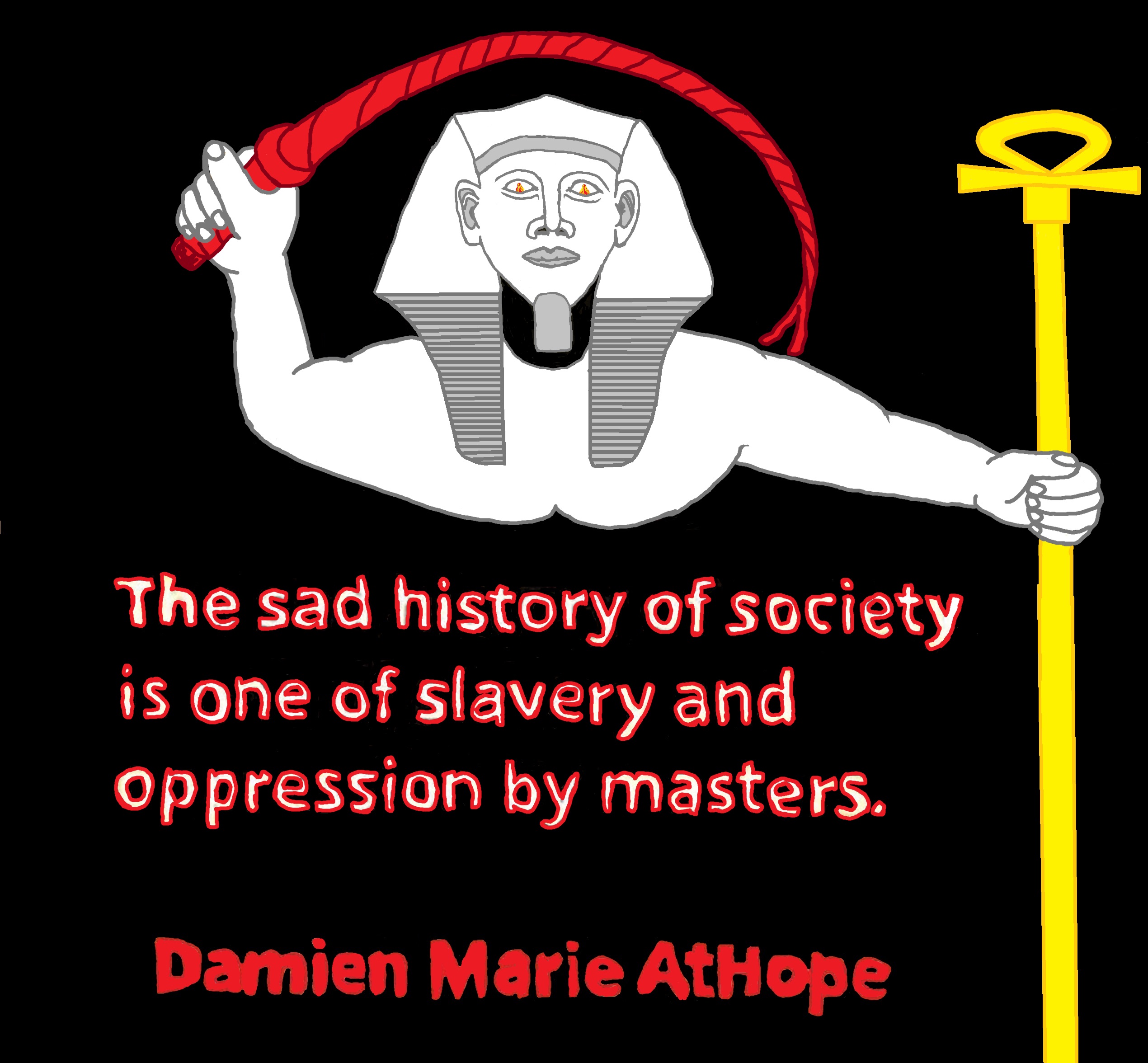
Did a 4,520–4,420-year-old Volcano In Turkey Inspire the Bible God?
The First Expression of the Male God around 7,000 years ago?
A First Male expression of a god?
I think so, and we see a lowering of the goddess that came before, as I believe, he now sits on her old birthing stool of power (sacred throne). To me, this represents the male and female duality and the first possible god sitting on a birthing stool to signify the male on the throne previously reserved only for women. I think the bent arms of both may possibly signify metaphoric “Bull Horns.” Part of the Hamangia culture (Romania and Bulgaria) between the Danube and the Black Sea and Muntenia in the south.
- (Magdalenian/Iberomaurusian) Connections to the First Paganists of the early Neolithic Near East
- Paganism: Goddesses around 12,000 years ago then Male Gods after 7,000 years ago
The Hamangia culture began around 7,250-7,200 years ago and lasted until around 6,550-6,500 years ago It was absorbed by the expanding Boian culture in its transition towards the Gumelnitsa. Its cultural links with Anatolia suggest that it was the result of a settlement by people from Anatolia, unlike the neighboring cultures, which appear descended from an earlier Neolithic settlement. ref
Goddess relating to the three realms: heaven, earth, and the underworld.
I surmise that there is an expression in goddess representation that relates to the three realms sky goddess with the upturned arms relating to the waxing crescent, the fat sitting goddess is a representation to the full moon and the arms turned down are a representation of the waning crescent. And it this way both up and down arms represent metaphorical bullhorns and why goddesses are associated with bulls or as bulls. Especially, with paganism.
My Thought on the Evolution of God?
Animal protector deities from old totems/spirit animal beliefs come first to me, 13,000/12,000 years ago, then women as deities 11,000/10,000 years ago, then male gods around 7,000/8,000 years ago. Then Moralistic gods around 5,000/4,000 years ago.
Several Kemetuic statuettes of goddesses with vulture-shaped heads and upraised arms are known from around 6,200-5,400 years ago. Ancient ivory amulet of a bearded man “phallus” from the Gerzeh culture. ref
The Colossus of Min Dynasty 0 (around 5,300 years ago). This big statue (in brown) is one of a pair found in the re-mains of the temple in Coptos in Upper Egypt. ref
Nagada, also known as Naqada, is the type site of the prehistoric Egyptian Amratian culture (“Naqada I”), Gerzeh culture (“Naqada II”), and Naqada III (“Dynasty 0”) predynastic cultures. Naqada existed before and during the union of Upper Egypt and Lower Egypt, the Naqada III or “protodynastic” period. The process of unification apparently started from Nagada. ref
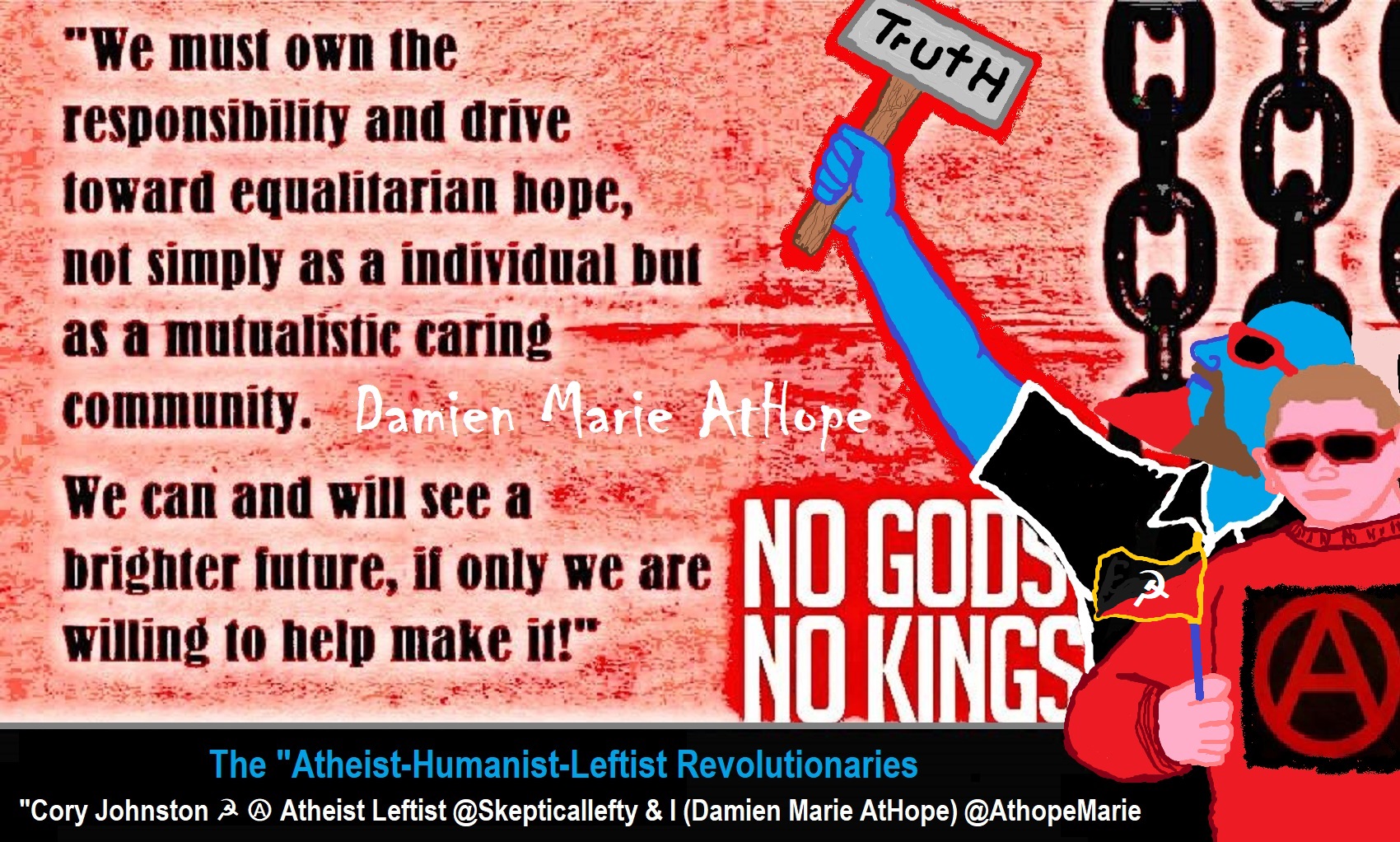
While hallucinogens are associated with shamanism, it is alcohol that is associated with paganism.
The Atheist-Humanist-Leftist Revolutionaries Shows in the prehistory series:
Show two: Pre-animism 300,000 years old and animism 100,000 years old: related to “Anarchism and Socialism”
Show tree: Totemism 50,000 years old: related to “Anarchism and Socialism”
Show four: Shamanism 30,000 years old: related to “Anarchism and Socialism”
Show five: Paganism 12,000 years old: related to “Anarchism and Socialism”
Show six: Emergence of hierarchy, sexism, slavery, and the new male god dominance: Paganism 7,000-5,000 years old: related to “Anarchism and Socialism” (Capitalism) (World War 0) Elite and their slaves!
Prehistory: related to “Anarchism and Socialism” the division of labor, power, rights, and recourses: VIDEO
Pre-animism 300,000 years old and animism 100,000 years old: related to “Anarchism and Socialism”: VIDEO
Totemism 50,000 years old: related to “Anarchism and Socialism”: VIDEO
Shamanism 30,000 years old: related to “Anarchism and Socialism”: VIDEO
Paganism 12,000 years old: related to “Anarchism and Socialism” (Pre-Capitalism): VIDEO
Paganism 7,000-5,000 years old: related to “Anarchism and Socialism” (Capitalism) (World War 0) Elite and their slaves: VIEDO
Paganism 5,000 years old: progressed organized religion and the state: related to “Anarchism and Socialism” (Kings and the Rise of the State): VIEDO
Paganism 4,000 years old: related to “Anarchism and Socialism” (First Moralistic gods, then the Origin time of Monotheism): VIEDO
I do not hate simply because I challenge and expose myths or lies any more than others being thought of as loving simply because of the protection and hiding from challenge their favored myths or lies.
The truth is best championed in the sunlight of challenge.
An archaeologist once said to me “Damien religion and culture are very different”
My response, So are you saying that was always that way, such as would you say Native Americans’ cultures are separate from their religions? And do you think it always was the way you believe?
I had said that religion was a cultural product. That is still how I see it and there are other archaeologists that think close to me as well. Gods too are the myths of cultures that did not understand science or the world around them, seeing magic/supernatural everywhere.
I personally think there is a goddess and not enough evidence to support a male god at Çatalhöyük but if there was both a male and female god and goddess then I know the kind of gods they were like Proto-Indo-European mythology.
This series idea was addressed in, Anarchist Teaching as Free Public Education or Free Education in the Public: VIDEO
Our 12 video series: Organized Oppression: Mesopotamian State Force and the Politics of power (9,000-4,000 years ago), is adapted from: The Complete and Concise History of the Sumerians and Early Bronze Age Mesopotamia (7000-2000 BC): https://www.youtube.com/watch?v=szFjxmY7jQA by “History with Cy“
Show #1: Mesopotamian State Force and the Politics of Power (Samarra, Halaf, Ubaid)
Show #2: Mesopotamian State Force and the Politics of Power (Eridu “Tell Abu Shahrain”)
Show #3: Mesopotamian State Force and the Politics of Power (Uruk and the First Cities)
Show #4: Mesopotamian State Force and the Politics of Power (First Kings)
Show #5: Mesopotamian State Force and the Politics of Power (Early Dynastic Period)
Show #6: Mesopotamian State Force and the Politics of Power (King/Ruler Lugalzagesi)
Show #7: Mesopotamian State Force and the Politics of Power (Sargon and Akkadian Rule)
Show #9: Mesopotamian State Force and the Politics of Power (Gudea of Lagash and Utu-hegal)
Show #12: Mesopotamian State Force and the Politics of Power (Aftermath and Legacy of Sumer)

The “Atheist-Humanist-Leftist Revolutionaries”
Cory Johnston ☭ Ⓐ Atheist Leftist @Skepticallefty & I (Damien Marie AtHope) @AthopeMarie (my YouTube & related blog) are working jointly in atheist, antitheist, antireligionist, antifascist, anarchist, socialist, and humanist endeavors in our videos together, generally, every other Saturday.
Why Does Power Bring Responsibility?
Think, how often is it the powerless that start wars, oppress others, or commit genocide? So, I guess the question is to us all, to ask, how can power not carry responsibility in a humanity concept? I know I see the deep ethical responsibility that if there is power their must be a humanistic responsibility of ethical and empathic stewardship of that power. Will I be brave enough to be kind? Will I possess enough courage to be compassionate? Will my valor reach its height of empathy? I as everyone, earns our justified respect by our actions, that are good, ethical, just, protecting, and kind. Do I have enough self-respect to put my love for humanity’s flushing, over being brought down by some of its bad actors? May we all be the ones doing good actions in the world, to help human flourishing.
I create the world I want to live in, striving for flourishing. Which is not a place but a positive potential involvement and promotion; a life of humanist goal precision. To master oneself, also means mastering positive prosocial behaviors needed for human flourishing. I may have lost a god myth as an atheist, but I am happy to tell you, my friend, it is exactly because of that, leaving the mental terrorizer, god belief, that I truly regained my connected ethical as well as kind humanity.
Cory and I will talk about prehistory and theism, addressing the relevance to atheism, anarchism, and socialism.
At the same time as the rise of the male god, 7,000 years ago, there was also the very time there was the rise of violence, war, and clans to kingdoms, then empires, then states. It is all connected back to 7,000 years ago, and it moved across the world.
Cory Johnston: https://damienmarieathope.com/2021/04/cory-johnston-mind-of-a-skeptical-leftist/?v=32aec8db952d
The Mind of a Skeptical Leftist (YouTube)
Cory Johnston: Mind of a Skeptical Leftist @Skepticallefty
The Mind of a Skeptical Leftist By Cory Johnston: “Promoting critical thinking, social justice, and left-wing politics by covering current events and talking to a variety of people. Cory Johnston has been thoughtfully talking to people and attempting to promote critical thinking, social justice, and left-wing politics.” http://anchor.fm/skepticalleft
Cory needs our support. We rise by helping each other.
Cory Johnston ☭ Ⓐ @Skepticallefty Evidence-based atheist leftist (he/him) Producer, host, and co-host of 4 podcasts @skeptarchy @skpoliticspod and @AthopeMarie
Damien Marie AtHope (“At Hope”) Axiological Atheist, Anti-theist, Anti-religionist, Secular Humanist. Rationalist, Writer, Artist, Poet, Philosopher, Advocate, Activist, Psychology, and Armchair Archaeology/Anthropology/Historian.
Damien is interested in: Freedom, Liberty, Justice, Equality, Ethics, Humanism, Science, Atheism, Antiteism, Antireligionism, Ignosticism, Left-Libertarianism, Anarchism, Socialism, Mutualism, Axiology, Metaphysics, LGBTQI, Philosophy, Advocacy, Activism, Mental Health, Psychology, Archaeology, Social Work, Sexual Rights, Marriage Rights, Woman’s Rights, Gender Rights, Child Rights, Secular Rights, Race Equality, Ageism/Disability Equality, Etc. And a far-leftist, “Anarcho-Humanist.”
I am not a good fit in the atheist movement that is mostly pro-capitalist, I am anti-capitalist. Mostly pro-skeptic, I am a rationalist not valuing skepticism. Mostly pro-agnostic, I am anti-agnostic. Mostly limited to anti-Abrahamic religions, I am an anti-religionist.
To me, the “male god” seems to have either emerged or become prominent around 7,000 years ago, whereas the now favored monotheism “male god” is more like 4,000 years ago or so. To me, the “female goddess” seems to have either emerged or become prominent around 11,000-10,000 years ago or so, losing the majority of its once prominence around 2,000 years ago due largely to the now favored monotheism “male god” that grow in prominence after 4,000 years ago or so.
My Thought on the Evolution of Gods?
Animal protector deities from old totems/spirit animal beliefs come first to me, 13,000/12,000 years ago, then women as deities 11,000/10,000 years ago, then male gods around 7,000/8,000 years ago. Moralistic gods around 5,000/4,000 years ago, and monotheistic gods around 4,000/3,000 years ago.

Damien Marie AtHope (Said as “At” “Hope”)/(Autodidact Polymath but not good at math):
Axiological Atheist, Anti-theist, Anti-religionist, Secular Humanist, Rationalist, Writer, Artist, Jeweler, Poet, “autodidact” Philosopher, schooled in Psychology, and “autodidact” Armchair Archaeology/Anthropology/Pre-Historian (Knowledgeable in the range of: 1 million to 5,000/4,000 years ago). I am an anarchist socialist politically. Reasons for or Types of Atheism
My Website, My Blog, & Short-writing or Quotes, My YouTube, Twitter: @AthopeMarie, and My Email: damien.marie.athope@gmail.com

